

Star Trek Is Officially Redefining What "Where No One Has Gone Before" Actually Means
- The iconic catchphrase "where no one has gone before" gets an epic new meaning in Star Trek #19, by Jackson Lanzing, Collin Kelly and Megan Levens.
- Captain Sisko and his crew are heading into the Pleroma, Star Trek's newly revealed "realm of the gods," prompting Doctor Crusher to call it "where no one has gone before."
- One of Star Trek's key tenets is that humanity can evolve and transcend, and the journey to the Pleroma is the first step in this quest.
For generations of Star Trek fans, the catchphrase “where no one has gone before” has been an iconic call to adventure, but now it has taken on a whole new meaning. In Star Trek #19, the crew of the Theseus is heading to the Pleroma, a mysterious new realm that promises great adventure–and great peril. As they prepare for the hazardous journey, the franchise’s catchphrase takes on new layers.
Star Trek #19 is written by Jackson Lanzing and Collin Kelly and drawn by Megan Levens. T’Lir, the enigmatic Vulcan, has been revealed to be the last of the Organians and has charged Sisko and company with a new mission: travel to the Pleroma and help fix the damage Kahless has caused. Sisko is wary of the Pleroma, having been forbidden to travel there by the Prophets.
He discusses the impending journey with Doctor Crusher, and she refers to the Pleroma as “where no one has gone before.”
For Over 60 Years, Star Trek's Opening Monologue Has Perfectly Set the Show's Tone
It has undergone several changes over the years.
The catchphrase “where no one has gone before” is one of the most memorable in pop culture. Part of a larger opening monologue, the phrase has undergone a few alterations. When Star Trek premiered in 1966, the line read: “where no man has gone before.” When Star Trek: The Next Generation debuted in 1987, it was updated to the much better and more inclusive “where no one has gone before.” This has since become, with a few exceptions, the standard across the franchise, still recited in both the Abrams Kelvin-timeline movies and Strange New Worlds.
In the pilot episode of Star Trek: Enterprise , it was revealed Zefram Cochrane coined the phrase "where no man has gone before."
Star Trek is a story of exploration and discovery, and this catchphrase perfectly sums up this philosophy. Every week, the crews of the various Star Trek shows encounter bizarre alien life forms and awe-inspiring stellar phenomena. Ships like the Enterprise, Voyager or Discovery expanded the frontiers of knowledge while keeping the galaxy safe. Star Trek’s opening monologs set the tone perfectly for the incredible stories that follow. Now, on the eve of one of the biggest discoveries in galactic history, it is taking on a new meaning.
Star Trek Already Confirmed Its Real Final Frontier (& It's Not Space)
Star trek is about more than just exploring space--it's about exploring the human heart too, the pleroma may hold the key to humanity's evolution.
Yet, Star Trek is more than just stories of the exploration of space, but also expanding the potential of humanity . In addition to featuring a future where strife and war have been eliminated, the franchise has shown humanity has great potential, something Q alluded to in the Star Trek: The Next Generation episode “All Good Things.” Humanity will one day be like gods, and the Theseus’ journey to the Pleroma is the first step along the way. The Pleroma opens new possibilities in the Star Trek franchise, giving new meaning to “where no one has gone before.”
Star Trek #19 is on sale now from IDW Publishing!
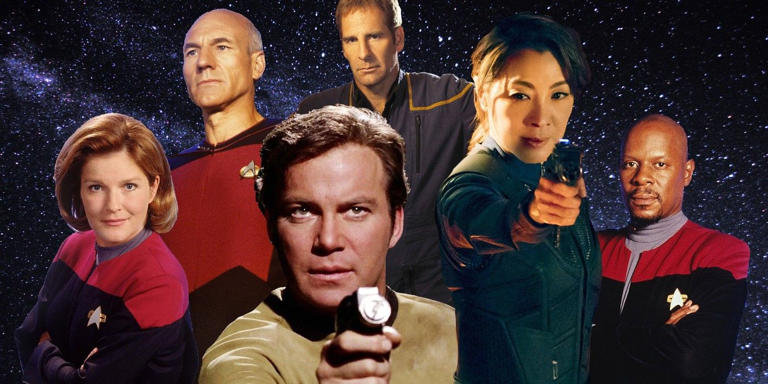
- Cast & crew
- User reviews
Star Trek V: The Final Frontier

Captain Kirk and his crew must deal with Mr. Spock's long-lost half-brother who hijacks the Enterprise for an obsessive search for God at the center of the galaxy. Captain Kirk and his crew must deal with Mr. Spock's long-lost half-brother who hijacks the Enterprise for an obsessive search for God at the center of the galaxy. Captain Kirk and his crew must deal with Mr. Spock's long-lost half-brother who hijacks the Enterprise for an obsessive search for God at the center of the galaxy.
- William Shatner
- Gene Roddenberry
- Harve Bennett
- Leonard Nimoy
- DeForest Kelley
- 382 User reviews
- 86 Critic reviews
- 43 Metascore
- 5 wins & 5 nominations

- St. John Talbot

- Caithlin Dar

- Captain Klaa

- (as Spice Williams)

- "God"
- Young Sarek
- High Priestess

- All cast & crew
- Production, box office & more at IMDbPro
More like this

Did you know
- Trivia During pre-production meetings, screenwriter David Loughery jokingly proposed to have Commander Uhura appear as an erotic dancer in order to lure away the hostage takers from the Paradise compound. He was surprised when the producers approved of the idea right away.
- Goofs When Kirk, Bones and Spock are flying up the turbolift shaft, the deck number gets higher as they go upwards. However Star Trek ships are numbered the opposite way round with the higher decks having lower numbers. For instance, the bridge (at the top of the ship) is on deck 1.
Kirk : Damn it, Bones, you're a doctor. You know that pain and guilt can't be taken away with a wave of a magic wand. They're the things we carry with us, the things that make us who we are. If we lose them, we lose ourselves. I don't want my pain taken away! I need my pain!
- Crazy credits "Highest descender fall recorded in the United States: Ken Bates." (I.e., Kenny Bates .)
- Alternate versions The CBS broadcast premiere removed a number of scenes from the movie. 1) All scenes featuring the dancing triple-breasted catwoman were removed. 2) The campfire scene was trimmed, ending with Spock producing the 'marshmellon' - effectively removing the much criticized 'Row Row Row Your Boat' sing along between Kirk, Spock and McCoy. 3) The scene between Uhura and Scotty on the bridge as they receive new orders from Starfleet Command. 4) The "I could use a shower" scene between Kirk and Spock in the turbolift.
- Connections Featured in Siskel & Ebert: Star Trek V/No Holds Barred/Dead Poets Society/Let's Get Lost/Renegades (1989)
- Soundtracks Fanfare From Star Trek TV Series by Alexander Courage
User reviews 382
- Mar 2, 2022
- How long is Star Trek V: The Final Frontier? Powered by Alexa
- Why was J'Onn digging holes on Numbus 3 at the beginning? Also, what was his pain?
- What was the creature pretending to be "God"?
- What is 'The Final Frontier' about?
- June 9, 1989 (United States)
- United States
- Star Trek: The Final Frontier
- Owens Lake, California, USA (the dry lake bed stood in for the desolate Nimbus III)
- Paramount Pictures
- See more company credits at IMDbPro
- $27,800,000 (estimated)
- $52,210,049
- $17,375,648
- Jun 11, 1989
Technical specs
- Runtime 1 hour 47 minutes
- Dolby Digital
Related news
Contribute to this page.

- See more gaps
- Learn more about contributing
More to explore

Recently viewed
The meaning and origin of the expression: Space: the final frontier
Space: the final frontier
What's the meaning of the phrase 'space, the final frontier'.
- American origin
The first line of the opening voice-over in Star Trek
What's the origin of the phrase 'Space, the final frontier'?

Space: The final frontier These are the voyages of the Starship, Enterprise Its 5 year mission To explore strange new worlds To seek out new life and new civilizations To boldly go where no man has gone before
See also - to boldy go where no man has gone before .

By Gary Martin
Gary Martin is a writer and researcher on the origins of phrases and the creator of the Phrase Finder website. Over the past 26 years more than 700 million of his pages have been downloaded by readers. He is one of the most popular and trusted sources of information on phrases and idioms.


Star Trek V: The Final Frontier
- View history
"The greatest enterprise of all is adventure."
When a renegade Vulcan captures the Federation, Klingon, and Romulan ambassadors on Nimbus III, the so-called "planet of galactic peace," it can only mean one thing: the vacation is over. Captain James T. Kirk and the crew of the new Starship Enterprise -A are pressed back into service to come to the rescue. But, when the Vulcan has a prior association with Spock, it allows him to seize control of the Enterprise and put it on course for the center of the galaxy where he and his followers believe they find the place from which creation sprung.
- 1.1 Prologue
- 1.2 Act One
- 1.3 Act Two
- 1.4 Act Three
- 2 Log entries
- 3 Memorable quotes
- 4.2 Characters
- 4.3 Merchandise gallery
- 5 Awards and honors
- 6 Apocrypha
- 7.1.1 Opening credits
- 7.1.2.1 Live Action Effects Unit
- 7.1.2.2 Model Unit
- 7.1.2.3 Optical Unit
- 7.1.2.4 Additional Optical Effects
- 7.2.1 Starfleet Galactic Memory Bank references
- 7.2.2 Meta references
- 7.2.3 Unreferenced material
- 7.3 Related topics
- 7.5 External links
Summary [ ]
Prologue [ ].

" You're a Vulcan! "
On the desert planet Nimbus III , a scavenger named J'onn is digging holes in a field. He stops digging and sees, emerging from the dust in the distance, a man riding towards him on a horse . Dismounting from the horse, this man has a strange power to cleanse people of their emotional "pain," which he uses to join the scavenger to his cause. " What is it you seek? " he asks. The man tells him he seeks what he seeks, what all men have sought since time itself began – the ultimate knowledge. To find it, he notes, they will need a starship . J'onn mentions that Nimbus III has no such vessels, but the mysterious man reveals he may have a way to bring one to them. When J'onn asks how he plans to accomplish this, the man throws back his hood, showing the scavenger his distinct pointed Vulcan ears . He then begins laughing.
Act One [ ]

Just hanging around
The recently- demoted Captain James T. Kirk is back on Earth , spending his shore leave free climbing El Capitan in Yosemite National Park in North America. Halfway up he is greeted by Spock , who has followed him wearing levitation boots . Dr. McCoy is watching with binoculars from a safe distance while cursing Kirk's "irresponsibility" for climbing the mountain. In a moment of distraction, Kirk falls off of El Capitan. Spock dives after him. After a terrifying moment for the captain, he's snatched from certain death by Spock who catches him by grabbing his ankle only mere centimeters from the ground.
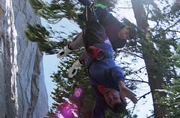
Spock saves Kirk at the last minute
Out in the galaxy , three ambassadors from the United Federation of Planets , Romulan Star Empire , and Klingon Empire meet alone in Paradise City on Nimbus III for a private conference. The young Romulan ambassador, Caithlin Dar , rides into Paradise City on a horse, and expresses optimism in Nimbus III, which had been billed as "The Planet of Galactic Peace" at its founding twenty years before . However, the Human and Klingon ambassadors, St. John Talbot and General Korrd , are much more jaded and cynical, and point out that it has rapidly devolved to a barren wasteland rife with corruption and debauchery. Talbot points out that they had forbade weapons, but the settlers began to fashion their own projectile weapons . Korrd, in particular, is a decorated and respected Klingon general who fell out of favor with the Klingon High Command, and has become a bitter, apathetic drunk.

Dar and Talbot taken hostage
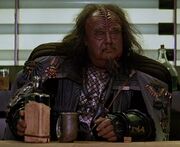
Their meeting is interrupted when the city compound is overrun by fanatical followers of the Vulcan who informs the ambassadors that they are his hostages. Caithlin Dar defiantly tells the Vulcan that she doesn't know who he is or what he wants but assures him that their three respective governments will stop at nothing to ensure their safety. The Vulcan retorts " That's exactly what I'm counting on. "
Sitting in the Spacedock One , undergoing repairs and refits, the new USS Enterprise -A sits lifelessly under the care of Chief Engineer Montgomery Scott , who notes in the shakedown cruise report that the new Enterprise must have been the product of a team of monkeys – while the warp drive is up to Scott's exacting standards, he laments that half the doors on the ship won't open and that it's his responsibility to repair them, among other disabled systems aboard the ship, primary of which is the ship's transporter . As Scott repairs the helm/navigation console on the main bridge , Nyota Uhura arrives from a turbolift with his dinner – understanding that the extensive repair schedule will cancel their shared plans for shore leave. At that moment, the Enterprise 's mangled red alert system goes off and a voice from Starfleet announces to Scott and Uhura that they have a priority 7 situation at the Neutral Zone. Scott is incredulous that Starfleet would assign the mission to the Enterprise considering that the ship is currently "in pieces" and has less than a skeleton crew aboard. Uhura asks Starfleet if they are aware of the Enterprise 's current status. Starfleet acknowledges and tells Uhura to stand by to copy operational orders and to recall all key personnel.

" Admit it – we're lost! "
Uhura contacts Hikaru Sulu and Pavel Chekov , who are lost hiking in the woods. Chekov is grateful that they'll soon be rescued but warns Sulu not to tell Uhura that they got lost after she instructs them to return to a set of prearranged coordinates. Sulu and Chekov try to explain they're caught in a blizzard and can't see which way they're going. Uhura, monitoring the weather on the sensors, reads nothing but sunny skies and 70 degree Fahrenheit weather and assures them she won't tell anyone about their embarrassing situation as she sends a shuttlecraft to pick them up. " Uhura, I owe you one. Sulu out, " the Enterprise 's helmsman says as he flips shut his communicator .
Meanwhile, Kirk, Spock, and McCoy are sitting around the campfire at Yosemite, where the three discuss their time together and philosophize about life and death around a pot of whiskey -spiked baked beans , roasting " marsh melons ," and singing " Row, Row, Row Your Boat ", although Spock cannot grasp the meaning of the words and thus declines to sing along. McCoy admonishes Kirk for risking his life on crazy stunts, such as falling off El Capitan earlier and McCoy wonders if it crossed Kirk's mind that he should have died when he fell off. Kirk admits it did – but, even as he fell, he knew he would not die. Spock does not understand. Kirk says that he knew he'd survive because the two of them were with him – " I've always known… I'll die alone. " After Kirk's revelation, McCoy offers that the three of them spend so much time together in space, getting on each other's nerves, yet spend their shore leave together. Kirk believes that while other people have families, they don't.
Out in space, the long-lost Earth probe Pioneer 10 is intercepted by a Klingon Bird-of-Prey commanded by the young Klingon warrior Klaa , who easily vaporizes the probe with his disruptors . Klaa tires of shooting space garbage, as he believes it is no test of a warrior's mettle, and wishes for a target that will fight back. The Klingons are soon notified about the hostage situation on Nimbus III as well, which piques Klaa's interest as it is obvious that the Federation will send a ship of their own to deal with the situation and sets his course for Nimbus III.

Back in action
Kirk, Spock, and McCoy's leave is interrupted when Uhura takes the Galileo down to their campsite in Yosemite since the Enterprise 's transporters are inoperative, waking up all three men with the Galileo 's bright landing lights . She informs Kirk of important orders from Starfleet Command . Kirk wonders why she didn't contact him via his communicator but she notes he conveniently forgot it. The Galileo eventually arrives in the Enterprise 's shuttlebay and the problems with the starship are immediately obvious to Kirk as the turbolift malfunctions en route to the bridge, a console shorts out and the viewscreen barely works. Chief of Starfleet Operations Fleet Admiral Bob eventually comes through and orders Kirk to Nimbus III and assess the hostage situation. Kirk tries to decline the mission due to the problems plaguing the ship and suggests another vessel nearby handle the situation. The admiral refuses on the grounds that while there may be other ships out there, none of their captains are as experienced as Jim Kirk. With an " oh, please " dismissal on his lips, Kirk signs off and orders the Enterprise to Nimbus III.

Ghost in the machine
Klaa and his crew discover that the Enterprise has been dispatched to Nimbus III as well. Klaa is well familiar with the Enterprise being Kirk's vessel and wonders what defeating Kirk in battle would do for his reputation. His first officer Vixis marvels that destroying the Enterprise and and defeating Kirk would make Klaa the greatest warrior in the galaxy. Klaa, originally hoping for an engagement with just any Federation starship, is now elated at his chance to fight Kirk and the Enterprise and orders maximum speed. The Enterprise , so plagued with technical problems that Kirk can't even record an entry in the captain's log recorder , finally receives a copy of the hostage tape sent from Nimbus III. In the tape, Dar, Talbot, and Korrd plead with the Federation to send a starship to parlay for their release at once, per the instructions of the leader of the Galactic Army of Light , the Vulcan who enters the frame and begins addressing the Federation. He claims to regret his desperate act and has no desire to harm the hostages but will do so if the Federation does not respond immediately. Spock, taken with the Vulcan, calls up a freeze frame of him on his science station 's monitor and regards it intently. Kirk wonders if Spock is familiar with him. Later, Spock is in solitude in the Enterprise 's observation lounge when Kirk and McCoy join him. Spock recounts for Kirk and McCoy a brief history of Sybok , a gifted Vulcan who at a young age broke with tradition and decided that emotion, not logic, was the key to self-knowledge. According to Spock, Sybok was banished from Vulcan when he attempted to lure other Vulcans to his worldview.
Act Two [ ]

" Imagine that, a passionate Vulcan! "
The Enterprise arrives first at Nimbus III. Paradise City demands to know their intentions but Kirk tells Uhura to respond with static and make them think they are having some difficulties – which is not far from the truth. Kirk tries to simply beam the hostages aboard but Scott tells him that the transporter is still inoperative. The captain realizes they'll have to go down and take them out by force. However, Spock detects the Bird-of-Prey entering the area leaving them 1.9 hours before their weapons come to bear. An assault team consisting of Kirk, Spock, McCoy, Sulu, Uhura, and a detail of security personnel head down in the Galileo leaving Chekov in command of the Enterprise . Despite the primitive scanning equipment of the natives of Nimbus III, their sensors are nevertheless effective and it forces the Galileo to land significantly far away from the settlement.
Meanwhile, Chekov hails Paradise City from the Enterprise and poses as the ship's commanding officer with the intention of distracting the enemy from Kirk's actions. The Vulcan responds and is amused by Chekov's posturing, who orders him to release the hostages or suffer the consequences. Chekov, not backing down, informs the Vulcan that a Klingon vessel is on the way. The Vulcan, unmoved, replies that it's likely that they'll be fairly angry. Chekov tries to impress upon him that the Klingons are likely to destroy the whole planet but the Vulcan knows that a Federation starship would not stand idly by and let the Klingons do that. He then instructs Chekov and his first officer to beam down to his coordinates. Chekov tries to stall the Vulcan as Kirk and Spock realize that they don't have enough time to get to Paradise City on foot. The captain notices a stable of horses through his binoculars and has Uhura perform a seductive dance (with a team of armed security guards out of sight) to distract the wranglers while the assault team steals the horses. The ploy works and the assault team rides into Paradise City. Under the cover of nightfall and covered in cloaks, the assault team looks no different than the wranglers. J'onn believes them to be their lookout party and allows them access to Paradise City. However, J'onn soon becomes suspicious as Spock locates the hostages on his tricorder . The Galactic Army of Light begins to open fire on the assault team with their primitive weapons, but they respond with their Starfleet-issue phasers . The Vulcan becomes aware of the commotion outside and Chekov orders him to surrender at once as he is under attack by superior Federation forces. The Vulcan is incensed as bloodshed is the last thing he wanted. Chekov tries to reason with him but he flees. Kirk fights hand to hand with the Galactic Army of Light's warriors and the fight continues. With a clear entrance into the bar where the hostages are being held, Kirk orders Uhura to bring the Galileo down so they can make a quick escape and goes for the captives. After a brief struggle with an exotic alien dancer, Kirk and Spock free the hostages. However, Korrd and Dar turn their weapons on them and hold Kirk and Spock hostage instead.

Outside the bar, the Galactic Army of Light has also captured the Galileo , Uhura, Sulu, McCoy, and the rest of the security detail. As they loudly cheer their victory, the Vulcan suddenly recognizes Spock among the group and joyfully reveals that he is, in fact, Sybok. However, Spock is not cheered by the apparent reunion and informs Sybok that he is under arrest for seventeen violations of the Neutral Zone Treaty . Sybok and the others laugh at the notion – they clearly have the Enterprise team outnumbered. Spock offers Sybok leniency if he surrenders, but Sybok jovially announces he can't surrender as he isn't through violating the treaty and intends for his next crime to be the theft of something " very big " – the Enterprise herself. Kirk finally speaks up and indignantly inquires if Sybok has staged this entire affair just to get his hands on his ship. Sybok, equally indignantly, wonders who Kirk even is. He clarifies that he is the captain of the Enterprise . Sybok realizes that Chekov had been deceiving him and applauds Kirk's clever tactics but moves on and asks Spock if he would like to join him. Kirk is also curious as to what Spock will say but Spock simply states that he is a Starfleet officer. Sybok understands and states he will just take the Enterprise without Spock's help.
Unaware of the serious situation on the planet's surface, Chekov and Scott are faced with another serious situation – the Klingon vessel is closing on their position. Klaa orders their cloaking device engaged in preparation for their attack on the Enterprise . Scott notes the loss of the Bird-of-Prey on sensors and deduces they must have cloaked. Chekov, knowing his first responsibility is to the ship, orders Scott to raise shields . Scott protests that the shuttlecraft is coming up from the surface but Chekov firmly repeats his order and follows it up with an order to go to red alert . Scott obliges and the Enterprise prepares for battle. The Galileo approaches the Enterprise and while Kirk retains his command of his officers, Sybok and his followers have them all under their command. Talbot informs them that once they have seized control of the Enterprise , they will bring up the rest of the Galactic Army of Light. Kirk, in an untenable position, laments that with the Klingons on their way, they will be lucky to even get back to the ship at all.

" Stand by to execute Emergency Landing Plan… B. "
Chekov hails the Galileo , informs them of the situation and recommends they find a safe harbor until the situation is secured. However, Sybok refuses and orders Kirk to bring them aboard. Kirk desperately tries to explain to Sybok that in order to dock the Galileo , the Enterprise will be vulnerable to a Klingon attack as her shields must be down for at least fifteen seconds to enter the shuttlebay. Korrd tells Sybok that Kirk is speaking the truth but Sybok refuses to return to Nimbus III. He allows Kirk to take whatever action is necessary in order to get the Galileo aboard. Kirk tells Chekov that they cannot return to the planet and cryptically tells him to stand by in executing "Emergency Landing Plan B." Chekov and Scott have no idea what Kirk is talking about but get the general idea when Kirk says that "B" stands for "barricade." Kirk intends to forgo the tractor beam and fly the shuttlecraft in manually in order to minimize the time the Enterprise 's shields will be down. Klaa, meanwhile, has been monitoring the communications channel and realizes that Kirk is on the shuttle and alters his attack course to bear down on the Galileo . The Enterprise lowers her shields just as the Bird-of-Prey decloaks. Sulu engages the shuttle's thrusters and makes a hasty course for the shuttlebay. With no tractor beam, the shuttlecraft blasts into the bay, throwing its occupants to the deck and knocking out its systems. The barricade in the shuttlebay flies up to contain the craft before it crashes through the wall and decompresses additional compartments of the ship. The Bird-of-Prey fires at the Enterprise , but Chekov orders immediate warp speed and she streaks away just as the torpedo misses. Klaa is enraged but impressed at Kirk's cunning and orders his officers to track the Enterprise 's course.

" Warp speed now! "
In the Galileo , the Starfleet officers and the outlaws are in various states of unconsciousness from the crash. Sybok recovers as Kirk does and both note a projectile weapon on the deck. They struggle for it but Sybok gets the upper hand and orders Kirk to change course at once. The captain agrees to take Sybok to the bridge but tries to get the weapon away from Sybok as they disembark from the shuttle. The Vulcan easily outmatches Kirk in physical strength and grabs him in a choke hold. Kirk is able to get the weapon away from him and it slides across the deck to the feet of Spock, who picks it up and orders Sybok to surrender. Sybok refuses and bluntly tells Spock he must kill him. Kirk bellows for Spock to " SHOOT HIM! " but Spock cannot and the weapon is confiscated by Sybok, who is relieved as he thought Spock might have actually done it. J'onn takes an injured Dr. McCoy and Kirk to the brig as Sybok asks Spock to accompany him to the bridge but again Spock refuses. Sybok tells him he has no choice but to join his friends in confinement. Korrd, Dar, and Talbot escort Sulu and Uhura out of the Galileo as Sybok requests a moment alone with them in order to release their pain as he had done to the others. From the observation deck , a disturbed Scott watches as the Galactic Army of Light pour out of the Galileo and out to the rest of the ship and goes into hiding.
In the brig, Kirk is cursing Spock for betraying the entire crew. Spock says it's worse than that – he's betrayed Kirk and does not expect the captain to forgive him. Kirk simply cannot believe it – why wouldn't Spock defend his ship and follow orders and just pull the trigger on the weapon he had on Sybok? Spock claims he could not because Kirk ordered him to kill his brother. Kirk is incredulous and claims he knows for a fact that Spock does not have a brother. Spock agrees that Kirk is technically correct – he has a half -brother . Dr. McCoy tries to make sense of it all – that Spock and Sybok have the same father but different mothers. Spock says that Sybok's mother was a Vulcan princess and upon her death, Sybok and he were raised as brothers. Kirk can't believe Spock never mentioned any of this to them before and Spock apologizes for it. Kirk is fuming but McCoy tells him to stop berating Spock as he could no more kill Sybok than he could kill Kirk. More to the point, they have bigger problems to deal with like escaping from the brig. " I'll say one thing, Spock. You never cease to amaze me, " McCoy says. " Nor I myself, " Spock responds. Kirk, sitting on the brig's toilet , shakes his head.

Sybok assumes command
On the bridge, Sulu and Uhura enter with several of Sybok's followers. Chekov wonders where Kirk is but Uhura tells him not to worry about it – Sybok will explain everything. As Sybok's followers begin to take up positions on the bridge, Sulu begins entering commands into the navigation console. Chekov demands to know what he's doing and Sulu answers that he is plotting their new course. Chekov is incredulous as Sulu has no authority to take that action. Sybok arrives on the bridge as Chekov demands an explanation. All Sulu will say is that Chekov simply has to listen to Sybok. The Vulcan tells Chekov that he won't force him into anything but encourages him to share his pain with Sybok as all the others have and gain strength from it. As a result, Chekov can't help but be taken into Sybok's cause like the rest. In the brig, several efforts to escape prove fruitless as Spock has personally tested the new design of the brig and found it to be "escape-proof." Back on the bridge, Sybok has fully assumed command of the Enterprise as they proceed on their new course at warp 7. As they are now underway, Sybok announces his intentions to the rest of the ship. Via the ship's intercom and computer terminals, Sybok asks the crew of the Enterprise to consider the questions of existence – the same questions that man himself has considered ever since he looked up at the stars and dreamed. They dreamed about a place where questions of existence would be answered. Although modern dogma says that place is a myth, Sybok believes it exists and has taken the Enterprise with the intent of making the greatest discovery of all time – the discovery of Sha Ka Ree , which lies beyond the Great Barrier at the center of the galaxy .
Kirk, Spock, and McCoy watch from the brig. Kirk is alarmed as the center of the galaxy cannot be reached – no ship has ever entered the Great Barrier and no probe has ever returned. Suddenly, a mysterious tapping sound is heard coming from the wall of the brig. Kirk and Spock immediately recognize it as Morse code – the taps spelling out the letters: "S," "T," "A," N," "D," "B," "A," C," "K." As they realize what the message wants them to do, the wall explodes outwards and Scott, from the other side, chides them for not recognizing a jail break when they see one. Sybok, Sulu, J'onn, and some followers enter the brig – Sybok still intent on converting Kirk, Spock, and McCoy to join his cause but realizes they have escaped. He orders Sulu and J'onn to find them. Decks below, Scott tells Kirk that the crew is sympathetic to Sybok and they cannot be trusted now. Spock reminds Kirk of the emergency communications transmitter in the observation lounge but they cannot easily access it as it is in the forward section of the ship, far and away from their current position near the bottom of the secondary hull . Scott tells them they may be able to avoid the search parties if they get there by accessing turboshaft 3 as it is closed for repairs, but warns it's a long and dangerous climb. Kirk tells Scott to finish repairing the transporter because they'll need it if they can contact a rescue ship and head for the turboshaft. As they depart, Scott inadvertently smacks his head off a low-clearance bulkhead and falls unconscious just as the red alert goes off – the search parties consisting of Sybok's followers mobilize to find Kirk, Spock, and McCoy. Sulu and J'onn quickly find Scott's unconscious body and rush him to sickbay . As the trio begin their climb, Spock immediately makes a quick and quiet exit – he realizes that using the levitation boots will be much faster than climbing up all those decks. Kirk and McCoy join him, but their added weight is too much for the boots and they begin to descend back to the bottom of the turboshaft where Sulu and a contingent of Sybok's followers have found them. Kirk orders Spock to use the booster rockets on the boots but Spock warns against it. Kirk is insistent and Spock obliges, but the boosters propel them upward at an incredible rate, nearly right into the top of the shaft. Nevertheless, they exit the shaft and head for the observation lounge.
From the lounge, Kirk sends out a distress call on the emergency channel . Starfleet Command responds, and Kirk informs them that they've been hijacked by a hostile force that has put them on a direct course for the Great Barrier and they require immediate assistance. However, the responding voice is not in fact Starfleet Command, it is Vixis aboard the Bird-of-Prey, impersonating a Starfleet officer. After Kirk signs off, Klaa orders them into the Great Barrier as well with the intent of following Kirk wherever he goes. As the three exit the lounge, they are intercepted by Sybok and his armed followers, who trusts that their message has been received. Kirk claims that he can't expect them to sit by and let Sybok take the Enterprise into the Great Barrier. Sybok claims that what Kirk really fears about the Great Barrier is that it is an unknown and cites numerous examples from Earth's history about similar fears – Christopher Columbus proving the Earth was round, Chuck Yeager breaking the sound barrier , and Zefram Cochrane achieving warp speed. Sybok desperately wants Kirk's respect and understanding and challenges the captain to hear him out. Meanwhile, in sickbay, Scott has recovered and returns to work on repairing the transporter.

McCoy releases his pain
Sybok continues to speak of Sha Ka Ree to Kirk, Spock, and McCoy – that it is Heaven , an Eden . The Klingons, Romulans, and Andorians all have different names for it but they all have a shared concept of it. For the Enterprise , that concept will soon be a reality. Kirk is less than convinced, however – the only reality he knows is that he is a prisoner aboard his own ship and challenges Sybok about the power he has over the minds of his crew. Sybok retorts that he doesn't control minds – he frees them. McCoy, a bit more inquisitive, wonders how this is accomplished. Sybok explains that he forces people to face their pain and draw strength from it. Once that's the done, he continues, fear cannot stop you. McCoy is less than convinced and compares it to brainwashing . Sybok begins to peer into McCoy's pain, claiming it runs the deepest of the three of them – he can feel it, surely McCoy can. An apparition begins to appear in the corner of the room – an elderly man in a bed, sick and dying, calling out to him. McCoy approaches it and discovers that it is his father, David . McCoy begs Sybok not to put him through this memory but Sybok continues. David weakly begs his son to help him – the pain of the disease that is afflicting him is too much to bear and he wishes to be released . McCoy turns to Sybok and laments that with all his medical knowledge, he can't save his father. Sybok whispers to McCoy that's he's a doctor – he should know the reality of that life. McCoy responds that he's also his father's son and deactivates the life support system sustaining him. He watches as his father dies before his eyes. Sybok questions why McCoy did it, who responds that he did it to preserve his father's dignity. But Sybok knows that the act itself wasn't the pain the McCoy carried with him all these years. McCoy admits that it wasn't – the real sorrow was that not long after he euthanized his father, a cure to the disease was found – had he not killed him, he might have lived. McCoy doesn't know if he did the right thing or not and hasn't been able to answer that question all this time. His pain has been released.
Sybok next turns his attention to Spock, claiming each person's pain is unique. Spock claims to hide no pain but Sybok doesn't believe him. Spock allows Sybok to proceed and another apparition appears. The image of Amanda Grayson giving birth to Spock on Vulcan appears. As Spock is born, the midwife presents the child to Sarek, who coldly regards the infant and dismisses him as being "so Human." Kirk regards Spock who is disquieted by the experience. Sybok claims he has done nothing to either Spock or McCoy and wonders if Kirk knew this about either of them. Kirk claims he did not. Sybok offers to help Kirk learn something about himself but the captain refuses. McCoy tries to tell Kirk to be a bit more open-minded about what Sybok is proposing but Kirk can't believe any of it. He knows what his mistakes are and doesn't need Sybok to point them out to him. McCoy tries to tell Kirk that Sybok took away his pain, but Kirk tries to tell him that being a doctor he should know better than anyone that pain can't be taken away with the wave of a magic wand – the good and bad experiences in one's life are what make us who we are. If one loses that, they lose themselves. Kirk is adamant that he doesn't want his pain taken away, he needs it. At that moment, Uhura's voice comes over the intercom, informing them that the Enterprise is in approach of the Great Barrier. Sybok regrets he couldn't help Kirk but believes he has swayed Spock and McCoy to his cause and asks them to join him on the bridge. McCoy agrees to go but Spock still refuses to join – he belongs right where he is, which is by Kirk's side. Sybok doesn't understand but Spock explains that while Sybok is his brother, he does not know Spock. Since the time he was an outcast boy on Vulcan until now, Spock has found himself and his place and knows who he is and he cannot go with Sybok. This rings true to McCoy, who chooses to stay with Kirk and Spock. Sybok, with a smile, allows them to remain. Kirk is still unconvinced that the Enterprise will survive the trip through the Great Barrier. Sybok challenges Kirk to be convinced that his vision was true if they do survive. Sybok claims his vision came from God , who waits for the Enterprise on the other side of the Great Barrier. Kirk cannot believe his ears and claims that Sybok is mad . Sybok, allowing the possibility to exist, says that they will see.
Act Three [ ]

" Amazing. The land… the sky… just as I knew it would be. "
The Enterprise bears down on the Great Barrier. The bridge crew, along with the three ambassadors, Sybok, and his followers, are awestruck by the swirling vortex of blue and green colored electrical energy discharging before them on the viewscreen. Sulu ominously reminds Sybok that it's been said that no ship can survive the Great Barrier but Sybok disagrees – the danger is an illusion. Chekov cannot get any sensor readings on the phenomena – is it there or isn't it? Sybok is convinced it isn't and orders Sulu to enter the Barrier. The Enterprise engages her impulse engines and breaches the barrier. The journey through is not as dangerous as had been predicted as the starship rather easily completes the journey. As the distortion clears, a planetoid appears through the mist, which looks to be made of pure energy. Kirk, Spock, and McCoy watch from the observation lounge and are awestruck, as is the rest of the crew. Sybok is overjoyed – he believes this planet is Sha Ka Ree. Kirk, Spock, and McCoy return to the bridge. Sybok says the ship needs its captain and returns command to Kirk with no conditions as he believes that even though Kirk didn't believe Sybok before, what they have discovered would seem to indicate he was right and Kirk won't refuse to investigate it. His assumption is correct and Kirk agrees to take a landing party down to the planet via a shuttlecraft and asks that the rest of Sybok's followers remain aboard until he has determined exactly what they have found. " Well, don't just stand there. God's a busy man, " he says just prior to entering the turbolift.

" What does God need with a starship? "
The shuttlecraft Copernicus heads down to the planet carrying Kirk, Spock, McCoy, and Sybok. As they descend, Spock discovers that some external force has taken control of the shuttlecraft and lands it for them. Kirk wants to bring a phaser along with him but Sybok recommends he leaves it behind. Kirk agrees and the four make their way down a mountain range. As the crew watches in amazement from the bridge, no one notices on the sensors that Klaa's Bird-of-Prey has entered into sensor range. Sybok calls out to whatever force might be on the planet, saying that they have traveled far but gets no response. With nothing apparently there, Spock attempts to console Sybok but the ground begins to shake. Large pillars explode out of the ground to form a large amphitheater-like enclosure and the sky turns completely dark. As the four move in to investigate, a magnificent blue pillar of light bursts from within the enclosure, far up into the sky and outstretching past the Enterprise in orbit. A booming voice calls out to them. McCoy wonders if it is the voice of God and indeed, a face appears that claims to suit the expectation of such an entity.

The face of God?

The Sha Ka Ree entity in the guise of Sybok
Sybok is convinced and vindicated. The entity claims that the journey to reach him could not have been an easy one. Sybok agrees that it wasn't – it took a starship to breach the Great Barrier. The entity wonders if this starship could carry his wisdom beyond the barrier. Sybok agrees that it could and the entity makes claim to the Enterprise . Sybok jubilantly calls the vessel his chariot. Kirk, however, is less than convinced. Why would God need a starship? The entity continues to boast what it will do with the Enterprise but Kirk presses on and repeats his question. The entity asks who Kirk is. Again, Kirk is incredulous – wouldn't it know if it really were God? Sybok tells the entity that Kirk simply has his doubts. The entity is outraged that Kirk would have the audacity to doubt it. Kirk simply states he seeks proof but McCoy cautions Kirk not to ask "the Almighty" for identification. The entity answers all of Kirk's questions by blasting him backwards with an electrical charge emanating from its "eyes". Kirk, almost mockingly, asks why "God" is angry? Sybok cannot believe that he would attack Kirk like this. Spock presses Kirk's issue on as the entity has not answered anything and repeats the question – "what does God need with a starship?" The entity attacks Spock as it did Kirk. It then turns its attention to McCoy and dares him to doubt it as well. McCoy claims he would doubt any god who would inflict pain for his own pleasure. Sybok claims to the entity that the God of Sha Ka Ree would not do such things. The entity mocks Sybok's vision of Sha Ka Ree as a vision that Sybok created himself and morphs itself into an image of Sybok and demands that he give him the Enterprise or he will destroy all four of them. It is now apparent that the this is not the God of Sha Ka Ree, Spock says, or any other god but merely a malevolent life form imprisoned on this planet behind the Great Barrier and it needs the Enterprise to escape.

" You must save yourselves. Forgive me, brother. Forgive me. "
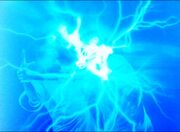
Sybok confronts "God"
Sybok turns to Spock and cannot believe any of it. He claims his own vanity and arrogance created this situation and now he must do what he has to do to ensure that Spock, Kirk, and McCoy are protected from the entity. He begs Spock to forgive him and holds up his hand in the Vulcan salute . Spock returns it as Sybok asks the entity about his pain. The entity is caught off-guard by the question. Sybok claims it runs deep and attacks the entity. As they struggle, Kirk, on his communicator, orders Sulu and Chekov on board the Enterprise to fire a photon torpedo at the encompassing entity. Chekov protests as Kirk, Spock, and McCoy are too close but Kirk tells him to fire immediately. The Enterprise opens fire and the torpedo obliterates the amphitheater. Spock laments that Sybok has been lost in the blast, but the entity has not been completely destroyed. Kirk and the others make a hasty escape back to the Copernicus but Spock finds that the thrusters have been rendered inoperative as the entity then violently shakes the shuttlecraft. Kirk flips open his communicator and begs with Scott to tell him that he has finally repaired the transporter. Scott replies that it has partial power and might be able to beam up two of them. Kirk tells Scott to bring up Spock and McCoy, the latter of which protests all the way up. Back aboard, Spock instructs Scott to now bring up the captain, but before he can, Klaa's Bird-of-Prey opens fire on the unshielded Enterprise , severely damaging her. Kirk now finds himself face to face with the entity, who has manifested itself in the cockpit of the Copernicus . The captain takes off running with the entity in pursuit.
Spock and McCoy return to the bridge, which is in a state of disarray. Klaa hails them and claims he hasn't destroyed them yet because he has come for James T. Kirk and promises to spare the lives of the crew if Kirk is handed over. Spock claims that Captain Kirk is not among them, he is on the planet below. Klaa wants his coordinates but Spock has a better idea. He asks General Korrd for his assistance as he is Klaa's superior officer. Korrd is skeptical about what good he can do as, while he might have been a great military leader at one time, he is now a "foolish old man." Spock implores Korrd to at least try and rehails Captain Klaa, stating that someone wishes to speak with him.

" So, it's me you want, you Klingon bastards?! "
On the surface of the planet, Kirk is pursued by the entity. With nowhere to hide from it, Kirk stares down his impending death as the entity closes in for the kill when Klaa's Bird-of-Prey closes in and destroys it with a thunderous blast from its disruptors. Kirk realizes that the Klingons have come for him as they target their disruptors in his direction next, but is surprised when they instead beam him aboard. The captain is escorted to the bridge where, to his great surprise, General Koord has ordered Captain Klaa to apologize to Kirk – the attack on the Enterprise was not authorized by the Klingon Empire. Koord entreats Kirk to meet the new gunner of the Bird-of-Prey. From the gunnery chair, Spock spins around and welcomes Kirk aboard – it was Spock who saved Kirk's life from the entity. Kirk tells him that he thought he was going to die, echoing their earlier conversation around the campfire. Spock, likewise, tells him that it was impossible as the captain was never alone. Kirk, feeling like he wants to hug Spock, moves to do so but Spock advises against it – not in front of the Klingons.

Comrades in arms
Aboard the Enterprise , the Starfleet crew hosts a reception in the observation lounge for the Galactic Army of Light, the three ambassadors and Klaa's crew, reflecting on their voyage to the center of the galaxy. Even Klaa himself offers a sign of respect to Captain Kirk, one warrior to another, which Kirk reciprocates. As McCoy and Spock speculate on whether or not God is actually out there, Kirk postulates that while God might not be out in space, perhaps he goes with them wherever they are in the Human heart. As Spock mourns the death of his brother, Kirk comforts him by relating that he once lost a brother. While McCoy may have thought he was referring to his late brother George Samuel Kirk , the captain adds that he was lucky enough to get that brother back, implying Spock, instead. McCoy challenges Kirk's earlier claim at the campfire that "men like us don't have families," but, Kirk concedes that he was wrong – that both Spock and McCoy are his family, and the three of them resume their trip in Yosemite, this time with Spock singing "Row, Row, Row Your Boat" and playing the song on his Vulcan harp .
Log entries [ ]
Memorable quotes [ ].
" Each man hides a secret pain. It must be exposed and reckoned with. It must be dragged from the darkness and forced into the light. "
" 'You'll have a great time, Bones. You'll enjoy your shore leave. You'll be able to relax.' You call this relaxing? I'm a nervous wreck. If I'm not careful I might end up talking to myself. "
" Captain, I do not think you realize the gravity of your situation. " " On the contrary, gravity is the foremost on my mind! "
" Goddamn irresponsible! Playing games with life! "
" Mind if we drop in for dinner? "
" Borgus frat! 'Let's see what she's got,' said the captain. And then we found out, didn't we?! "
" You really piss me off, Jim! Human life is far too precious to risk on crazy stunts! "
" I've always known I'll die alone. "
" It's a song, you green-blooded… Vulcan. You sing it. The words aren't important. What's important is that you have a good time singing it. " " Oh, I am sorry, doctor. Were we having a good time? " " God, I liked him better before he died! "
" Captain. " " Spock, we're on leave. You can call me Jim. " " Jim. " " Yes, Spock? " " Life is not a dream. " " Go to sleep, Spock. " " Yes, captain. "
" You told me you could get this ship running in two weeks. I gave you three! What happened? " " I think you gave me too much time, captain. "
" I could use a shower. " " Yes. "
" Jim, if you ask me – and you haven't – I think this is a bad idea. We're bound to bump into the Klingons, and they don't exactly like you. " " The feeling's mutual. "
" We'll beat those Klingon devils even if I have to get out and push. "
" I miss my old chair. "
" Imagine that. A passionate Vulcan. "
" Hello, boys. I've always wanted to play to a captive audience. "
" Be one with the horse! "
" Forgive you? I ought to knock you on your goddamn ass! " " If you think it would help. " " You want me to hold him, Jim? "
" I'll say one thing, Spock. You never cease to amaze me. " " Nor I, myself. "
" This person didn't by chance have pointed ears and an unending capacity for getting his shipmates into trouble, did he? " " He did have pointed ears. "
" Spock, my only concern is getting the ship back. When that's done and Sybok isn't here, then you can debate Sha Ka Ree until you're green in the face. "
" What are you standing around for?! Do you not know a jailbreak when you see one?! "
" I know this ship like I know the back of my hand. "
" I'm afraid of nothing. "
" I don't control minds. I free them. "
" I don't want my pain taken away. I need my pain! "
" You are mad. " " Am I? We'll see… "
" Are we dreaming? " " If we are, then life is a dream. "
" Is this the voice of God? " " One voice, many faces. "
" Who is this creature? " " Who am I? Don't you know? Aren't you God? "
" Jim, you don't ask the Almighty for his ID! "
" Why is God angry? "
" You have not answered his question! What does God need with a starship? "
" Do you doubt me? " " I doubt any god who inflicts pain for his own pleasure. "
" Stop! The god of Sha Ka Ree would not do this!! " " Sha Ka Ree?! A vision you created. An eternity I've been imprisoned in this place! The ship. I must have the ship! Now… give me what I want! "
" What's wrong? Don't you like this face? I have so many, but this one suits you best. "
" I couldn't help but notice your pain. " " My pain? " " It runs deep. Share it with me! "
" General, I require your assistance. " "My assistance? " " You are his superior officer. " " I am a foolish old man. " " Damn you, sir! You will try! "
" I thought I was going to die. " " Not possible. You were never alone. "
" Please, captain. Not in front of the Klingons. "
" Cosmic thoughts, gentlemen? " " We were, speculating… is God really out there? " " Maybe He's not out there, Bones. Maybe He's right here… the Human heart. "
" I was thinking of Sybok. I have lost a brother. " " Yes. I lost a brother once . But I was lucky, I got him back . "
Background information [ ]
- Co-Writer and Director William Shatner once remarked that he initially intended this movie to be written by thriller and fantasy author Eric Van Lustbader . " My biggest failure [in the making of the film] was I had read some books by Eric Van Lustbader, who had written some wonderful novels about an American in Japan and how out of place he felt. I thought, 'God, that'd be perfect for a Spock movie.' I went to see him and we walked the streets of New York pondering the plot of Star Trek , " Shatner recalled. " He was a fan. I thought, 'God, I've got a bestselling author ready to do a Star Trek .' And then they couldn't agree on the novel rights. So I lost him and my movie was going downhill before it even started. " ( 50 Years of Star Trek , p. 15)
- William Shatner stated in his memoir Star Trek Movie Memories (1995, pp. 278-279) that he came up with the story idea of the search for what turned out to be a false god, while he was watching the at-the-time controversial televangelist couple Jim and Tammy Faye Bakker, on television. He became amazed and disgusted by the idea how such vulgar people had the audacity to purport they alone were the harbingers of God and had become rich from donations by their followers.
- Though Paramount Pictures President Frank Mancuso, Sr. was a religious man, he was sympathetic to Shatner's story outline and green-lit the production of the movie when Shatner pitched his story outline to him in person. ( Star Trek Movie Memories , 1995, p. 282)
- Star Trek creator Gene Roddenberry had, since Star Trek: The Motion Picture , no formal creative say in the Star Trek films by that time, only the title of "Executive Consultant". All subsequent movies were vehemently resisted by Roddenberry, particularly The Final Frontier . Roddenerry went as far as to have his attorney Leonard Maizlish prepare legal procedures against Shatner. The legal action did not proceed. Roddenberry's position did not allow for this but Roddenberry declared the film "apocryphal". ( Star Trek FAQ 2.0 , chapter 13; Star Trek Movie Memories , 1995, pp. 283-284)
- The Final Frontier approximated Roddenberry's atheist worldview, and was reminiscent of his own 1975 unrealized movie script The God Thing , a reworked version of which became In Thy Image and then, reworked further, the script for The Motion Picture . Richard Arnold , who was working at Roddenberry's office at the time, was present when the first story outline of The Final Frontier was delivered to Roddenberry as an FYI, later explaining to Shatner why Roddenberry reacted as he did, " So when you came along, though it was years later, with very similar themes, Gene was really hurt. I think it hurt Gene's ego that you finally going to tell the story that he wanted to tell ten years earlier. You were about to succeed where he had failed. At the time, Gene's secretary, Susan was making matters worse by walking around the office stating things like 'I can't believe it! He stole your idea. Bill's an asshole. Bill's a bastard.' So that did not help, and additionally, I know there was a fairly legitimate concern on Gene's part that your sense of humor [in regard to the way the secondary cast was eventually portrayed in the movie] was a little different than had ever been visualized before. " While Susan Sackett's reaction might be construed as personally motivated, she actually had, in all fairness, a point; Shatner himself has related how he had stumbled upon Roddenberry ten years earlier when the latter was busy writing The God Thing , and was on that occasion given a beat-for-beat summary of the story. Some of this may have nestled in Shatner's subconscious. ( Star Trek Movie Memories , 1995, pp. 46-49, 289-291) Though Shatner had implied as much in his memoir, Arnold's remarks confirmed that Shatner had neither consulted nor communicated with Roddenberry even once, during the entire production of the movie.
- Co-Writer/Producer Harve Bennett , partly responsible for the three previous successful Star Trek movies, initially did not want to make the film as both his relationship with several key production staffers, in particular with Leonard Nimoy , had started to deteriorate with Star Trek IV: The Voyage Home . He was also fed up with Roddenberry's interloping. Shatner trusted Bennett, but had a hard time convincing him to come aboard. ( Star Trek Movie Memories , 1995, pp. 283-285)
- Star Trek V , released in June 1989, was the last Star Trek movie to be released in the summer months until 2009's Star Trek .
- Star Trek V was the first Star Trek production to be made in tandem with another ( Star Trek: The Next Generation , whose second season was in production during the filming) and one of only two productions to be made during that time period without any involvement from Rick Berman .
- Star Trek V has provoked controversy among fans. Many consider this movie to be the weakest Star Trek film ever made, although financially, the later Star Trek Nemesis performed even worse worldwide, though it was initially the number one film at the box-office on its first weekend of release and grossed a solid US$17 million. It ultimately earned over $52 million in the US and Canada plus over $17 million overseas. [1] It was not as successful as its predecessor, Star Trek IV: The Voyage Home , which had grossed US$109.7 million in North America alone. ( see also : Star Trek films: Performance summary )
- During the 1988 Writer's Guild of America strike, the film's pre-production and shooting schedule were severely trimmed.
- Paramount decided that Star Trek V would be as comedic as Star Trek IV .
- Star William Shatner made a deal with Paramount that if Star Trek IV was successful, he would be contracted to direct the next film, although according to Star Trek Movie Memories (1995, p. 244), both William Shatner and Leonard Nimoy had what Shatner referred to as "favored nation clauses", in their contracts meaning essentially that what one got, the other got. According to Shatner, it was Nimoy who put the idea of directing Star Trek V in his head during the production of Star Trek IV , telling Shatner that because of their favored nation status, he could successfully demand to direct the next film.
- There was public dissatisfaction with Star Trek: The Next Generation among fans at the time.
- Industrial Light & Magic (ILM) was not contracted to do the effects for the film, due to the unavailability of the company, with the job going to a lesser known company, Associates & Ferren . The result was poor quality, and in some cases, obviously unfinished special effects shots.
- Intense competition during the summer of 1989 with the release of a multitude of blockbusters, including the long awaited Tim Burton Batman film, Lethal Weapon 2 , Ghostbusters 2 , and Indiana Jones and The Last Crusade (according to Harve Bennett in Star Trek Movie Memories – 1995, pp. 395-396).
- Principal photography began on 11 October 1988 and ended on 28 December of the same year. The first scene filmed was Harve Bennett's cameo as Rear Admiral " Bob ". Production began shooting at Yosemite National Park , then moved to the Mojave Desert , then back to Paramount Studios, where they filmed next door to Star Trek: The Next Generation . The last scenes filmed were the Kirk-Spock-McCoy trio's campfire singalongs. ( Star Trek V: The Final Frontier DVD special features)
- On 28 December, the last production day (only a few missing special effects shots were filmed that day), a press conference was held on the set to various newspaper, television, and radio reporters. Producers Harve Bennett and Ralph Winter, director William Shatner , and the entire Star Trek main cast participated, answering questions. ( Star Trek V: The Final Frontier DVD special features)
- The Star Trek V novelization also references and shows Sybok showing the crew how to radically adjust the deflector shields in order to be able to pass through the extreme radiation environment of the Great Barrier .
- Another oddity is the Enterprise 's trip to the center of the galaxy, which should have taken decades but seemed to occur in less than a day. In the novelization of Star Trek V , it is mentioned that Sybok's tinkering allows them to decrease their travel time. The Bird-of-Prey scans the Enterprise during their pursuit and is able to duplicate their rate of travel as well as Sybok's shield modifications allowing them to penetrate the Barrier.
- The film was the "winner" of the 1990 Razzie awards for "Worst Picture," "Worst Actor" (Shatner), and "Worst Director" (Shatner). It also received nominations for "Worst Picture of the Decade," "Worst Supporting Actor" (Kelley), and "Worst Screenplay" (Loughery, Shatner, and Bennett). In 2006, former Mystery Science Theater 3000 co-stars and writers Mike Nelson and Kevin Murphy mocked the film in a downloadable audio commentary track for Nelson's RiffTrax service.
- Because of its failure at the US box office, in some countries this film was not distributed in the theaters, but only on VHS.
- In the United Kingdom the film was released theatrically on 20 October 1989 . The Final Frontier was a modest success, opening at the top of the box office and earning £1,451,378 overall. [4]
- Some of the special effects in this movie are markedly different than those featured in previous Star Trek films. Among other changes, photon torpedoes have a different design and color (the torpedo from the Enterprise was a slightly recolored reuse of V'ger 's "whiplash bolt" from The Motion Picture , and a slightly different effect was used when going to warp speed. The release of Star Trek VI: The Undiscovered Country , however, marked a return to the effect designs that characterized earlier Trek films.
- ILM, the company which did the special effects for the previous three Star Trek films and TNG : " Encounter at Farpoint ", was unavailable because the company was working on Indiana Jones and the Last Crusade and Ghostbusters II at the time. The result of this is the considerably cheaper-looking effects seen in the film.
- The sequence of "God" chasing Captain Kirk on the Sha Ka Ree planet was originally conceived to be much longer and extensive, but it had to be severely cut as a result of awful-looking special effects.
- In addition, some of the outer space shots are stock footage from the previous films. The shot of the Enterprise in spacedock is from the end of The Voyage Home . Also, a few Klingon Bird-of-Prey shots are reused from Star Trek III: The Search for Spock . The spiraling starfield during Kirk's unfinished log entry is lifted from the opening titles of Star Trek II: The Wrath of Khan .
- William Shatner's first outline for this film was entitled "An Act of Love" and, according to William Shatner's Star Trek Movie Memories, would have been a much darker tale and would have seen the first true falling out between Kirk and Spock and McCoy. Also, Spock and McCoy would also have joined with Sybok, leaving Kirk alone. This was changed when Nimoy absolutely refused to play that, stating that there was no chance whatsoever that Spock would ever turn on Kirk, especially after what Kirk risked and sacrificed for Spock in Star Trek III . Director Shatner talked to Nimoy, attempting to change his mind, but Nimoy was firm in believing that pain or no pain, brother or no brother, Spock would not betray Captain Kirk. Shatner eventually conceded and had the script adjusted. In the book, Shatner comments that he was aware there was no chance he could know Spock as well as Nimoy would and he certainly couldn't force Nimoy to play the part as written. According to Shatner, on the same day that Nimoy objected, DeForest Kelley also refused, believing that McCoy would not turn against Kirk either and Kelley was as adamant about it as Nimoy was. Shatner said that he didn't know and still doesn't know if changing the script was the right decision to make, but he also conceded that if someone else had come in and written a scenario where Kirk would turn against Spock and McCoy, he too, would "raise the roof" over it. Nevertheless, Shatner said he would still have loved to have seen and been able to play the original version of the scenario.
- The name "Sha Ka Ree" was taken from " Sean Connery ", the actor Star Trek producers originally wanted to play Sybok. Unfortunately, Connery was busy working on Indiana Jones and the Last Crusade , and was unavailable to play the part. ( Star Trek Movie Memories 1995, p. 292)
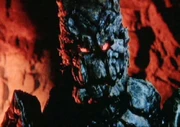
The "Rock Man" in the deleted scene
- In the original script, Kirk was attacked by ten large "rockmen" emerging from the rock faces of Sha Ka Ree. Unfortunately, with an extremely limited budget (which was responsible for other "high budget" items being removed from the final script, as well as for the use of cheaper effects for the space scenes), only one animatronic " Rock Man ", portrayed by stuntman Tom Morga , was created. The single rockman was filmed attacking Kirk, but the scene was thought too poor to include in the film, although an extremely brief (a few frames) glimpse of the creature occurs in the final print during the scene where "God" fires energy blasts at Captain Kirk. Some test footage of the creature is available in the Special Edition two-disc DVD release. The idea did make it to theaters in the Star Trek parody Galaxy Quest . A few images of Morga as the rockman were later released in the special feature "Tom Morga: Alien Stuntman" on the 2009 box release Star Trek: Original Motion Picture Collection (DVD) .
- Closeups of the El Capitan climbing scenes were filmed on a fake wall made of fiberglass. The real mountain can be seen at distance.
- Closeups of Kirk's fall were actually shot horizontally, then flipped so that they appeared vertical.
- When Kirk returns to the bridge of his ship for the first time, he is given his uniform jacket by a yeoman . The yeoman is played by Shatner's youngest daughter, actress Melanie Shatner , and had been credited for it as such. Incidentally, her two older sisters, Lisabeth and Leslie , had already had uncredited cameo appearances as two of the Only girls in Star Trek: The Original Series episode " Miri ". Upon the conclusion of the movie, daughter Lisabeth wrote a book on her father's experiences making the movie, Captain's Log: William Shatner's Personal Account of the Making of Star Trek V: The Final Frontier .
- Several deleted scenes are available on the Special Edition DVD, including one of Sulu and Chekov visiting the Mount Rushmore monument, with the added face of an African-American woman.
- The novelization has some additional dialogue about Spock and McCoy speculating that the great barrier might not have been meant to keep them out, but to keep "God" in, prompting Spock to say that they may have yet to reach the final frontier.
- As had been the case with Star Trek IV: The Voyage Home , this film sports a rare instance of Trek product placement . Kirk and McCoy wear Levi's blue jeans for the first half-hour of the film, and Levi Strauss & Co. gets a credit at the end of the film.

Kraft Marshmallow Dispenser
- Spock makes an uncharacteristic mistake when he calls "marshmallows" by the name "marsh melons". The novelization shows that McCoy, knowing Spock would want to study what the ship had in the library computer about camping out before going out, paid a computer tech to change all references in the Enterprise computer about marshmallows to "marsh melons." The novel also includes characterizations of McCoy's and Kirk's reactions and McCoy having a silent laugh at Spock's error. In the final picture, McCoy simply stumbles over the pronunciation to continue the joke. Later, in the levitation boots scene on the Enterprise (mentioned below), Kirk again mentions "marsh melons", which some have thought to be the mistake, but is evidence he also recognized Spock's error. When they return to the camp site at the end of the novel, Spock has since then detected McCoy's activity and has had his misinformation corrected.
- The entire movie was filmed on such a tight schedule that many of the shots were set up in a matter of minutes, instead of hours.
- According to Shatner, the campfire scenes had to be shot in closer angles, because time and budget constraints prevented the production team from building the top of the trees on the set.
- The cloak with the numerous medals that Ambassador Korrd wore appeared again in Star Trek: The Next Generation as the cloak worn by the Klingon chancellor . The first chancellor to be seen, K'mpec (who first appeared in TNG : " Sins of The Father "), was also played by Charles Cooper .
- During location shooting, locals were hired to portray Sybok's "army" during his raid on Nimbus III . Because of the severe budget cuts and not enough number of these extras, many of them were re-used in different shots, running through the gates over and over again.
- One of Kirk's famous lines in this film is his prediction that he "will die alone." In the movie Star Trek Generations , Kirk dies after emerging from the Nexus in the 24th century . Although he dies apart from his closest friends (Spock and McCoy), Jean-Luc Picard is with him at his passing.
- Near the end of the film when Spock mentions that he lost his brother, Sybok, Kirk retorts, " Yes. I lost a brother once. I was lucky I got him back. " While Kirk's biological brother, George Samuel Kirk , died in TOS : " Operation -- Annihilate! ", he was clearly making a reference to Spock, who died in Star Trek II: The Wrath of Khan and was resurrected in Star Trek III: The Search for Spock . (However, Spock and McCoy look visibly surprised when Kirk mentions having lost a brother, creating a potential continuity error as both were present when George died.) This is the second time that Kirk refers to Spock as his "brother". The first time occurred in TOS : " Whom Gods Destroy ". The Star Trek V: The Final Frontier comic book adaptation had Kirk say " I've lost two brothers, but I was lucky to get one of them back. "
- After the Bird-of-Prey destroys "God", Kirk says, " So, it's me you want you Klingon bastards? ", a reference to a scene in Star Trek III: The Search for Spock in which Kirk calls them the same thing after Kruge kills his son, David Marcus .
- Shatner originally wanted Sybok's horse to be a unicorn, adding a more "mythical" approach to the character, but Gene Roddenberry disapproved of it, saying that it would turn Star Trek into a space fantasy instead of science fiction. ( citation needed • edit )
- This is the first Star Trek movie not to be nominated for a Hugo Award for "Best Dramatic Presentation".
- In an interview for the book Captains' Logs , Harve Bennett blamed the movie's failure on Star Trek: The Next Generation .
- Shatner had been so impressed with Production Designer Herman Zimmerman 's work on The Next Generation , that he hired Zimmerman to upgrade the Enterprise interiors for the film. Hence, the upgraded bridge from the movie resembles the bright atmosphere portrayed in The Next Generation . Decades later Zimmerman later jokingly commented after seeing the film, considered so flawed by many, " After the show was over, I was pretty sure I would never do another! " ( The Art of Star Trek , p. 249; Star Trek: 45 Years of Designing the Future )
- The Enterprise -A corridors are from The Next Generation . Except for the turbolift, they were not changed for the movie.
- The Enterprise -A bridge is mostly a new set, except for the turbolifts, Sulu and Chekov's helm console, the handrails, and some of the platforms on which the portions of the bridge stood. According to the Collector's Edition DVD text commentary, a new bridge set was necessary due to the original movie bridge set being mostly damaged by a sudden windstorm while in temporary storage at the Paramount studio parking lot (other sources have the reason for the new bridge set's construction as being because it had been extensively modified for use on TNG to the point that it could not be converted back), and only those few pieces used on the Enterprise -A bridge were salvaged from the original set. Captain Kirk would thus seem to briefly break character when he muses, " I miss my old chair. " The decoration from the salvaged set was also used for the Stargazer bridge and for the battle bridge in TNG.
- Another all-new set was the forward observation lounge where several dramatic scenes take place. According to Michael Okuda , this room was located on the forward-center edge of the saucer section (much like Ten Forward on the Enterprise -D). However, when looking at the exterior of the Enterprise -A, there are no windows which match the location of this room. The plan was to update the filming miniature with the three larger windows, however time and budget constraints forced the producers to omit this change as it was believed they would be unnoticed due to their small size. ( citation needed • edit )
- Nichelle Nichols, an accomplished singer and dancer, provided an authentic performance of the "fan dance" routine in this film; she was outraged when her vocals in the scene were later overdubbed in editing without her approval.
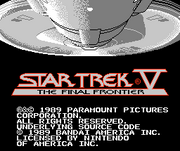
Unreleased Star Trek V: The Final Frontier video game
- A Bandai Nintendo Entertainment System action game was slated to be released in 1989 along with the movie. The game was canceled following the failure of the film at the box office. A prototype has surfaced and is circling the net as a ROM. It is notable for its many basic spelling errors (example: at one point Scotty is named "Scotto") and lack of an ending (the game may have been incomplete at the time it was scrapped).
- This film marked the return of Jerry Goldsmith to the Star Trek franchise. He returned again to compose the music for Star Trek: First Contact , Star Trek: Insurrection , and Star Trek Nemesis , and to compose the theme for Star Trek: Voyager . An attempt was made to bring Goldsmith on to compose for Star Trek VI: The Undiscovered Country after James Horner turned it down. However, Goldsmith also refused, citing the poor results of Final Frontier .
- Among the items featured in this film which were sold off on the It's A Wrap! sale and auction on eBay were a Starfleet Field Duty Commando division strip [5] and the stunt costume for David Richard Ellis . [6] The rock climbing costume worn by Shatner was also auctioned off. [7] The costume had "Boreal"-brand shoes.
- This is the only one of the first six Star Trek films not to feature any scenes based in and around Starfleet Headquarters in San Francisco .
- The otherwise very Star Trek friendly magazine Cinefantastique has made no mention whatsoever of this production in their publications.
- A draft version of the film's script was submitted on 29 February 1988 . [8]
- This is the first Star Trek film to use the 1986-2002 Paramount Pictures logo.
- CBS aired its one and only Star Trek movie network TV premiere with Star Trek V: The Final Frontier on December 3, 1991, a good three days ahead of Star Trek VI: The Undiscovered Country opening in cinemas nationwide.
Star Trek V continues the story of the previous film only a short time after its ending, where the Enterprise -A departs for its shakedown cruise. This film begins with the Enterprise back in spacedock and Scott filing in his shakedown cruise report. The previous film, Star Trek IV , is dated to 2286 , when Gillian from 1986 mentions that she has three hundred years of catching up to do, suggesting this film takes place in 2286, or at the latest in 2287 .
In the film, Caithlin Dar makes a reference that Nimbus III was established as a planet of galactic peace 20 years ago, when the Federation and the Klingon and Romulan Empires attempted unsuccessfully to usher into a new era of peace and co-operation. While not explicitly stated, these are references to the Organian Peace Treaty of 2267 at the end of " Errand of Mercy " and the Romulan-Klingon Alliance some time in or before 2268 based on references from " The Enterprise Incident " and " Reunion " These references give Star Trek V a timeframe from 2286 to 2288 .
In the Star Trek: The Next Generation episode " Evolution " (broadcast as the third-season premiere), it is mentioned by Lt. Commander Data that " [there] has not been a systems-wide technological failure on a starship in seventy-nine years. " The episode was the very first filmed TNG installment to air following the June 1989 theatrical release of Star Trek V: The Final Frontier (in September 1989), and this line of dialogue was very likely written by Michael Piller as a "nod" to the events of the most-recent movie, placing the events of the film in the year 2287 (seventy-nine years prior to the year 2366 ).
Another complicating factor is that the film itself makes it quite clear that it picks up just a few weeks after the events of Star Trek IV given how Kirk points out that Scotty said he could have the Enterprise ready in two weeks and Kirk gave him three. Additionally, we are told in Kirk's log entry at the start of Star Trek IV that the movie takes place three months after the end of Star Trek III which in turn picks up immediately where Star Trek II leaves off at. Kirk's birthday, which was celebrated in Star Trek II , was established as March 22 by an okudagram from ENT : " In a Mirror, Darkly, Part II ". Due to these factors, assuming Star Trek II takes place on March 22, 2285, Star Trek III is likely set in April 2285, Star Trek IV is likely set in July 2285, and Star Trek V is likely set in August 2285.
StarTrek.com , Star Trek Chronology , and Star Trek Encyclopedia (3rd ed., p. 691) use the year 2287, or twenty years after the Organian Peace Treaty. Memory Alpha uses this year, as well.
Characters [ ]
During production of The Original Series , James Doohan took pains to conceal his right hand from the camera, due to it missing a finger as the result of an injury the actor suffered in the Second World War, and when close-ups of Scott's hands were required a body double was used. Thus, Scott canonically was not missing any fingers during the TOS timeframe. In this film, Doohan's injured hand is clearly visible in one scene, ( citation needed • edit ) establishing in canon that, at some point between TOS and Star Trek V , Scott lost a finger, for reasons as yet unrevealed.
Merchandise gallery [ ]
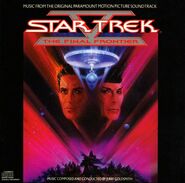
Awards and honors [ ]
Star Trek V: The Final Frontier received the following awards and honors.
Apocrypha [ ]
The novel The Fire and the Rose shows that as Spock began to regret undertaking the Kolinahr , that he remembered what Kirk had told Sybok about how the regrets and the pain one carries with them is part of what makes them who they are and it does help in Spock's decision to reverse the Kolinahr .
The Sha Ka Ree entity is identified in The Q Continuum trilogy as The One, a being that was drawn into this universe through the Guardian of Forever by the entity known as 0 , subsequently being defeated in a confrontation with the Q Continuum and locked away in the galactic center – having been reduced to only a head – until His repentance or the heat death of the universe, "whichever comes first."
Vonda McIntyre 's novelizations of Star Trek: The Wrath of Khan , Star Trek III: The Search for Spock and Star Trek IV: The Voyage Home had Hikaru Sulu 's rank at captain (based on cut material from Star Trek II ) for sake of continuity within the novels. When J.M. Dillard wrote novelization of Star Trek V: The Final Frontier , she included a reference that Sulu had taken a temporary reduction in rank back down to commander in order to serve on the Enterprise , a decision which, when Kirk found out, made him furious at Sulu for not thinking of his own career first, and after giving Sulu hell about that decision, Kirk thanked him afterward.
According to the novel The Sorrows of Empire , McCoy's mirror universe counterpart was also responsible for his father's death, though under dramatically different circumstances: he tortured him to death on the orders of the Terran Empire .
The massively-multiplayer online video game Star Trek Online features Nimbus III as a location players can travel to, including Paradise City and its featured bar. There are other adventures players can partake in out in the neighboring desert wasteland, including one of the first introductions of the Elachi race to non-Romulan players.
Links and references [ ]
Credits [ ], opening credits [ ].
- William Shatner
- Leonard Nimoy
- DeForest Kelley
- James Doohan
- Walter Koenig
- Nichelle Nichols
- George Takei
- David Warner
- Laurence Luckinbill as Sybok
- Gene Roddenberry
- Jerry Goldsmith
- Nilo Rodis-Jamero
- Peter Berger , ACE
- Herman Zimmerman
- Andrew Laszlo , ASC
- Ralph Winter
- William Shatner & Harve Bennett & David Loughery
- David Loughery
- Harve Bennett
Closing credits [ ]
- Kirk – William Shatner
- Spock – Leonard Nimoy
- McCoy – DeForest Kelley
- Scotty – James Doohan
- Chekov – Walter Koenig
- Uhura – Nichelle Nichols
- Sulu – George Takei
- St. John Talbot – David Warner
- Sybok – Laurence Luckinbill
- Korrd – Charles Cooper
- Caithlin Dar – Cynthia Gouw
- Captain Klaa – Todd Bryant
- Vixis – Spice Williams
- J'onn – Rex Holman
- " God " – George Murdock
- Young Sarek – Jonathan Simpson
- High Priestess – Beverly Hart
- Pitchman – Steve Susskind
- Starfleet Chief of Staff – Harve Bennett
- Amanda – Cynthia Blaise
- McCoy's Father – Bill Quinn
- Yeoman – Melanie Shatner
- Glenn R. Wilder
- Don Pulford
- Greg Barnett
- David Burton
- David Richard Ellis (stunt double for Laurence Luckinbill )
- Linda Fetters ( Feline bar dancer )
- James M. Halty (stunt double for George Takei )
- Freddie Hice (stunt double for DeForest Kelley )
- Thomas Huff (stunt double for DeForest Kelley)
- Joyce L. McNeal
- Tom Morga ( Starfleet field security crewman / Rock Man ( deleted scene ))
- Frank Orsatti
- Air Randall
- Bruce Wayne Randall
- R.A. Rondell
- Tom Wetterman
- Scott Wilder ( Starfleet field security crewman )
- Douglas E. Wise
- Burt "Skip" Burnam
- George Fortmuller
- Brooke Breton
- Bill Shepard , CSA
- Bran Ferren
- Keith Peterman
- Phil Caplan
- Kenneth Nishino
- Dick Meinardus
- Dennis B. Seawright
- Jeffrey S. Thorin
- David Ronne , CAS
- John Schuyler
- Stewart D. McDonald, Jr.
- Michael L. Wood
- Mike Edmonson
- Dodie Shepard
- John D. Bronson
- Raymond A. Phelps
- Joseph R. Markham
- Donna Barrett Gilbert
- Hazel Catmull
- Kenny Myers
- Michael Mills
- Jan Alexander
- Edouard Henriques III
- Katalin Elek
- Rolf John Keppler
- Ellis Burman
- Marion Tumen
- Donald O. Nygren
- Richard Hartley
- Carmon H. Howell
- Burton Lindemoen
- Jon A. Falkengren
- John M. Dwyer
- Anthony Brockliss
- Sandy L. Veneziano
- Ronald R. Wilkinson
- Richard Frank McKenzie
- Andrew Neskoromny
- Antoinette Gordon
- Michael Okuda
- Cari Thomas
- Rick Sternbach
- Barton M. Susman
- Kurt V. Hulett
- Richard J. Bayard
- John Matheson
- Gary A. Clark
- James H. Betts
- Linda Miller
- Jeff McGrath
- Michael Mann
- Raymond A. McLaughlin
- Gaston Veilleux
- Corky Randall
- Thomas B. Jones
- Terry Erdmann
- Bruce Birmelin
- George C. Villaseñor
- John A. Haggar
- Christopher E. Bennett
- Reel People, Inc.
- Mark Mangini
- Alan Howarth
- Michael J. Benavente
- Warren Hamilton, Jr. , MPSE
- David A. Whittaker , MPSE
- Wayne Allwine , MPSE
- David Spence
- Ron Bartlett
- Solange Schwalbe Boisseau
- Kenneth Dufva
- Gregory J. Curda
- Andrew Patterson
- Bill Voigtlander
- Sonny Pettijohn
- Destiny Borden
- Angie Luckey
- Ken Johnson
- David Moreno
- Chris Jenkins
- Gary Alexander
- D.M. Hemphill
- Scott Austin
- Marc Okrand
- Arthur Morton
- Bruce Botnick
- Record Plant Scoring
- Valerie Mickaelian Kucera
- Tony Criscione
- Marie Elder
- Paul F. Schlichting
- Eva Marie Friedrick
- Mary Jo Fernandez
- Charlene Bergman
- Kimberly Boyle
- Rebeca R. Brookshire
- Susan Sackett
- Wendell Johnson
- Deborah L. Campbell
- James Collins
- Barbara Harris
- Denali Productions, Inc.
- Robert Carmichael
- Stephen J. Ross
- Susan McCrae
- Rob Sweeney
- Michael Weis
- John McCloud
- Bernie Pock
- Paul Sibley
- Werner Braun
- Jim Bridwell
- Bill Russell
- Sean Plunkett
- Steven Haire
- Nadim Melkonian
- Troy Johnson
- Walter Shipley
- Dean Miller
- Joe Valentine
- Bill Killey
- Bob Stradling
- Associates & Ferren
- Eric Angelson
- James Shelly
- Patricia Barry
- Susan Le Ber
- Susan Coursey
Live Action Effects Unit [ ]
- Frost Wilkinson
- Phil Gosiewski
- Bruce Vaughn
- Phil Cullum
- Paul Jordan
- Seth Nathanson
- Bob Francis
- Miles Ambrose
- Otto Leichliter
- Ron Webster
- Chester Hartwell
- Kinnereth Ellentuck
- Alan D. Webb
Model Unit [ ]
- Peter Wallach
- Edward Lee Rapp
- Michael Sullivan
- Jack Riedel
- Robert Lyons
- Michael Faerman
- Rachel A. Drapkin
- Peterson Tooke
- Paul Michael Clemente
- David V. Mei
- Michael Tabacco
- Valentine Vignes
- Daniel Nauke
- Michael Gerzevitz
- Michael Kellough
- Thomas Quinn
- Noel Sheinberg
- Susan Tremblay
- David Drapkin
- David Bruce
- Maria Konwicka
- Veronica E. Lesser
- Gregory Jein, Inc.
Optical Unit [ ]
- Dick Swanek
- Robert Rowohlt
- John Alagna
- Mitch Wilson
- Robert Schulze
- Tom Snowden
- Louis Goold
- Michael Ventresco
- Gregory Harker
- Valerie Baiardi
- Eddie Stewart
- Stewart Brown
Additional Optical Effects [ ]
- Barry Hyman
- Peter Kiran
- Illusion Arts, Inc.
- Marc Sawicki
- Industrial Light & Magic
- Epic Records, Cassettes and Compact Discs
- Music by: Jerry Goldsmith
- Lyric by: John Bettis
- Performed by: Hiroshima
- Produced by: Dan Kuramoto
- Hiroshima courtesy of Epic Records
- Music by: Alexander Courage
- Dr. Charles A. Beichman , Infrared Processing and Analysis Center Jet Propulsion Lab, Pasadena
- Robert Parker
- Jack Morehead , Superintendent
- Bureau of Land Management
- California Film Commission
- State of California, State Lands Commission
- Madera County Film Commission
- Jet Propulsion Laboratory , Pasadena
- Reebok International, Ltd.
- Jack Daniel's
- Apple Computers
- Monster Cable ®
- International Scientific Instruments, Inc.
- Denton Vacuum, Inc.
- Princeton Gamma-Tech
- Carl Zeiss, Inc.
- de Graf/Wahrman, Inc.
- Base Gamma Electronic Systems
- Kraft, Inc.
- Levi Strauss & Co.
- Todd A-O/Glen Glenn Studios
- Technicolor ®
- Panavision ®
- Charles Bazaldua ( The Loop Group )
- Gene Cross as Sybok's follower
- David Dewitt
- Steven Johnson as Starfleet field security crewman
- Carlyle King (The Loop Group)
- Kevin Lindsay as alien bar patron
- Patrick Michael as Enterprise -A crewman
- Richard Penn (The Loop Group)
- Paige Pollack (The Loop Group)
- Susan Savage
- Gary Schwartz (The Loop Group)
- Carey Scott as voice of a teenage Spock ( deleted scene )
- Mike Smithson as Klingon helmsman
- Nimbus III bar patron
- " Wrinkles "
- Rhoda Williams as alien vocals
- Ilona Wilson as Nimbus III bar patron
- " Ape Face "
- " Bone Head "
- " Dark Eyes "
- " Leather Face "
- " Long Face "
- " Lost Soul "
- " Round Eyes "
- Nimbus III lookout party
- Alien sentry
- Klingon commander
- Seven Starfleet field security officers
- Four followers of Sybok
- Three Nimbus III bar patrons
- Terry Jackson
- David Wendler as stunt double for William Shatner (horse stunts)
- Tom Boyd – Musician: Oboe
- Cogswell Video Services, Inc. – Visual Effects Unit Video Assist Company
- Lynette Eklund – prison alien anatomy pieces artist
- Christopher Gilman and Global Effects, Inc. – Creator and provider of the cool suits
- Karen Hulett – Costume design
- Stuart Land – Prosthetics
- Lisa Logan – Cutter/Fitter
- David Nicksay – Executive Producer
References [ ]
2267 ; adventure ; alcohol ; Almighty ; amusement ; ancestor ; Andorian language ; angry ; animal ; arrest ; arrival ; arrogance ; ass ; attack ; attack course ; attack range ; attention ; audience ; authority ; backpack ; banishment ; barricade ; bath ; bay doors ; bean ; bearing ; betrayal ; belief ; birth ; blizzard ; blowscreen ; binoculars ; bipodal seeds ; brig ; boat ; " Bones "; booster rocket ; bourbon ; bowl ; brainwashing ; brig ; " by the book "; cadet ; campfire ; camping ; " Camptown Races "; capital city ; charge ; chariot ; choice ; cloaking device ; Columbus, Christopher ; command chair ; commander ; commercial ; communicator ; companion ; compliment ; computer library ; confrontation ; con man ; conn ; conspiring ; consul ; contact ; coordinates ; Copernicus ; course ; creature ; cricket ; culture ; cure ; custom ; danger ; darkness ; data ; David McCoy's condition ; death ; degree ; designer ; destination ; devil ; dinner ; disaster ; discovery ; distress signal ; dignity ; doctor ; dogma ; door ; dream ; ear ; Earth ; Eden ; El Capitan ; emergency assistance ; emergency channel ; Emergency Landing Plan B ; emergency sending apparatus ; emotion ; Enterprise -A, USS ; Enterprise -A dedication plaque ; estimate ; eternity ; Excelsior , USS ; Excelsior -class ; existence ; experience ; expression ; face ; faith ; family ; fan dance ; fantasy ; fear ; Federation ; Federation Federal ; feeling ; financing ; fishing ; flat ; flat Earth ; flattery ; flavoring ; footspeed ; forward observation room ; free-climbing ; French language ; friend ; Galactic Army of Light ; galactic core ; Galileo ; Galileo -type shuttlecraft ; garbage ; gate ; generation ; " get a grip on yourself "; ghost ; ghost town ; God ; government ; gravity ; Grayson, Amanda ; Great Barrier ; Great Horned Owl ; green ; guilt ; gunner ; hailing frequency ; half-brother (brother); hand ; heart ; heart attack ; Heaven ; " hello "; high priestess ; " hit the brakes "; hole ; horse ; hostage ; hostage tape ; hour ; Human ; humor ; hydro vent ; ID ; idea ; illusion ; immortal ; impulse power ; information ; ingredient ; intellect ; intelligence ; intention ; intention ; Iowa ; jailbreak ; jet boots ; job ; journey ; junior officer ; kellicam ; Klaa's Bird-of-Prey ; Klingons ; Klingon Bird-of-Prey ; Klingon Empire ; Klingon High Command ; Klingon language ; knowledge ; land ; landing bay ; leader ; letter ; levitation boots ; Levi's ; life support system ; light (artificial); light (natural); logic ; lookout party ; Luna ; lyric ; " macho "; " made love "; madman ; magic wand ; marshmallow ; Masefield, John ; maximum speed ; meaning ; melon ; Melville, Herman ; message ; metabolism ; Milky Way Galaxy ; mind ; miracle ; mister ; mood ; " Moon over Rigel VII "; " Moon's a Window to Heaven, The "; monkey ; Morse code ; mount ; mountain ; muscle ; mystery ; myth ; naked ; " neck of the woods "; " nervous wreck "; Neutral Zone ; Neutral Zone Treaty ; Nimbus III ; Nimbus III moons ; Nimbosian horse ; noise ; " oh my God "; " on board "; " on course "; " on leave "; online ; orbital shuttle ( unnamed orbital shuttle ); Orbital shuttle 5 ; Orbital shuttle 7 ; order ; " out of favor "; outcast ; " Pack Up Your Troubles "; pagan ; pain ; Paradise City ; Paradise Inn ; passion ; person ; phaser ; photon torpedo ; Pioneer 10 ; " piss me off "; place ; pleasure ; pool ; power source ; priority 7 ; princess ; prisoner ; probe ; problem ; pronunciation ; proof ; protective custody ; " put me out to pasture "; quadrant ; quest ; question ; Qui'Tu ; reality ; reason ; record time ; red alert ; renegade ; repairs ; representative ; rescue ship ; research ; respect ; revolutionary ; Rigel VII ; ritual ; rock ; Romulans ; Romulan ale ; Romulan language ; room ; round ; " Row, Row, Row Your Boat " ( rowboat ); San Francisco Fleet Yards ; scholar ; scope ; scotch whiskey ; Scots language ; " Sea-Fever "; second ; secret ; sense of humor ; settlement ; settler ; Sha Ka Ree ; Sha Ka Ree (planet); Shakedown cruise report, USS Enterprise (NCC-1701-A) ; shield ; shipmate ; shore leave ; shower ; sincerity ; sing-along ; skeleton crew ; sky ; sleep ; Sol ; soldier ; son ; song ; song title ; soul ; sound ; sound barrier ; Source, The ; Southern baked beans ; space ; Spacedock One ; speculation ; speech ; speed ; standard orbit ; standard orbital approach ; " stand by "; star ; Starfleet ; Starfleet Charter ; Starfleet Com Net ; Starfleet Command ; Starfleet Galactic Memory Bank ; Starfleet Operations ; starship ; status ; status report ; stream ; strength ; strike team ; student ; success ; superior officer ; surrender ; tall ship ; target ; Tennessee whiskey ; termite ; Terran ; terrorist ; " thank God "; thing ; thousand ; threat ; thruster ; time ; toilet ; tour ; tractor beam ; transmission ; transmitter ; transporter ; transporter beam ; transporter lock ; transporter room ; trash ; treasure ; triangle ; trick ; trigger ; truth ; tunnel ; turboshaft number three ; " under arrest "; understanding ; understatement ; Valhalla ; value ; vanity ; viewscreen ; voice ; violation ; Vorta Vor ; Vulcans ; Vulcan ; Vulcan language ; Vulcan lute ; Vulcan nerve pinch ; Vulcan princess ; warp engine ; warp speed ; warrior ; Watering Hole, The ; weapon ; " wee "; week ; weight ; " whip her into shape "; wildlife ; wisdom ; word ; workout ; year ; Yosemite National Park ; youth
Starfleet Galactic Memory Bank references [ ]
Feira incident ; field commander ; Klingon Imperial Command ; K'Rebeca sector ; Orion ; Shepard sector ; Starfleet Intelligence
Meta references [ ]
Unreferenced material [ ].
Mount Rushmore National Memorial ; Nimbosian ; Rock Man
Related topics [ ]
- Vulcan mythology
- Star Trek V: The Final Frontier (Special Edition)
- Star Trek V: The Final Frontier (soundtrack)
External links [ ]
- Star Trek V: The Final Frontier at StarTrek.com
- Star Trek V: The Final Frontier at Memory Beta , the wiki for licensed Star Trek works
- Star Trek V: The Final Frontier at Wikipedia
- Star Trek V: The Final Frontier at the Internet Movie Database
- Star Trek V: The Final Frontier script at Star Trek Minutiae
- " Star Trek V: The Final Frontier " at MissionLogPodcast.com , a Roddenberry Star Trek podcast
- 2 ISS Enterprise (NCC-1701)
Star Trek Quotes
Shmoop will make you a better lover...of quotes

Source: Star Trek
Speaker: Narrator
"Space, the final frontier."
Space: the final frontier. These are the voyages of the starship Enterprise. Its five-year mission: to explore strange new worlds, to seek out new life and new civilizations, to boldly go where no man has gone before.
This memorable quote is from the introduction to Star Trek: The Original Series (1966-69).
When the starship Enterprise set off on its five-year voyage in 1964 (or the 23rd century, but who's counting?) it was introduced to America with a brief monologue before each episode, one that inspired a generation of geeks…er, nerds…um, Trekkies to dream of "Space, the final frontier" and hope "to boldly go where no man has gone before."
That original voyage might have only lasted three years instead of a planned five, but the franchise still boldly goes new places today.
Where you've heard it
You hear this line any time someone references space travel , Star Trek, or basically any sci-fi at all.
Also, your English teacher loves to use "to boldly go" as an example of a split infinitive. Star Trek is proof that everyone's grammar will be terrible in the 23rd century.
Pretentious Factor
If you were to drop this quote at a dinner party, would you get an in-unison "awww" or would everyone roll their eyes and never invite you back? Here it is, on a scale of 1-10.

There's something inherently pretentious about space travel, and calling it "the final frontier" makes it kind of even more pretentious. We all know what happened to American Indians when settlers started exploring that frontier. Martians, beware.
Logging out…
Logging out....
You've been inactive for a while, logging you out in a few seconds...
W hy's T his F unny?
heic1615 — Photo Release
Space... the final frontier.
21 July 2016

Fifty years ago Captain Kirk and the crew of the starship Enterprise began their journey into space — the final frontier. Now, as the newest Star Trek film hits cinemas, the NASA/ESA Hubble Space Telescope is also exploring new frontiers, observing distant galaxies in the galaxy cluster Abell S1063 as part of the Frontier Fields programme.
Space... the final frontier. These are the stories of the Hubble Space Telescope. Its continuing mission, to explore strange new worlds and to boldly look where no telescope has looked before.
The newest target of Hubble’s mission is the distant galaxy cluster Abell S1063, potentially home to billions of strange new worlds.
This view of the cluster, which can be seen in the centre of the image, shows it as it was four billion years ago. But Abell S1063 allows us to explore a time even earlier than this, where no telescope has really looked before. The huge mass of the cluster distorts and magnifies the light from galaxies that lie behind it due to an effect called gravitational lensing . This allows Hubble to see galaxies that would otherwise be too faint to observe and makes it possible to search for, and study, the very first generation of galaxies in the Universe. “Fascinating” , as a famous Vulcan might say.
The first results from the data on Abell S1063 promise some remarkable new discoveries. Already, a galaxy has been found that is observed as it was just a billion years after the Big Bang.
Astronomers have also identified sixteen background galaxies whose light has been distorted by the cluster, causing multiple images of them to appear on the sky. This will help astronomers to improve their models of the distribution of both ordinary and dark matter in the galaxy cluster, as it is the gravity from these that causes the distorting effects. These models are key to understanding the mysterious nature of dark matter.
Abell S1063 is not alone in its ability to bend light from background galaxies, nor is it the only one of these huge cosmic lenses to be studied using Hubble. Three other clusters have already been observed as part of the Frontier Fields programme , and two more will be observed over the next few years, giving astronomers a remarkable picture of how they work and what lies both within and beyond them [1] .
Data gathered from the previous galaxy clusters were studied by teams all over the world, enabling them to make important discoveries, among them galaxies that existed only hundreds of million years after the Big Bang ( heic1523 ) and the first predicted appearance of a gravitationally lensed supernova ( heic1525 ).
Such an extensive international collaboration would have made Gene Roddenberry, the father of Star Trek, proud. In the fictional world Roddenberry created, a diverse crew work together to peacefully explore the Universe. This dream is partially achieved by the Hubble programme in which the European Space Agency (ESA), supported by 22 member states, and NASA collaborate to operate one of the most sophisticated scientific instruments in the world. Not to mention the scores of other international science teams that cross state, country and continental borders to achieve their scientific aims.
[1] The Hubble Frontier Fields is a three-year, 840-orbit programme which will yield the deepest views of the Universe to date, combining the power of Hubble with the gravitational amplification of light around six different galaxy clusters to explore more distant regions of space than could otherwise be seen.
More information
The Hubble Space Telescope is a project of international cooperation between ESA and NASA.
Image credit: NASA, ESA, and J. Lotz (STScI)
- Images of Hubble
- Frontier Fields programme
- Link to hubblesite release
Mathias Jäger ESA/Hubble Public Information Officer Garching bei München, Germany Tel: +49 176 62397500 Email: [email protected]

About the Release

Also see our
- Press Releases on esawebb.org
Space... the final frontier
Fifty years ago Captain Kirk and the crew of the starship Enterprise began their journey into space -- the final frontier. Now, as the newest Star Trek film hits cinemas, the NASA/ESA Hubble space telescope is also exploring new frontiers, observing distant galaxies in the galaxy cluster Abell S1063 as part of the Frontier Fields programme.
Space... the final frontier. These are the stories of the Hubble Space Telescope. Its continuing mission, to explore strange new worlds and to boldly look where no telescope has looked before.
The newest target of Hubble's mission is the distant galaxy cluster Abell S1063, potentially home to billions of strange new worlds.
This view of the cluster, which can be seen in the centre of the image, shows it as it was four billion years ago. But Abell S1063 allows us to explore a time even earlier than this, where no telescope has really looked before. The huge mass of the cluster distorts and magnifies the light from galaxies that lie behind it due to an effect called gravitational lensing. This allows Hubble to see galaxies that would otherwise be too faint to observe and makes it possible to search for, and study, the very first generation of galaxies in the Universe. "Fascinating," as a famous Vulcan might say.
The first results from the data on Abell S1063 promise some remarkable new discoveries. Already, a galaxy has been found that is observed as it was just a billion years after the Big Bang.
Astronomers have also identified sixteen background galaxies whose light has been distorted by the cluster, causing multiple images of them to appear on the sky. This will help astronomers to improve their models of the distribution of both ordinary and dark matter in the galaxy cluster, as it is the gravity from these that causes the distorting effects. These models are key to understanding the mysterious nature of dark matter.
Abell S1063 is not alone in its ability to bend light from background galaxies, nor is it the only one of these huge cosmic lenses to be studied using Hubble. Three other clusters have already been observed as part of the Frontier Fields programme, and two more will be observed over the next few years, giving astronomers a remarkable picture of how they work and what lies both within and beyond them.*
Data gathered from the previous galaxy clusters were studied by teams all over the world, enabling them to make important discoveries, among them galaxies that existed only hundreds of million years after the Big Bang heic1523 and the first predicted appearance of a gravitationally lensed supernova heic1525.
Such an extensive international collaboration would have made Gene Roddenberry, the father of Star Trek, proud. In the fictional world Roddenberry created, a diverse crew work together to peacefully explore the Universe. This dream is partially achieved by the Hubble programme in which the European Space Agency (ESA), supported by 22 member states, and NASA collaborate to operate one of the most sophisticated scientific instruments in the world. Not to mention the scores of other international science teams that cross state, country and continental borders to achieve their scientific aims.
*The Hubble Frontier Fields is a three-year, 840-orbit programme which will yield the deepest views of the Universe to date, combining the power of Hubble with the gravitational amplification of light around six different galaxy clusters to explore more distant regions of space than could otherwise be seen.
- Astrophysics
- Space Telescopes
- Space Exploration
- Space Station
- Spitzer space telescope
- Compton Gamma Ray Observatory
- Edwin Hubble
- Hubble Deep Field
- European Space Agency
- Globular cluster
- Star Trek: The Original Series
Story Source:
Materials provided by ESA/Hubble Information Centre . Note: Content may be edited for style and length.
Cite This Page :
Explore More
- Mice Given Mouse-Rat Brains Can Smell Again
- New Circuit Boards Can Be Repeatedly Recycled
- Collisions of Neutron Stars and Black Holes
- Advance in Heart Regenerative Therapy
- Bioluminescence in Animals 540 Million Years Ago
- Profound Link Between Diet and Brain Health
- Loneliness Runs Deep Among Parents
- Food in Sight? The Liver Is Ready!
- Acid Reflux Drugs and Risk of Migraine
- Do Cells Have a Hidden Communication System?
Trending Topics
Strange & offbeat.
Den of Geek
Star Trek V: The Final Frontier retrospective review
The most derided of all the Star Trek films - but is William Shatner's movie deserving of a bit more love?
- Share on Facebook (opens in a new tab)
- Share on Twitter (opens in a new tab)
- Share on Linkedin (opens in a new tab)
- Share on email (opens in a new tab)
With Leonard Nimoy’s Trek films being both critical and commercial successes, The Final Frontier was William Shatner’s turn in the directorial chair, and it almost killed the franchise.
Starting on the mysterious world of Nimbus III, we meet a Vulcan with a crazy laugh, and the ability to take away peoples pain. Back on Earth Kirk, Spock and McCoy enjoying a holiday at the Yosemite National Park, Scotty is busy trying to get the new Enterprise in working order, while Chekov and Sulu are enjoying a hiking holiday.
The crazy Vulcan, Sybok has a strong faith, and a desire to leave Nimbus III (I’m not quite sure how or why he ended up there) and captures a trio of delegates representing Earth, the Klingons and the Romulans. The crew’s holidays are soon interrupted however, when, as usual, Kirk is the only Captain who can save the day.
On the other side of the galaxy, a bored Klingon commander, Klaa, is tired of shooting down old NASA space probes and after hearing the Kirk and the Enterprise are en route to Nimbus, he decides to test himself against Kirk.
Ad – content continues below
With the new ship’s transporters playing up, a shuttle is dispatched, leading a rescue party to the surface of the planet. Kirk soon has the hostages in hand, only to realise it was an elaborate ploy on Sybok’s part to capture the Federation starship.
Returning to the ship, them pesky Klingons have got in the way again and the shuttle craft has to do an emergency landing. Kirk has a brief throw-down with Sybok. Spock has the chance to shoot Sybok, but refuses, revealing to Kirk they are, in fact, half-brothers and the trio are taken to brig.
Working his mojo on the rest of the crew, the laughing Vulcan soon has the ship at his disposal and sets course for the Galactic barrier, where, apparently, god lives.
Mr Scott succeeds in busting them out of the brig and they set about trying to retake the ship. They succeed only in telling the Klingons where the ship is headed, before Sybok catches up with them, asking for the chance to heal their pain. We get a nice insight into McCoy’s back story, but Sybok’s attempt with his brother is less successful. Spock, it seems, has found his place in the universe and is content with that.
Our good Captain refuses Sybok, and reminds us that pain is important, that it teaches us a lesson, and makes us who we are.
With the sort of timing only found in Hollywood, the Enterprise then arrives at God’s planet. Sybok, Kirk, Spock and McCoy head down for a tête-à-tête with the Almighty. What they find on the planet though, isn’t the big man upstairs, but, in fact, an alien being looking for a ride, and wanting to join with the ship.
Incurring the wrath of said God-thing, Kirk asks what God needs with a starship. Attacking Kirk and Spock, the being is revealed as a prisoner of the planet and Sybok realises his mistakes and takes on the creature, seeking to heal its pain.
Get the best of Den of Geek delivered right to your inbox!
Scotty finally gets the transporters working, beaming Spock and McCoy to safety, leaving Kirk alone to face the increasingly miffed God-thing. The Klingon Bird of Prey suddenly appears, firing at the monster and beaming Kirk to safety. Back aboard the Enterprise, Klaa apologises for his unwarranted aggression and the two ships go their separate ways allowing the Captain and crew to finish their holidays back on Earth.
The Final Frontier is widely regarded amongst fans as the worst of the series, but I don’t think it’s as bad as that. There was certainly worse to come from the franchise. As with all good Trek , its stand out moments are character led. The camp-fire scene at the start is great, and McCoy’s disdain for Kirk’s mountain climbing is yet another great moment from DeForest Kelley. Also worth mentioning is his scene with his father, the anguish of his father’s death with a cure so close to hand is a great glimpse into his character’s background, away from Starfleet.
The film really falls down with its special effects. Simply put, they’re dreadful. There’s no other word for them. Robbed of ILM’s assistance, (they were busy working on an Indy movie and Ghostbusters II ) Shatner was forced to shop around for the cheapest option possible and it hurts his film.
It puzzles me why Paramount chose to cut so many corners with this film, from cheap special effects to simply cutting large chunks of storyline (Den Of Geek has already covered the cut Rockman sequence ) that could have lifted the film; it shows little faith in Shatner, his story and his direction.
There are problems with the story, though. It’s muddled, to say the least. How does Sybok know about the god monster? How is the Enterprise able to travel across the galaxy so quickly? It also rankles me that, despite Sybok’s powers, the crew are so quick to betray Kirk. The humorous elements feel slightly forced, as if it was shoehorned in to appease those that, after The Voyage Home , were happy to see a Star Trek film.
TFF isn’t great. To be honest, you’re not missing much should you chose to skip straight from IV to VI.
Adam Sloman

“Space, the Final Frontier”—Star Trek and the National Space Rhetoric
by The Standard | Feb 28, 2021 | Glen Swanson | 0 comments
In the original Star Trek television series of the 1960s, creator Gene Roddenberry made use of NASA imagery and the growing national space rhetoric to help sell his show to network executives. (credit: CBS/Paramount/NASA)
“Space… the final frontier. These are the voyages of the Starship Enterprise, its five-year mission… to explore strange new words… to seek out new life and new civilizations… to boldly go where no man has gone before.”
These are the words of perhaps the most famous opening lines of narration in all of television history.
The introductory monologue by Captain James T. Kirk (William Shatner) invited viewers to join the crew of the starship Enterprise to watch a brand-new science fiction television series called Star Trek . Every week, households turned their television dial to NBC, where they witnessed series creator Gene Roddenberry’s vision of life in the 23rd century unfold in living color during the show’s initial three-year run that began on September 8, 1966.
A mid-century belief in the viability of space exploration saw a revitalization of the American frontier by those who sought to use the growing popularity of the nation’s space rhetoric to spread their message of exploration and conquest.
Those words that launched each opening episode were the result of a postwar popularization of space that was very much present at the time of Star Trek’s creation. A mid-century belief in the viability of space exploration saw a revitalization of the American frontier by those who sought to use the growing popularity of the nation’s space rhetoric to spread their message of exploration and conquest. This Cold War cultural effort to explore space reawakened a sense of manifest destiny in postwar America by reviving freedom, courage, and exceptionalism—the same ideals that originally drove expansionist boosters to America’s west. After all, how could a country that had tamed the great North American frontier by the end of the nineteenth century not succeed in conquering the frontier of space by the 23rd century?
By the mid to late 1950s, space became the realm in which writers sought to understand and portray the changes that were rapidly occurring all around them. Science fiction mushroomed as new pulp magazines emerged to address the growing popular interest. As a result of the growing aerospace industry, trade publications such as Missiles and Rockets and Aviation Week either adapted their original editorial content or were founded anew to cover the broad spectrum of space-related, scientific, and engineering culture that began to emerge in this new industrial field.
In the October 1956 premiere issue of Missile and Rockets , the publisher wrote, “This is the age of astronautics. This is the beginning of the unfolding of the era of space flight. This is to be the most revealing and the most fascinating age since man first inhabited the earth.”
In the midst of the Cold War, space started to become a real place in popular culture as both fiction and fact began riding on the back of a galloping technology and could not dismount for fear of breaking their necks. Together, they were on a convergent course, and the lines separating fact from fiction became more blurred. Nonfiction books that romanticized humanity’s future in the new frontier of space started to borrow the look and feel of many of the popular pulps.
This essay attempts to explore the origins of some of the national space rhetoric that appeared during the Cold War, the way its use in political documents, congressional reports and campaigns tells us something about the self-image of Americans in the early to mid 1960s, and how this rhetoric may have influenced Gene Roddenberry during the creation of his pioneering and highly influential television series Star Trek.
Have Phaser Will Travel
Frederick Jackson Turner claimed that the American frontier had shaped America and defined the characteristics of being American. Turner was an American historian who espoused a view on how the idea of the frontier shaped American being and culture. Known as the “Frontier Thesis,” Turner posited that it was the idea of the Western Frontier that drove American history and, as a result, explained why America is what it is. The frontier facilitated a certain rugged individualism in those who explored it. In this manner, Turner argued, the story of this continual westward push “with its new opportunities, its continuous touch with the simplicity of primitive society, furnished the forces dominating American character.”
Turner’s seminal essay outlining his thesis was first presented at a special meeting of the American Historical Association at the World’s Columbian Exposition in Chicago in 1893 and published later that same year. Well regarded for many years, Turner’s framing of American history began to be challenged starting in the early 1940s.
At the same time that some people lamented what they considered the closing of the American Western frontier, some Americans searched for a “new” or “final” frontier, both in popular rhetoric and in culture.
At the same time that some people lamented what they considered the closing of the American Western frontier, some Americans searched for a “new” or “final” frontier, both in popular rhetoric and in culture. By the middle of the twentieth century, many Americans found it through television. Star Trek was heavily influenced by these discussions of a new frontier, particularly the language that politicians and government officials applied to space flight. Even though Turner’s thesis has largely been rejected by later historians, the myth of the Western Frontier still held a powerful grip on American consciousness, and books, movies, and eventually television shows about the West became wildly popular in the twentieth century. After all, the story of the settling of the American West is, according to Turner, that of how Americans came into their own unique character. “The frontier,” Turner explains, “is the line of most rapid and effective Americanization.”
As television became more popular by the late 1950s, the main genre was Westerns. By 1959, 30 Westerns aired on prime time each week. One of the hundreds of writers for TV Westerns openly wondered, “I don’t get it. Why do people want to spend so much time staring at the wrong end of a horse?”
At the same time that Clayton Moore, who played the title role in television’s popular The Lone Ranger , was rescuing folks tied across rails as steam engines came barreling down toward their protagonist’s certain doom, a new railroad to the stars began to emerge. The Western as a genre held such a prominent place in America’s culture because it provided a reliable formula for filmmakers to explore American history and character. Westerns would still remain popular as a television mainstay into the 1960s, but a new frontier was beginning to attract people’s attention, heralded by a young senator from Boston.
Kennedy and the New Frontier of space
The term “new frontier” was first used by John F. Kennedy during the 1960 Democratic National Convention. In giving his acceptance speech as his party’s presidential nominee at the Los Angeles Memorial Coliseum on July 15, Kennedy said, “We stand today on the edge of a New Frontier—the frontier of the 1960s, the frontier of unknown opportunities and perils, the frontier of unfilled hopes and unfilled threats… Beyond that frontier are uncharted areas of science and space.” During his presidency, the phrase became a label for his administration’s domestic and foreign policies both on Earth and off.
During the 1960 presidential campaign, President Kennedy exploited a growing public concern about the space race that was fueled by an insistence that there was a “missile gap,” an illusion that his party put forth at the expense of the Eisenhower Administration. This feeling of technological inadequacy was further enhanced by a series of successive space spectaculars performed by the Soviet Union that, when compared to several early American launch failures, created a public fear that the United States had indeed fallen behind their Russian counterparts in the production of ballistic missiles.
In the October 10, 1960, issue of Missile and Rockets , one of the prominent trade journals that emerged in the rapidly growing field of aerospace, Kennedy issued a campaign statement on space: “We are in a strategic space race with the Russians, and we are losing… Control of space will be decided in the next decade. If the Soviets control space they can control Earth, as in past centuries the nation that controlled the seas has dominated the continents. This does not mean that the United States desires more rights in space than any other nation. But we cannot run second in this vital race. To insure peace and freedom, we must be first… This is the new age of exploration; space is our great New Frontier.”
For those who lamented the end of the frontier, there now emerged the new frontier of space that allowed fearlessness, rugged individualism, and other American qualities to re-emerge in the face of imminent danger posed by the Soviet Union.
On May 25, 1961, less than three weeks after astronaut Alan Shepard safely splashed down in his Mercury spacecraft marking the first time an American had flown into space, President Kennedy addressed a joint session of Congress where he outlined an audacious plan to raise America’s eyes to the stars and land men on the Moon.
Throughout Kennedy’s 22-page speech, he uses the word “space” 17 times, and all but three of those occurrences appear on the last six pages where he described space as the “new frontier” before launching into his manned lunar landing goal.
Roddenberry sought to employ some of the public enthusiasm generated by Kennedy’s support for human spaceflight to help launch a new science fiction show that he had been developing.
Seizing on the popular interest generated by the President’s speech, NASA issued a publication that helped explain to the public what the less-than-five-year-old federal space agency planned to do to realize the national goal of achieving a manned lunar landing before the end of the 1960s.“Finally, if we are to win the battle for men’s minds,” said Kennedy, “the dramatic achievements in space which occurred in recent weeks should have made clear to us all the impact of this new frontier of human adventure…I believe that this nation should commit itself to achieving the goal, before this decade is out, of landing a man on the Moon and returning him safely to the Earth. No single space project in this period will be more exciting, or more impressive to mankind, or more important for the long-range exploration of space; and none will be so difficult or expensive to accomplish.”
The result was SPACE The New Frontier , a heavily illustrated 50-page publication that proved so popular when it first appeared in 1962 that NASA published it multiple times over the next four years.
Among those studying this new document was Gene Roddenberry.
NASA and Gene Roddenberry’s “Wagon Train to the Stars”
Roddenberry had been a World War II bomber pilot, a commercial airline pilot, and a police officer before turning to television writing by the 1960s. Although not a science fiction fan, he recognized that the genre could be used to shed light on social problems that might be too sensitive when addressed in other television genres.
In 1964, Roddenberry began filming “The Cage,” the pilot for a proposed new television series called Star Trek . Pitched to network executives as a “Wagon Train to the stars”—a reference to a popular episodic television Western—it offered a natural extension to President Kennedy’s “New Frontier” rhetoric and also relied heavily upon NASA for inspiration and even imagery.
In the pilot, the crew of the Enterprise receives a distress call from the fourth planet in the Talos star system. After beaming down to the planet’s surface, the landing party discovers survivors from an expedition who had been missing for eighteen years. Among the survivors is a beautiful young woman named Vina who manages to lure Captain Christopher Pike into a trap. After being captured, it turns out that everything except for Vina are just illusions created by the Talosians, a race of humanoids with giant pulsating heads and powerful telepathic abilities who live beneath the planet’s barren surface. During Pike’s imprisonment, he learns that the Talosians seek to repopulate their decimated planet using himself and Vina as breeding stock to create a race of slaves, as well as psychologically entertain themselves. The crew of the Enterprise tries to rescue the captain, and during this time, the Talosians glean records from the Enterprise’s computer banks which, among other things, show how much the human race despises captivity. With this new knowledge, the Talosians eventually let the Captain and the rest of his crew go, but Vina remains as it is learned that she cannot leave the planet. Vina was the sole survivor of the expedition, but was badly injured when they crashed on the surface. The Talosians were able to save her but she was badly “broken.” Because they had no knowledge about human physiology, they had no idea how to put her back together again, and as a result, she was horribly disfigured. The episode closes with the Talosians showing Vina to the departing crew as an illusion of perfect health and beauty with telepathically created Captain Pike by her side.
During the sequence when the Talosians are going through the Enterprise’s computer records, multiple images flash across one of the bridge view screens. It turns out that many of these images were taken from original NASA documents that were seen and approved by Roddenberry.
Housed in the special collections at UCLA are the Roddenberry Papers, an immense resource that allows scholars to learn more about Star Trek and the man who was instrumental in its creation. Included are documents describing how Roddenberry oversaw every detail of the development of his series, and which show its numerous ties to the American space program.
In a memo dated November 23, 1964, when “The Cage” was in postproduction, Roddenberry sought ideas for images to show in the scene where the Talosians are “extracting” information from the U.S.S. Enterprise . In a follow-up memo issued to Darrell Anderson, who filmed the special visual effects, Roddenberry gives a detailed annotated list of NASA documents, pamphlets, and papers complete with instructions on what pages to be filmed for the “Subliminal, Knowledge Montage” sequence. Of the 19 confirmed NASA images that appear in this “slide show” nearly half of them come from one single NASA publication: SPACE The New Frontier .
Eisenhower and “Where No One Has Gone Before”
The influence of America’s space program on Star Trek went beyond simply providing imagery for episodes. There is also evidence that other aspects of Star Tre k were inspired, directly or indirectly, by the way Americans were talking about space in the first half of the 1960s. There is even reason to believe that the first line of Kirk’s memorable opening speech to each Star Trek episode was influenced by President Kennedy’s New Frontier rhetoric and reinforced by a NASA publication emblazoned with the same words. If true, this would not be the first time that the origins of Star Trek’s famous opening narration may have been attributed to the US government.
A White House document produced during the Eisenhower Administration included the following: “…the compelling urge of man to explore and to discover, the thrust of curiosity that leads men to try to go where no one has gone before.”
In a 2005 article in this publication, spaceflight historian Dwayne Day suggested that the final line of Star Trek’s beginning narration “to boldly go where no man has gone before” may have been inspired by another 1958 document. In 1958, the Senate formed a Special Committee on Space Technology and issued a document titled Recommendations to the NASA Regarding A National Civil Space Program . In this report, the nation’s civil space research program’s mission is “to explore, study and conquer the newly accessible realm beyond the atmosphere,” a somewhat similar goal to that of the starship Enterprise’s mission to “explore strange new worlds, to seek out new life and new civilizations” (well, maybe all but the “conquer” part.)
A White House document produced during the Eisenhower Administration included the following: “…the compelling urge of man to explore and to discover, the thrust of curiosity that leads men to try to go where no one has gone before .”
Though not exactly the same as Kirk’s “to boldly go where no man has gone before,” President Eisenhower’s original wording was picked up years later when Roddenberry used the gender neutral “where no one has gone before” for Captain Jean-Luc Picard’s (Patrick Stewart’s) opening narrative of Star Trek: The Next Generation .
In the wake of the national concern brought on by the Soviet Union’s launch of Sputnik 1 in late 1957, Dr. James R. Killian, chairman of the newly created Presidential Science Advisory Committee (PSAC), produced Introduction to Outer Space . The document was created to help explain the new concept of spaceflight “for the nontechnical reader” and to help generate support for Eisenhower’s new national space program.
The document proved so well liked by Eisenhower that he ordered it made available to everybody. As a result, in 1958 thousands of copies of Introduction to Outer Space were produced in pamphlet form and sold by the Superintendent of Documents Government Printing Office for 15 cents each.
In the preface, Eisenhower explained that the study of space “is not science fiction. This is a sober, realistic presentation prepared by leading scientists. I have found this statement so informative and interesting that I wish to share it with all the people of America and indeed with all the people of the Earth. I hope that it can be widely disseminated by all news media for it clarifies many aspects of space and space technology in a way which can be helpful to all people as the United States proceeds with its peaceful program in space science and exploration.”
Eisenhower closes with this: “This statement of the Science Advisory Committee makes it clear the opportunities which a developing space technology can provide to extend man’s knowledge of the Earth, the solar system, and the universe. These opportunities reinforce my conviction that we and other nations have a great responsibility to promote the peaceful use of space and to utilize the new knowledge obtainable from space science and technology for the benefit of all mankind.”
Noticeably absent in Killian’s document is an emphasis on the role of humans in space. The pamphlet stresses the “remotely controlled scientific expedition to the moon and nearby planets” arguing that such efforts “could absorb the energies of scientists for many decades.” Eisenhower’s vision for space relied heavily upon robotic satellite technology and downplayed the role of human spaceflight.
By 1965, Kapell concludes, “NASA had fully accepted the mythic frontier underpinnings of their overall project, proclaiming that its missions were ‘exploration in the truest and most romantic sense’ and that space was, therefore, ‘the most recent of these ‘last’ frontiers’ of such exploration.”
Similar occurrences of lines from Star Trek’s opening narration appear in earlier literature. Famed 18th century British explorer Captain James Cook during an expedition aboard the Resolution in search of “The Great Southern Land” of Australia declared on January 30, 1774, that, “ambition leads me not only farther than any man has been before me, but as far as I think it is possible for a man to go.”
Whether Roddenberry directly borrowed language from any of these sources to form S tar Trek’s famous opening lines of narration is not known for certain. However, what is known for sure is that Roddenberry had access to these and a whole lot more.
By the end of World War II, 60–70% of the American aerospace industry was situated in Southern California. When Roddenberry began developing Star Trek , the Cold War was at its peak and 15 of the 25 largest aerospace companies in the United States were based in Southern California. There was so much space activity going on in the region that, by the early 1960s, NASA established a Western Operation Office in Santa Monica. Leaving the film and television studios in and around the greater Los Angeles area, Roddenberry did not have to travel very far to find inspiration. With so much “space stuff” readily available, it is not at all surprising that he would have made use of some of it for his show.
The invention of space as the final frontier
In the years since the original series went off the air, Star Trek became one of the most studied science fiction shows ever produced. There are a great number of serious academic studies that explore the influences and cultural impacts of the new frontier of space and Star Trek’s role in it.
A good example is Matthew Wilhelm Kapell’s Exploring the Next Frontier: Vietnam, NASA, Star Trek and Utopia in 1960s and 1970s American Myth and History (Routledge, 2015). Kapell argues that the national space rhetoric that emerged from Congress, Eisenhower, Kennedy, and NASA has largely been viewed through “a prism of Cold War politics.” Kapell posits that the post Cold-War declassification of documents has shifted the geopolitical reasoning for the Space Race from the traditional overly simplistic goal of establishing technological preeminence over rival nations to something more complex.
Kapell argues that examining a Cold War Space Race is not the only way to look at the period. He notes that national space rhetoric, particularly that dealing with the frontier, had been part of the NASA institutional culture and its public face since the beginning of its formation. He points out that congressional hearings in 1960 accepted that “we yield to the urge to explore that is an American heritage.” By 1965, Kapell concludes, “NASA had fully accepted the mythic frontier underpinnings of their overall project, proclaiming that its missions were ‘exploration in the truest and most romantic sense’ and that space was, therefore, ‘the most recent of these ‘last’ frontiers’ of such exploration.”
In Destined for the Stars: Faith, Future, and America’s Final Frontier (University of Pittsburgh Press, 2019) historian Catherine Newell explores the idea of how humanity first got the idea that outer space is a frontier waiting to be explored. She argues that the foundation of the conquest of space is above all a religious endeavor and that “the space race didn’t inspire America’s imagination as much as it was inspired by America’s collective imagination.”
From European settlers in America seeking to explore the nineteenth century western frontier beyond the Ohio River Valley to mid-century Americans eyeing the frontier of the heavens, Newell argues that this is a story “that has little to do with the political mechanizations and Cold War strife we associate with the history of the space race and everything to do with the invention of space as a frontier.”
Newell notes that from the end of the Second World War to the beginning of the Cold War, exploring the outer planets was a “spiritual necessity” that resulted from our need “to escape the inevitable cataclysm that would befall Earth.” Newell contends that the exploration of space was not borne merely as a result of technological or economic superiority or by a national effort motivated by political and ideological fears. Rather, the success of the US space program was due to “a culture that had long valued faith above other religious feeling and believed they were called by God to settle the new frontiers and to prepare for the end of time.”
The traditional historical narrative of the space race is that it was the culmination of a great leap forward in technology and scientific knowledge driven by a fear that the Soviet Union was ahead of the US and that, as a result, America was in a “space race.” Newell argues that this version of events is oversimplified and ignores two important elements. One is that the popularization of space exploration after the Second World War had its genesis well before the Soviet Union’s space program became an acknowledged threat. The second is that the popularization drew heavily on Americans’ religious beliefs from the previous century.
Newell posits that the success of the US space program was not just the result of technological superiority but rather by a culture that held a long tradition of believing that they were called by God to settle new frontiers. The move West, which began with a fear that the end of the world was coming and that the New World needed to be purified of the sins of the Old, led to the conquest of the frontier. By extension, this was then interpreted as a divine sign that God had a hand in the lives of His chosen people. All of this mapped perfectly toward a future in space. How could a country that had tamed the great West not succeed in conquering the final frontier?
Newell does not disavow the role that technology and science played in the exploration of space. Indeed, she notes that it was because of our demonstrated ability to solve the many problems associated with physically going into space and back that space exploration “could finally become an object of American belief and an endeavor Americans could say they truly had faith in.”
Holmes argued that if mankind could avoid blowing itself up in a nuclear war that “when it becomes technically feasible, men will explore the planets, the stars and even other galaxies.”
Other scholars argue that Star Trek appeals to western democracies by its ability to maintain a western theme through the show’s reinvention of the frontier spirit as it celebrates the space cowboy. Prior to creating the series, Roddenberry had written a number of episodes for such television series as Boots and Saddles , Whiplash , and Have Gun Will Travel and even produced Wrangler , a short-lived western that aired on NBC, so it is not at all a surprising that such frontier themes would find their way into the stars through Star Trek . Upon reading Star Trek’s opening lines of narration, others interpret them as being less noble in their origins. Scholar Valerie Fulton suggests that Roddenberry’s wording is nothing other than classic imperialism. In her paper “Another Frontier: Voyaging West with Mark Twain and Star Trek’s Imperialist Subject,” she notes that the show’s governing body, known as the “Federation,” has as its goals to both “seek out new life and new civilizations” and “to boldly go where no man has gone before.” Fulton argues that these two missions clearly contradict each other unless read through the lens of frontier ideology which grants new civilizations existence only to the extent that the original culture has ‘found’ them.
Keep on Trekkin’
In a little over 20 years since the end of the Second World War, the dream of space exploration emerged from the pages of science fiction to become first a government policy by the Eisenhower Administration who formed NASA that got America into space, then as political rhetoric used by John F. Kennedy to help propel him to the presidency and take us to the Moon.
In a 1962 book about NASA’s newly formed Apollo Program, fittingly subtitled The Enterprise of the 60s , author Jay Holmes presented an aura of inevitability and historical necessity for the lunar landing missions. Holmes argued that if mankind could avoid blowing itself up in a nuclear war that “when it becomes technically feasible, men will explore the planets, the stars and even other galaxies.” Henry S.F. Cooper, Jr., writing just months before the landing of Apollo 11, was more blunt: “man’s destiny must somehow be worked out among the stars.” Cooper went on to write that of those that worked for NASA “[this] notion may be part of what keeps them all going.”
When Star Trek first premiered in 1966, it was during a time when America was falling apart. The war in Vietnam began to further escalate while civil unrest continued at home. But interest in space exploration was still popular in American culture as Roddenberry’s new “Wagon Train to the stars” sought to invoke the same frontier nostalgia as seen in the many popular Westerns that competed for television viewers every week. Like the American frontier that allowed a belief in rugged individualism during the nineteenth century, Star Trek allowed Americans to believe that the new frontier of space exploration represented a better tomorrow. This optimism was one of the key factors in the show’s later popularity.
“When Star Trek was first on the air in its network run, we were just getting into space. When we made our first episode, we hadn’t even been to the moon; only toward the end did people begin to accept space,”[29] said Gene Roddenberry upon reflecting back on the success of his television series. “ Star Trek came along and said, ‘Hey, we made it!’ It’s a program that said there is basic intelligence and goodness and decency in the human animal that will triumph over these things.”
A little more than six weeks after the last episode of Star Trek aired, Kennedy’s goal of landing a man on the Moon before the end of the decade became a reality when the crew of Apollo 11 stepped out onto the lunar surface on July 20, 1969. At the same time that millions of people across the globe saw fuzzy black and white images of Buzz Aldrin and Neil Armstrong walk across the moon, others continued to hear William Shatner’s famous lines of opening narration. Prior to the airing of the last Star Trek episode on June 3, the series had been sold into syndication to Kaiser Broadcasting, which owned a small chain of local television stations along the East and West coasts. Kaiser continued to broadcast the series and saw a steep rise in viewership as a result. Others took note and began queuing up to carry the series as well. As a result, Star Trek was picked up by other stations across the country, becoming one of the most heavily syndicated shows in the history of television and creating legions of new fans who continue to “boldly go where no man has gone before.”

Please “like”, comment, share with a friend, and donate to support The Standard on this page.
Independent journalism is critical at this time in our country when it seems the left has taken over the dominant media. When you support The Standard , you support independent media and freedom of the press at a time when all our Liberties are under attack! Join us now and support freedom of the press for as little as $1 a month! Would you click the donation button now?
Share this:
- Click to share on Telegram (Opens in new window)
- Click to share on Facebook (Opens in new window)
- Click to share on Parler (Opens in new window)
- Click to share on Twitter (Opens in new window)
- Click to share on LinkedIn (Opens in new window)
- Click to share on Pinterest (Opens in new window)
- Click to share on Reddit (Opens in new window)
- Click to share on Tumblr (Opens in new window)
- Click to share on Pocket (Opens in new window)
- Click to share on WhatsApp (Opens in new window)
- Click to email a link to a friend (Opens in new window)
- Click to print (Opens in new window)
Leave a Reply Cancel reply
Support us today, click image to get your special commemorative edition of trump wins newspaper.

The Melting Pot Restaurant

Subscribe to Blog via Email
Enter your email address to subscribe to this blog and receive notifications of new posts by email.
Email Address
Our Writers
- A. F. Branco
- Adam Andrzejewski
- Adam Mahdavi
- Alana Mastrangelo
- Alex Junes-Ward
- Alex Newman
- Alyce McFadden
- Amy Williams
- Andrea Morris
- Andrew Blake
- Annie Holmquist
- Anthony ONeal
- Barbara Bush
- Baxter Dmitry
- Ben Garrison
- Ben Wetmore
- Bill Bledsoe
- Bill Connor
- Bill Federer
- Bill Muehlenberg
- Bill Pickle
- Bill Wilson
- Brian Shilhavy
- Brion McClanahan
- Brittany Hughes
- Bunky Wichmann
- Camryn Hambrick
- Carole Hornsby Haynes
- Celeste McGovern
- Charles Spurgeon
- Cheri Verdone
- Chris Street
- Christopher F. Rufo
- Christopher Klein
- Chuck Baldwin
- Chuck Devore
- Clara Del Villar
- Clare M. Lopez
- Clyde Wilson
- Colette Harrington
- Cristina Laila
- Dakota Fitzgerald
- Dan Sanchez
- Dana Stancavage
- Daniel Bobinski
- Daniel McAdams
- Dave Ramsey
- David Galland
- David Marks
- David Rehak
- Dean Weingarten
- Debbie Georgatos
- Donald Livingston
- Doug Mainwaring
- Dr Colleen Huber
- Dr Steven Hotze
- Dr. Don Boys
- Dr. James Veltmeyer
- Dr. Marty Makary
- Dr. Paul Alexander
- Dr. Peter Hammond
- Dr. Robert W Malone
- Dr. Robert W. Malone
- Dr. Tracy Beth Høeg
- Dr. William Carter
- Duncan Killen
- Eddie McCain
- Edna San Miguel
- Elizabeth Barnhardt
- Elizabeth Shewfelt
- Eric Barnes
- Eric Hailar
- Ernest Blevins
- Ernest Everett Blevins
- Evelyn MacLeod
- Evita Duffy-Alfonso
- F. William Engdahl
- Frank Barron
- Frank Shostak
- Garrett O’Leary
- George Barna
- Giulio Meotti
- Glen Swanson
- Gordon G. Chang
- Greg Brewer
- Harold Pease
- Heather Clark
- Henry Howard
- Howell Woltz
- Huck Davenport
- J P Richardson
- J. Christian Adams
- J.D. Rucker
- Jack Phillips
- James Bovard
- James C. Nelson
- James D. Veltmeyer MD
- James Stansbury
- Jameson Broggi
- Jan Hammond
- Jane Orient
- Jay Greenberg
- Jeff Charles
- Jeff Lukens
- Jeffrey Zell
- Jenna Hoffman
- Jennifer Bilek
- Jennifer Van Laar
- Jesse T. Jackson
- Jessica McBride
- Joachim Hagopian
- Joan Holleman Brown
- Joanna R. Martin
- John Cleveland
- John Di Lemme
- John Guandolo
- John Whitehead
- John Zmirak
- Johnnelle Raines
- Jonathan Miltimore
- Jonathan Turley
- Joseph A. Laydon Jr.
- Joseph Coleman
- Josiah Gaiter
- Joy Pullmann
- Justin Alexander
- Kat Stansell
- Kathleen Hines
- Kathleen Marquardt
- Katy Faust
- Keith Newell
- Ken Coleman
- Kerry McDonald
- Kerry Picket
- Kevin R. Novak
- Laura Geggel
- Laura Scharr
- Laureen Lipsky
- Laurie Higgins
- Lawrence W. Reed
- Levi Secord
- Lianne Laurence
- Liberty Harris
- Liesha Huffstetler
- Lily Tang Williams
- Lisa Rudisill
- Llewellyn H. Rockwell Jr
- Lloyd Caperton
- Lori Colley
- Louis P. Sheldon
- Lt. Col. James G. Zumwalt
- Marianne Hatton
- Marilyn M. Singleton
- Mary Beth Pfeiffer
- Melissa Martin
- Melissa Sprouse Browne
- Michael Baxter
- Michael F. Haverluck
- Michael Flynn
- Michael LaPierre
- Michael Nevradakis
- Michael Peroutka
- Michael Rectenwald
- Michael Reed
- Michel Chossudovsky
- Michelle Starr
- Mollie Hemingway
- Murray Rothbard
- Mychal S. Massie
- Nicole Russell
- Pamela Godwin
- Patrick Delaney
- Patrick J. Buchanan
- Patrick Richardson
- Paul Craig Roberts
- Paul Hussey
- Penny Starr
- Pete Kasperowicz
- Peter Sprigg
- Preston Baines
- Rachel Cruze
- Randy DeSoto
- Ray Pearson
- Renae Reints
- Rich Loudenback
- Richard Charnin
- Richard Dahl
- Richard Eckstrom
- Richard Hines
- Rick Bundrett
- Rick Dalton
- Robert Marshall
- Rosemary Reed
- Roy Morris Jr
- Russell Berry
- Ryan McMaken
- Ryan Morgan
- Ryan T. Anderson
- Sara Carter
- Scott S. Powell
- Seth Grossman
- Shameen Yakubu
- Shane Trejo
- Sidney Powell
- Sidney Secular
- Simon Black
- Stephanie “Berq” Berquist
- Stephanie Nikolopoulos
- Steven Kirsch
- Stewart Jones
- Stuart Behar
- Taylor Giorno
- The Standard
- The StandardSC
- Tim McMahon
- Tom DeWeese
- Tom Mullikin
- Tommy Coleman
- Tony Perkins
- Travis Weber
- Trevor Loudon
- Tyler Durden
- Tyler O'Neil
- Uncategorized
- VENUS UPADHAYAYA
- W. Thomas Smith Jr.
- Walter E. Williams
- William Carter
- William Federer
- William S. Lind
- William Thomas
- February 2024
- December 2023
- November 2023
- October 2023
- September 2023
- August 2023
- February 2023
- January 2023
- December 2022
- November 2022
- October 2022
- September 2022
- August 2022
- February 2022
- January 2022
- December 2021
- November 2021
- October 2021
- September 2021
- August 2021
- February 2021
- January 2021
- December 2020
- November 2020
- October 2020
- September 2020
- August 2020
- February 2020
- January 2020
- December 2019
- November 2019
- October 2019
- September 2019
- August 2019
Donate $5 Today
Donate $10 today, donate $25 today, donate $50 today, donate $100 today, donate any amount.
- More to Explore
- Series & Movies
Published Jun 9, 2014
The Final Frontier 25 Years Later

Star Trek V: The Final Frontier opened on June 9, 1989 -- or 25 years ago today. The film, directed by William Shatner, remains as polarizing as ever all these years later. In it, Sybok, an emotional Vulcan, and his followers take hostages on Nimbus III, the so-called Planet of Galactic Peace. Sybok intends to locate God, and his plan is simple: take hostages on Nimbus III, lure a starship there and use it to fulfill his destiny. Of course, that ship is the Enteprise, and Kirk and especially Spock -- Sybok's half-brother -- have other ideas about Sybok's quest to breach the Great Barrier.
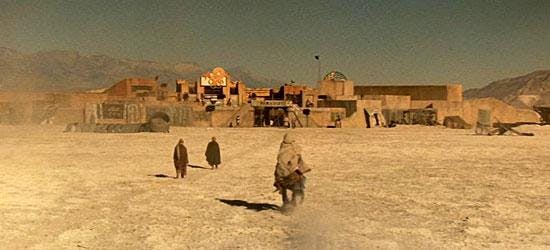
The Final Frontier is widely regarded as the least successful TOS feature. Despite a genuinely daring and thought-provoking premise -- searching for God -- the general perception was, is and will likely forever be that the film just doesn't work. Too much around the central premise doesn't play as intended. Nothing operational on the Enterprise? Scotty bumping into things? "Row, Row, Row Your Boat" sung around a campfire? Cringe-worthy lines like "On the contrary, gravity is the foremost thing on my mind" or "Please, captain, not in front of the Klingons," didn't help, nor did lackluster visual effects.
So, some questions to ponder, lines to remember and factoids to absorb...

-- First, what did YOU think of the infamous campfire scene?
-- Was the search for God too big an idea for even Star Trek to tackle?
-- The film, in our view, was almost redeemed by two memorable Kirk lines, "Excuse me. Excuse me... but what does God need with a starship?" and "Who am I? Don't you know? Aren't you... God?"
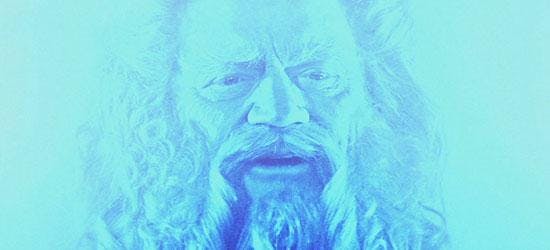
-- Runner up: McCoy referring to Spock: "God, I liked him better before he died."
-- Another good one, from Sybok: "I don't control minds. I free them."
-- At one point, The Final Frontier and Star Trek: The Next Generation filmed next door to one another on the Paramount Pictures lot.
-- Pretty much everyone on the planet knows this, but first choice to play Sybok was... Sean Connery. The reference to Sha Ka Ree is a tip of the cap to the actor.
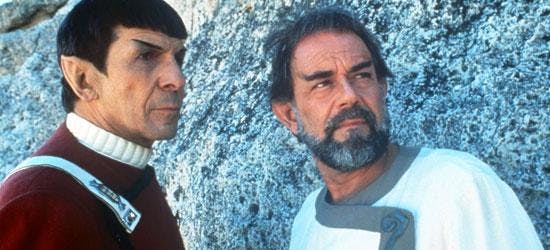
-- Laurence Luckinbill, who did play Sybok, was the son-in-law of Lucille Ball. It was Ball and her company, Desilu, that first green-lit The Original Series.
-- George Murdock, who co-starred as God, went on to play Admiral Hanson in the TNG two-parter, " The Best of Both Worlds ." The actor passed away in 2012 at the age of 81.
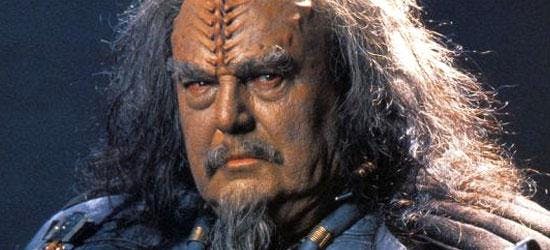
-- Charles Cooper, who played Klingon General Korrd, later appeared on TNG as Klingon Chancellor K'mpec in " Sins of the Father " and " Reunion ." He died at the age of 87 in 2013.
-- The Final Frontier grossed a strong $17 million its opening weekend, but tallied only $52 million during its entire theatrical run.
Get Updates By Email
Screen Rant
Why time is star trek's true final frontier.
Star Trek: Picard season 2 brings back Q for a new adventure dealing with time travel. Here's why Picard is making time more important in Star Trek.
Star Trek: Picard season 2 will focus on time travel because, as Jean-Puc Picard (Patrick Stewart) himself declared, time is Star Trek 's true final frontier. Picard and his motley crew, including Seven of Nine (Jeri Ryan), Soji (Isa Briones), and Raffi Musiker (Michelle Hurd), return in Star Trek: Picard season 2, which will also reintroduce the omnipotent being Q (John de Lancie). The last time Picard and Q tangled was in Star Trek: The Next Generation 's series finale, "All Good Things", which was also a time travel adventure.
Star Trek in all of its incarnations is about seeking out new lifeforms and new civilizations in the infinite expanse of space, but Star Trek has also delivered numerous incredible stories about time travel. Time travel adventures are tricky and can often backfire. But with classic tales like Star Trek: The Original Series ' "The City on the Edge of Forever", Star Trek IV: The Voyage Home , and even the return of the Guardian of Forever in Star Trek: Discovery season 2, Star Trek has dealt with time travel arguably better than any other sci-fi franchise. Indeed, while there are always new worlds and aliens to be found, Star Trek 's physical universe - depicted as the 4 Quadrants of the galaxy: Alpha, Beta, Delta, and Gamma - has been well-explored over the franchise's 500+ episodes of TV and 13 movies. Time, however, is an entirely different frontier altogether.
Related: Star Trek Picard Season 2 Trailer Breakdown: 12 Story Reveals
In Star Trek: Picard 's season 2 trailer, Jean-Luc's words that "time is the true final frontier" challenge the franchise's traditional mission statement that space is the final frontier. It also harkens back to what Dr. Tolian Soran (Malcolm McDowell) told Captain Picard in Star Trek: Generations : "Time is the fire in which we burn." In that film, Soran's separation from the Nexus, a galactic energy ribbon where the laws of time and space don't apply, drove him mad, and Soran planned to destroy a star and entire planets just so he could return to the Nexus. In Star Trek: Picard 's season 2 trailer, Jean-Luc continues his musings about how time marches forward in a linear fashion and all of our actions, for good or ill-considered, are inevitably turned into history. This also leaves infinite room for regret and wondering about what could have been if other choices were made.
In his Star Trek First Contact Day panel, Stewart was careful not to reveal any details but he hinted that Star Trek: Picard season 2 would deal with "times" (plural) and that "events coming up in [Picard] season 2... have never been seen before" despite 178 episodes and 4 TNG movies. The presence of Q, who has powers over time, space, and reality, bodes a story about Picard possibly confronting past regrets and shedding new light on familiar moments, perhaps in a "What If" fashion.
Along with an hourglass with time moving backward, there's also a compelling Easter egg in Star Trek: Picard 's season 2 trailer: The Reckoning tablet is displayed in Jean-Luc's study. The tablet is an ancient Bajoran artifact seen in Star Trek: Deep Space Nine that Captain Benjamin Sisko (Avery Brooks) shattered, which released a trapped Prophet and Pah-Wraith, the powerful beings worshipped as gods by the Bajorans. This could also hint at the involvement of the Prophets, who exist in non-linear time. Fans are also hoping that this could mean an appearance by Avery Brooks as Ben Sisko, the Emissary of the Prophets who also became a celestial being when DS9 ended.
Meanwhile, Star Trek: Discovery season 3 touched upon the Temporal Wars, which were introduced in the prequel Star Trek: Enterprise . It's possible Star Trek: Picard season 2's meddling with the timeline could be the flashpoint that instigates the Temporal Wars, which also involved the alternate Kelvin Timeline of J.J. Abrams' Star Trek movies . Overall, Star Trek: Picard 's new direction in season 2 is compelling and could have massive consequences for the galaxy, just as season 1 dealt with the fallout of the Romulan star going supernova and the future of synthetics in the Alpha Quadrant. Star Trek: Picard looks to explore time as the new final frontier beyond Star Trek's traditional milieu of starships voyaging through outer space.
Next: Star Trek: All 4 Shows Captain Picard Appears In Explained

Science & Technology
Esa science & technology - space... the final frontier [heic1615].
- Show All Missions
- About Hubble
- Hubble history
- Hubble instruments
- Engineering
- Operating Hubble
- Science Archive
- News Archive
- Multimedia Gallery
- Publication Archive
- Calendar of Events
- Terms and Conditions
Asset Publisher
Space... the final frontier [heic1615].
21 July 2016
Space... the final frontier. These are the stories of the Hubble Space Telescope. Its continuing mission, to explore strange new worlds and to boldly look where no telescope has looked before.
The newest target of Hubble's mission is the distant galaxy cluster Abell S1063, potentially home to billions of strange new worlds.
This view of the cluster, which can be seen in the centre of the image, shows it as it was four billion years ago. But Abell S1063 allows us to explore a time even earlier than this, where no telescope has really looked before. The huge mass of the cluster distorts and magnifies the light from galaxies that lie behind it due to an effect called gravitational lensing. This allows Hubble to see galaxies that would otherwise be too faint to observe and makes it possible to search for, and study, the very first generation of galaxies in the Universe. "Fascinating" , as a famous Vulcan might say.
The first results from the data on Abell S1063 promise some remarkable new discoveries. Already, a galaxy has been found that is observed as it was just a billion years after the Big Bang.
Astronomers have also identified sixteen background galaxies whose light has been distorted by the cluster, causing multiple images of them to appear on the sky. This will help astronomers to improve their models of the distribution of both ordinary and dark matter in the galaxy cluster, as it is the gravity from these that causes the distorting effects. These models are key to understanding the mysterious nature of dark matter.
Abell S1063 is not alone in its ability to bend light from background galaxies, nor is it the only one of these huge cosmic lenses to be studied using Hubble. Three other clusters have already been observed as part of the Frontier Fields programme , and two more will be observed over the next few years, giving astronomers a remarkable picture of how they work and what lies both within and beyond them [1] .
Data gathered from the previous galaxy clusters were studied by teams all over the world, enabling them to make important discoveries, among them galaxies that existed only hundreds of million years after the Big Bang ( heic1523 ) and the first predicted appearance of a gravitationally lensed supernova ( heic1525 ).
Such an extensive international collaboration would have made Gene Roddenberry, the father of Star Trek, proud. In the fictional world Roddenberry created, a diverse crew work together to peacefully explore the Universe. This dream is partially achieved by the Hubble programme in which the European Space Agency (ESA), supported by 22 member states, and NASA collaborate to operate one of the most sophisticated scientific instruments in the world. Not to mention the scores of other international science teams that cross state, country and continental borders to achieve their scientific aims.
[1] The Hubble Frontier Fields is a three-year, 840-orbit programme which will yield the deepest views of the Universe to date, combining the power of Hubble with the gravitational amplification of light around six different galaxy clusters to explore more distant regions of space than could otherwise be seen.
More information
The Hubble Space Telescope is a project of international cooperation between ESA and NASA.
ShortUrl Portlet
Https://sci.esa.int/s/a1gaklw, images and videos.

Abell S1063, the final frontier
Parallel field of abell s1063, wide-field image of abell s1063 (ground-based image).

Related Publications
Related links, related videos [heic1615], frontier fields, documentation.
Final frontier: 'Star Trek: Nemesis' marked the end of an era 20 years ago today
Raise a glass of Romulan ale for this final "Star Trek" film starring "The Next Generation" cast
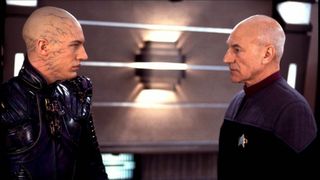
Overshadowed by competition and often unloved by fans, "Star Trek: Nemesis" celebrates its 20th birthday today as the tenth movie in the franchise and the final "Star Trek" film to feature Patrick Stewart's Captain Jean-Luc Picard and "The Next Generation's" intrepid crew.
After the somewhat tepid box office and critical flaying of 1998's " Star Trek: Insurrection ," interest was waning in the aging " Star Trek " franchise and audiences were turning to "Star Wars" sequels, "Harry Potter" movies, and "The Lord of the Rings" films to get their sci-fi/fantasy fix.
" Star Trek: Nemesis " was cast into the mix in the wake of its previous "Star Trek" sibling during the holiday season where it floundered against other tentpole releases like "Harry Potter and the Chamber of Secrets," "The Santa Clause 2," and "The Lord of the Rings: The Two Towers." When the tinsel finally settled it had only raked in a paltry $67 million in worldwide box office receipts.
Related: Star Trek movies, ranked worst to best

One year of Paramount Plus - was $49.99/year now $24.99/year . Paramount is offering 50% off its two plan levels, allowing you to get a deep discount whether you choose ads or not. The Essential plan is now $24.99, or if you want uninterrupted streaming you can go for the Premium plan for just $49.99.
Dropped into the crowded popular entertainment galaxy on Dec. 13, 2002 and directed by British filmmaker Stuart Baird, "Star Trek: Nemesis" has Picard altering the USS Enterprise's course following a scheduled rendezvous for Commander Riker (Jonathan Frakes) and Counselor Troi's (Marina Sirtis) wedding ceremony, to a tenuous peace treaty negotiation with the Romulans, who had rejected a plan to untie the forces of the planets Romulus and Remus.
Picard is soon shocked to learn that Shinzon (Tom Hardy), the recently "appointed" Praetor of the Romulans after a deadly coup, is actually a cloned Reman derived from his DNA to replace the venerable leader with a Romulan agent in the heart of Starfleet. After Enterprise crew members stumble across a computer system hack, a perilous game is played to thwart Shinzon and his Romulan warbird from completing a plan to attack Earth and cripple the Federation's armada.
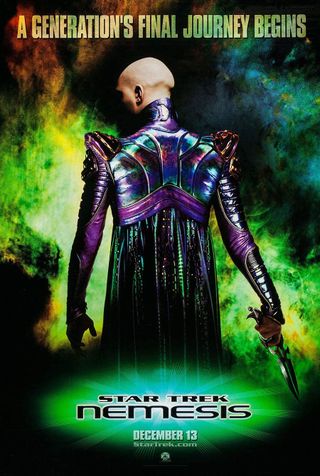
Baird does a serviceable job keeping plot mechanics moving in this $60 million sequel, but there's a glaring absence of depth that begins to feel tedious after the initial narrative revelations. It's a handsome movie though, shot by "Top Gun" and "Mission Impossible 2" cinematographer Jeffrey L. Kimball, yet disappointingly infused with a forgettable orchestral score by the Academy Award-winning composer Jerry Goldsmith ("Planet of the Apes," " Alien ," "Star Trek: First Contact").
Get the Space.com Newsletter
Breaking space news, the latest updates on rocket launches, skywatching events and more!
Stuart Baird's resume included editorial duties on classics like "The Omen," "Superman: The Movie," "Lethal Weapon," "Die Hard 2," and "Demolition Man," which explains the film's fluidity and momentum despite being shackled to John Logan's inert screenplay.

Looking a bit like "Hellraisers'" Pinhead minus the studs, a young Tom Hardy is charismatic as the intense rebel chieftain. He's certainly up to the task of holding his own against the imposing talents of Stewart and their interplay and exchanges make for compelling drama.
And who can forget Data (Brett Spiner) singing "Blue Skies" at the nuptials, the sentient android discovering a younger prototype of himself, and Data's sacrificial death in the climactic scenes. Veteran character actor Ron Perlman ("Hellboy") also shines as Shinzon's Viceroy Vkruk, who carries an air of warrior-like menace though his screen lines are kept to a bare minimum.
"Nemesis'" visual effects and sets are impressive, especially the design of the intimidating Reman warbird, the Scimitar, glimpses of the dilithium mines of Remus where Shinzon was held for ten years as a slave, and the steel-buckling ramming of the Scimitar by the Enterprise in the showdown finale.

The wordiness of "Star Trek: Nemesis" and its tepid melodrama might not have been the "Star Trek" film we wanted to close out the legacy of cinematic sequels that had existed after 1978's "Star Trek: The Motion Picture," but it's still an engaging entry with a professional sheen and enough interesting performances to warrant a repeat viewing, especially on the occasion of its 20th anniversary.
It would be seven long years after "Nemesis" before J.J. Abrams rebooted the franchise in 2009 with "Star Trek" and its Kelvin Timeline, a similarly tenuous position the theatrical series now finds itself in after director Justin Lin's mediocre 2016 entry, "Star Trek Beyond." Will blue skies shine for the franchise once again?
"Star Trek: Nemesis" is currently streaming on HBO Max and Paramount+.
Follow us on Twitter @Spacedotcom or on Facebook .
Join our Space Forums to keep talking space on the latest missions, night sky and more! And if you have a news tip, correction or comment, let us know at: [email protected].

Jeff Spry is an award-winning screenwriter and veteran freelance journalist covering TV, movies, video games, books, and comics. His work has appeared at SYFY Wire, Inverse, Collider, Bleeding Cool and elsewhere. Jeff lives in beautiful Bend, Oregon amid the ponderosa pines, classic muscle cars, a crypt of collector horror comics, and two loyal English Setters.
This Week In Space podcast: Episode 108 — Starliner: Better Late Than Never?
5 sci-fi movies that weren't great but still deserve a sequel
Russia vetoes UN resolution against nuclear weapons in space
- doinla nemesis 38 rotten 49 audience 67 million beyond 86 rotten 80 audience 343 million Reply
- View All 1 Comment
Most Popular
- 2 Beavers are helping fight climate change, satellite data shows
- 3 Astronomers just discovered a comet that could be brighter than most stars when we see it next year. Or will it?
- 4 This Week In Space podcast: Episode 108 — Starliner: Better Late Than Never?
- 5 Boeing's Starliner spacecraft will not fly private missions yet, officials say
- The Original Series
- The Animated Series
- The Next Generation
- Deep Space Nine
- Strange New Worlds
- Lower Decks
- Star Trek Movies
- TrekCore on Twitter
- TrekCore on Facebook

Commander Rayner (Callum Keith Rennie) isn’t thrilled by this prospect, pointing out before she leaves that it’s too dangerous a mission for a captain to undertake. But Burnham disagrees that this is enough of a reason to stop her; it’s a nice reminder that this is a show and a character that originated in the time of James T. Kirk, a time when captains didn’t stay behind in the face of danger.
But it’s not only that, there’s something else going on. Burnham gives Rayner permission to be blunt, quoting a classic work on Rayner’s native Kellerun , The Ballad of Krull , asking him to “serve it without a crumb of ossekat .” (As far as made-up Star Trek idioms go, that’s a pretty good one.)
It’s also the beginning of a sudden and relentless onslaught of references to Rayner’s culture, but more on that later. What’s Rayner’s problem? He’s uncomfortable with the prospect of being left in command of a ship and crew that aren’t “his.” Welcome to being second in command, buddy.
Book and Burnham take off, heading into the wormhole and finding it to be an inhospitable place. They quickly drop out of communication range with Discovery , there’s ship debris everywhere, including the wreckage of Moll and L’ak’s ship…. and what’s that, the ISS Enterprise ?!
(A side note before we get too excited about that: what is the deal with all the empty space in the new shuttlecraft set, introduced in last season’s “All Is Possible”? The two pilot seats looked like they were crammed into the corner of a huge unfurnished room.)
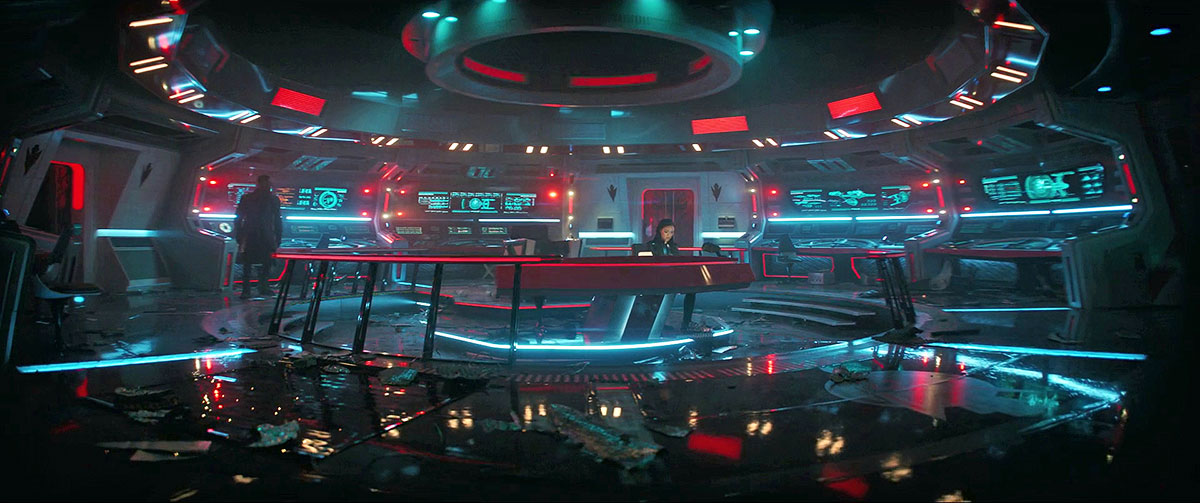
Okay, Enterprise time. Burnham and Book rightly surmise that this is where Moll and L’ak must have escaped to and beam to the ship, which of course turns out to be a redress of the Strange New Worlds standing sets. A quick scan identifies that no one else is aboard — though the clue, which Moll and L’ak have found, does also have a lifesign, hmm — and that Moll and L’ak are holed up in sickbay. Burnham takes a few moments to ponder her visit to the Mirror Universe back in Season 1 and wonder what the alternate version of her half-brother Spock might have been like (bearded, for one).
And aside from some brief storytelling about Mirror Saru’s role as a rebel leader, that’s about it for the Terran Empire of it all. Star Trek: Discovery has spent plenty of time in and around the Mirror Universe already, and I personally don’t think they need to revisit it again. But introducing the ISS Enterprise — the ship that started it all with The Original Series ’ “Mirror, Mirror” — and then not doing anything momentous with it? Strange decision, and one that makes it ultimately feel more like this was a way for the show to get to reuse a set on the cheap than it does a materially significant addition to the episode.
In fact, in some ways it’s actually a detriment to the episode. If the action had been set on any other ship it would have been fine, but being on the ISS Enterprise I kept expecting something — like seeing Paul Wesley as Mirror Kirk slinking around, or finding Anson Mount camping it up as Mirror Pike in a personal log. If they’d set the action on a generic derelict ship, what we got wouldn’t have seemed like a let down. As it is though, I kept waiting for the other shoe to drop… and it simply never did.
Maybe in a subsequent episode, it’ll turn out that there’s an advantage in having an entire functional starship composed of atoms from another universe at Starfleet’s disposal — or to have a convenient collection of Constitution -class sets available for that Starfleet Academy show to borrow once in a while — but until that happens (if it even does) the use of the ISS Enterprise just seems like a name drop and a “We have to set the action somewhere , why not here?” instead of a significant use of the setting and the huge amount of lore and history that comes with it.
It’s like setting something aboard the Titanic without ever mentioning any icebergs.
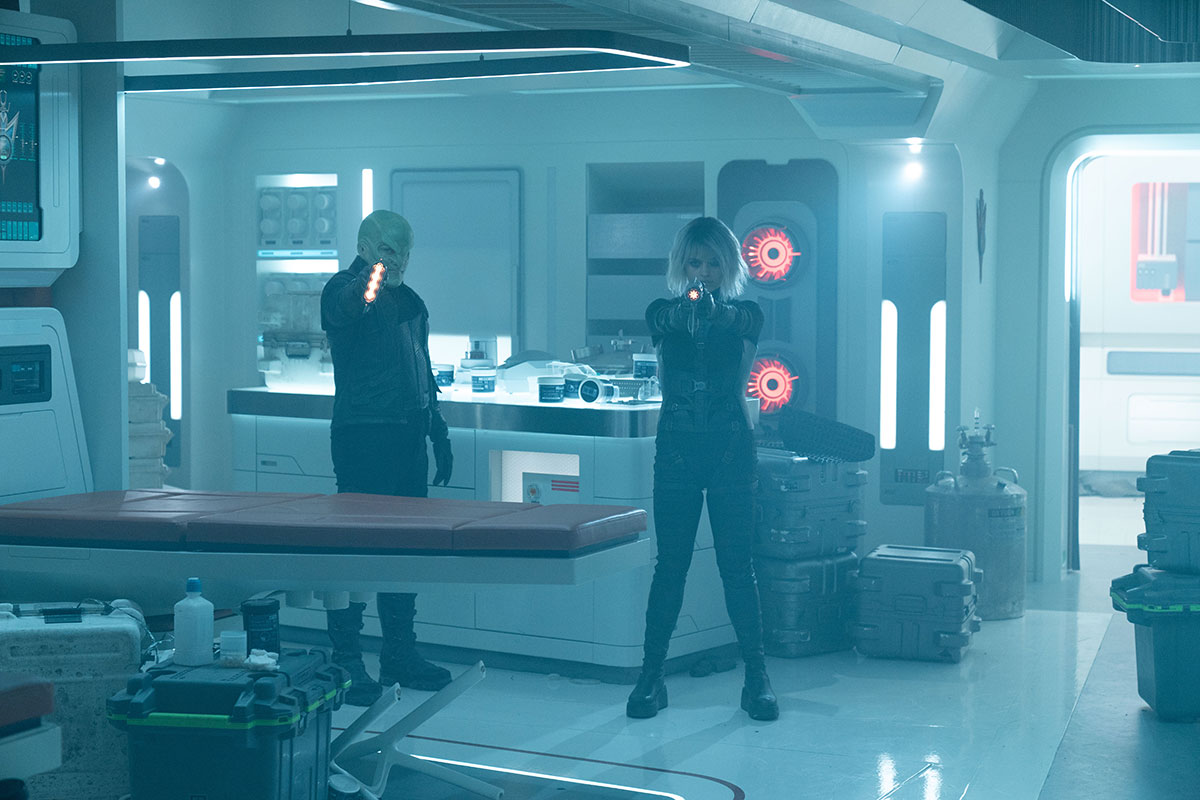
As Burnham and Book make their way down to sickbay they do find evidence that the ship was being used in a way that seemed unusually gentle for a Terran Empire vessel: signs that children and families were aboard at one time, and that they were the kind of people sentimental enough to have keepsakes and favorite stuffed animals. But again, nothing about this seems like it needs the Mirror Universe connection. Ships of people trying to escape adversity are already a Star Trek staple.
Burnham and Book find Moll (Eve Harlow) and L’ak (Elias Toufexis) in sickbay, and after a valiant but ultimately unsuccessful attempt at getting them to surrender, everyone starts shooting. Moll and L’ak have a Breen blood bounty — an erigah — on their heads and surrender is simply not an option. During the firefight a lockdown is triggered, forcefields coming down that split the group into pairs: Burnham and L’ak stuck in sickbay, while Book and Moll able to go back to the bridge to try and reset sickbay.
Pairing off also gives Book the opportunity to continue his efforts to connect with Moll, and I have to say, I don’t think I’m a fan. Setting aside the portion of this that’s purely a strategic attempt to forge a connection with someone who is very to keen to kill him, my first reaction to the way Book talks to Moll about her father (and his mentor) was distaste.
I don’t think Book meant it this way, but the way he’s written in these scenes feels unpleasantly close to the “Well, he was a great guy to me , I never saw him do anything bad” response that’s sometimes made to accusations of misconduct. A person can be wonderful to some people in their life and terrible to others; both experiences are true for the people who received them, but they’re not mutually exclusive.
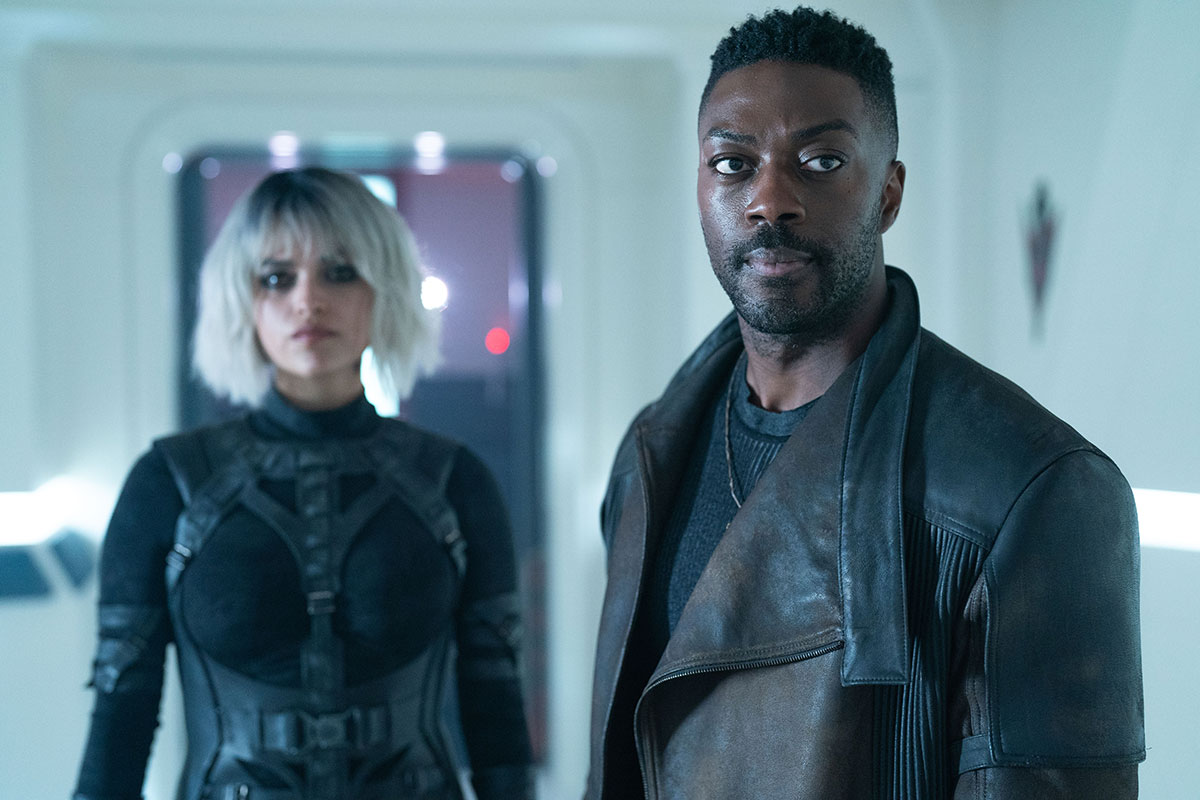
Book is preternaturally empathetic, and yet he doesn’t seem to see how continually assuring Moll that her father loved her is an act that’s both unwanted and actively painful for Moll to hear. I understand that Book is just trying to bring a sliver of comfort to Moll – but in the process he’s dismissing her own experiences of her father and his place in her life. Unless Moll asks him for this, it’s really none of Book’s business.
I suspect they’re setting up Moll’s character for a nice, cathartic arc where she comes to terms with her life, forgives her father, releases her past, whatever. And when that happens in real life that’s great — but it doesn’t always, and that’s okay too. If Moll never sees in her father the man Book saw in his mentor, it’s not a character failing. Discovery is really hammering home the theme of confronting one’s past in order to take control of one’s present and future, and I think it would be valuable if they included an example of a character learning to do the latter… without having to be okay with the former.
And to return to a question I posed in my review of “Under the Twin Moons,” I know Book is isolated and excruciatingly lonely after the destruction of Kweijan and his split with Michael, but the weight he’s placed on his relationship with Moll as “the closest thing he has to family” seems like he’s setting himself up for disappointment. Maybe I’m just a cynic, but this does not feel like a hopeful storyline to me. Not everyone wants to be family, and right now it doesn’t seem like Moll’s been given much of a choice in the matter — despite her frequent and very powerful explanations of why she’s not interested.
Clearly frustrated with Book’s topic of conversation and desperate to return to L’ak, Moll makes a reckless decision to brute-force a solution and overload some circuits. It works, and the forcefields in sickbay come down, but it also sends the Enterprise onto an unstoppable collision course with the too-small-to-pass-through and also going-to-be-closing-forever-soon wormhole. They’ve got eight minutes to figure this out.

Meanwhile aboard Discovery , we see Rayner’s struggles to interact with the crew. This thread could have gone so many different ways, Rayner seeming “too good” for a temporary command, him seeing this as his chance to do things “better” than Burnham or show how it’s “really done,” but instead the show takes the much more subtle and satisfying route: Rayner is deeply respectful of the captaincy, as a rank and a role, and really doesn’t want to step on Burnham’s authority.
He’s more than willing to disagree with her on command decisions , but he doesn’t question her command . And more personally, he doesn’t want his gruffness and lack of experience with this crew to cause problems. He’s trying, in his own Rayner way, and more importantly he’s succeeding — and, as we see as he shepherds the crew through figuring out how to communicate with and then rescue Book and Burnham, the crew does their part and meets him halfway.
Rayner is learning that he needs to tone down his temperament just enough that he doesn’t come across as an actual asshole to this crew, and the crew is learning that his gruffness isn’t a sign of disrespect but simply a desire to cut to the chase and get to direct, actionable information with a minimum of fluff. There are shades of Nimoy’s Spock or Voyager -era Seven of Nine here, but couched within a distinctly different temperament, and it’s fascinating to watch. I’d love to have seen him interacting with the crew of the Antares , where he presumably felt more comfortable.
The interpersonal stuff with Rayner and the crew is great; where Rayner’s thread feels distractingly like a box being checked is the explosion of “Rayner is a Kellerun!” being shouted from the bulkheads. I could practically hear the writers yelping out a panicked “Oh crap, we forgot to say what kind of alien Rayner is!”
Again, Discovery is back to its old self with the clunky, heavy-handed, and oddly paced character work. Rayner goes from having zero cultural touchstones to having about five in the span of the 15-20 minutes of screentime that his story gets this week. They’re good touchstones, don’t get me wrong — I’m skeptical of Kellerun citrus mash, I have to be honest, but I’d give it a try; not so sure about boiling a cake though — they’re just very present .
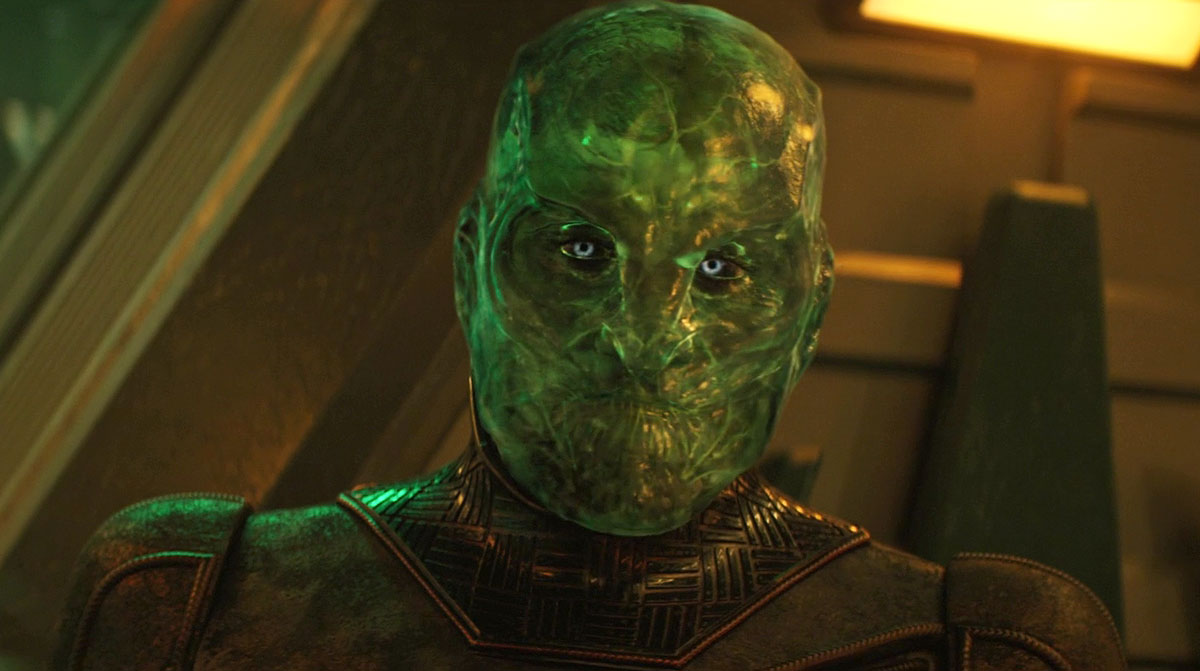
As with Rayner’s alienness, the frequent flashbacks throughout the episode to Moll and L’ak’s meeting and courtship feel like a “We forgot to explain this and now we’re trying to reference it!” correction. The content of the flashbacks is fine, there’s a lot of interesting Breen worldbuilding for a species that’s been mysterious from the start — and watching Moll and L’ak’s relationship grow from one of mutual convenience to one of true love is genuinely moving. But the way it’s woven into an episode that, again, feels like it’s composed of bits and pieces of storyline, makes it hard to shake the sense that I was watching a To Do list get checked off.
By the time the season is over it might be clear that there was simply no extra room to give a full episode over to Moll and L’ak’s meeting, or maybe an episode without any of the main cast wasn’t something they were willing or contractually able to do, but I would have loved if these flashbacks were pulled out and expanded into a full-length episode of their own. Some of the worldbuilding felt hasty to the point of hindering the emotional beats — at times I wondered if I’d forgotten a whole bunch of Breen lore and at others I was just trying to keep up with what was going on.
For example, my confusion about L’ak’s comment about having two faces, which Moll seemed to completely understand — “Duh, everyone knows the Breen have two faces” — was a distraction in the middle of an otherwise nice and significant moment. This is later clarified as the translucent face and the solid face, but again I was distracted from fully appreciating an interesting bit of Breen culture because I was busy applying what I’d just learned back to the previous scene.
The quickly (and maybe not totally clearly articulated notion) that Breen deliberately restrict themselves to their translucent form for reasons that are entirely to do with avoiding any perception of weakness is a potent if hasty bit of social commentary, and as I said I nearly didn’t catch it.
Whether holding the translucent form requires the armor for protection or the armor necessitates the translucent form — it seems like it would be more comfortable wearing that helmet all the time if you were the texture and consistency of lime jello — this is surely a metaphor for the increasingly rigid, isolating, and emotionally and sometimes physically unhealthy things men in certain circles feel they must do to be appropriately masculine. Seeing L’ak free himself from that rigidity is powerful.
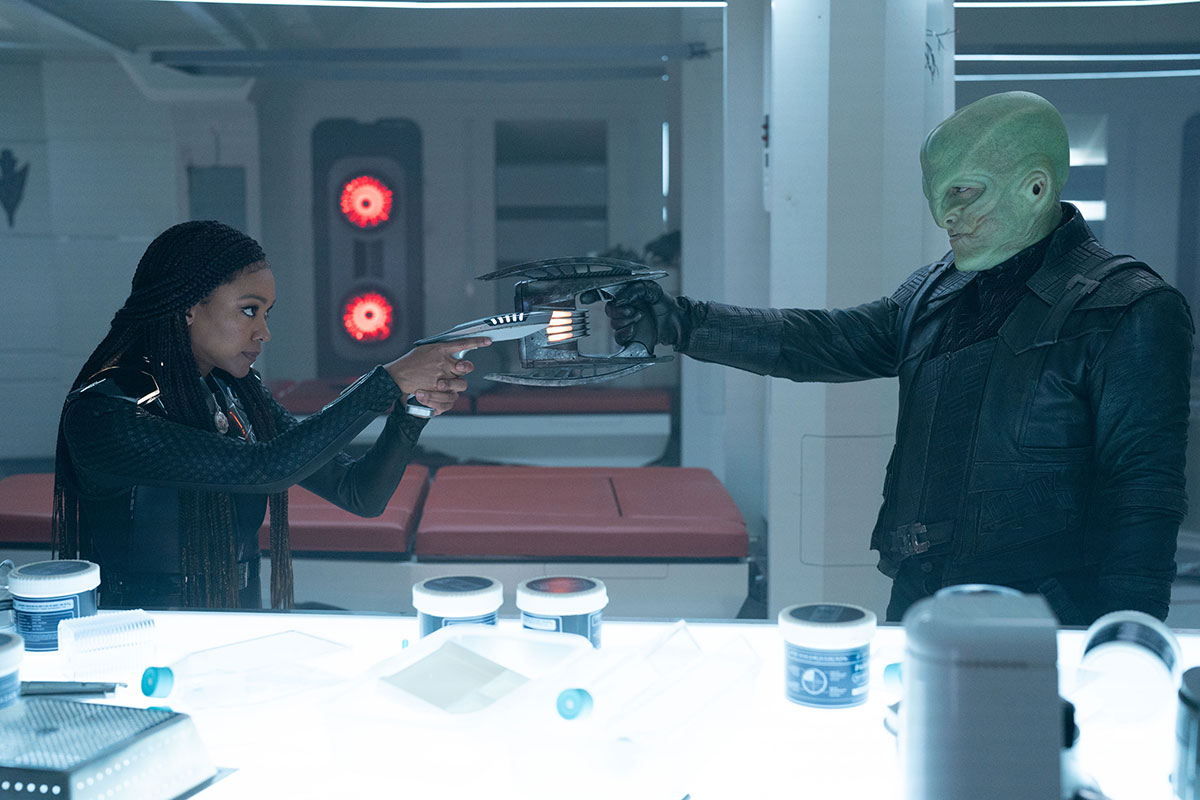
With the forcefields in sickbay down, Burnham and L’ak immediately spring into action: Burnham trying to get the artifact from L’ak and L’ak simply trying to get away. They fight, and Burnham impressively proves she can hold her own against a Breen. When L’ak accidentally falls on his own blade, Burnham grabs the clue and speeds to the bridge where she manages to get a message to Rayner through some tractor beam trickery. The message? Another reference to that classic of Kellerun literature that gives Rayner the info he needs. Hey, did you know Rayner was a Kellerun?
The ISS Enterprise makes it through the wormhole, Moll and L’ak zip away in an escape pod, and it’s time to wrap things up. We head to Red’s for a quick but significant moment between Tilly (Mary Wiseman) and Culber (Wilson Cruz), as Tilly offers advice and an ear to a Culber who’s going through a quiet existential – maybe also spiritual? – crisis.
OBSERVATION LOUNGE
- In addition to the dedication plaques on the bridge, the ISS Enterprise has an additional plaque in its transporter room — one which, despite recounting the heroism of rebel action hero Mirror Saru, still states “Long Live the Empire.”
- The transporter room plaque is marked with “Stardate 32336.6,” which is about 9 years before the events of “Encounter at Farpoint.”
- The plaque describes the fate of Mirror Spock, who was killed after instituting the reforms which later led to the fall of the Terran Empire (as described in DS9’s “Crossover”).

The full text of the ISS Enterprise transporter room plaque:
The new High Chancellor presented hope and justice as if they were natural to our world. His words, “The light of hope shines through even the darkest of nights” became our rallying cry. He spoke of reform, and changed many of us. But some saw this as weakness. They killed him, and we sought help from an unlikely ally: A Kelpien slave turned rebel leader. He spoke of visitors from another world… a near perfect mirror cast our darkness into light. With his aid we secured the Enterprise and stayed behind to continue his work. We bear scars from our escape, but our hope remains. May it carry us into a pristine, peaceful, and just future.
- Not counting L’ak’s previous appearances this season, this episode marks the first time we have seen the Breen in live action since their involvement in the Dominion War in Deep Space Nine. (The species has appeared in Star Trek: Lower Decks three times.)
- The 32nd century Breen wear updated encounter suits clearly based on the designs introduced in Deep Space Nine ; their digital speech is extremely faithful to the incomprehensible noises Breen soldiers have spoken in past appearances.
- Given the fact that Moll appears to be just fine in the environment of the Breen ship, I guess Weyoun was right when he said the Breen homeworld was “quite comfortable” in “The Changing Face of Evil.”
- When L’ak is stabbed he gently oozes some green goo — but as we learned in “In Purgatory’s Shadow,” Breen do not have traditional humanoid blood.
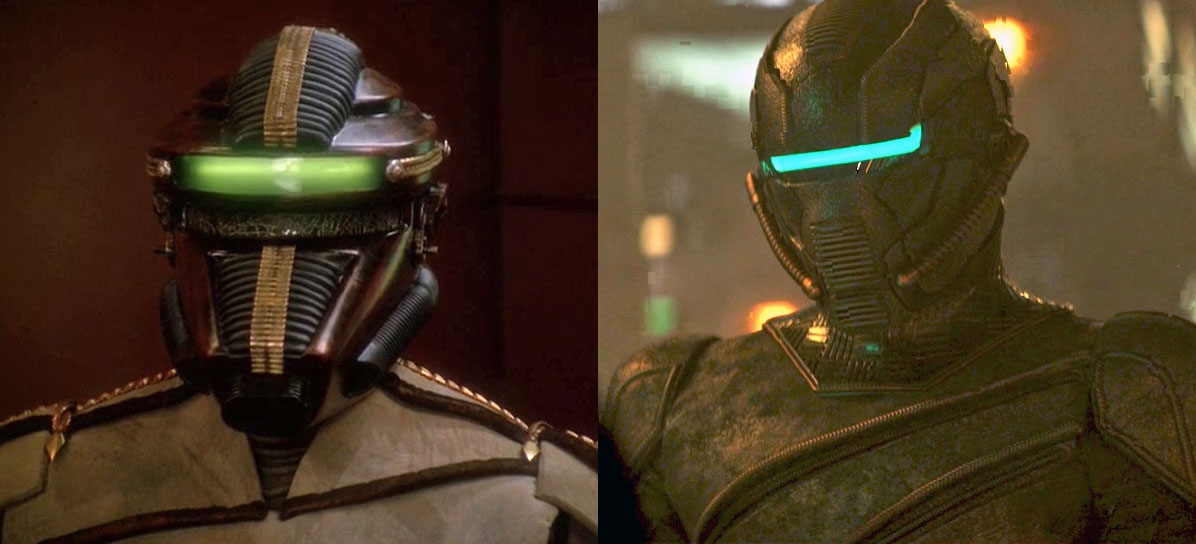
- During his time in command of Discovery , Rayner never sits in the captain’s chair.
- This episode closes with a dedication plaque that reads “In loving memory of our friend, Allan ‘Red’ Marceta”. Marceta was, I presume, the namesake for Discovery’s bar.
- Someone aboard Discovery keeps a Cardassian vole as a pet. Going by Tilly’s reaction, and what we know from Deep Space Nine , this is not a good thing.
- Linus (David Benjamin Tomlinson) plays a mean piano.
- Owosekun and Detmer get the off-screen cherry assignment of flying the ISS Enterprise back to Federation Headquarters, alone. I’m thinking that’s going to inspire some fanfic…

We don’t learn what this week’s clue is, though we know there’s a blue vial tucked away inside it, but we do learn that the crew of the ISS Enterprise did indeed make it to our universe. The scientist responsible for hiding this particular clue there was one of them, a Dr. Cho, who eventually made it all the way to branch admiral.
They strove for something positive and succeeded against all odds. Hopefully Discovery will be able to do the same as they continue their pursuit of Moll, L’ak, and the Progenitors.
Star Trek: Discovery Season 5 returns with “Whistlespeak” on Thursday, May 2.
- DSC Season 5
- Star Trek: Discovery
Related Stories
New star trek: discovery photos — “whistlespeak”, new star trek: discovery photos — “mirrors”, interview — sonequa martin-green on burnham’s “face the strange” encounter, search news archives, new & upcoming releases, featured stories, lost-for-decades original star trek uss enterprise model returned to roddenberry family, star trek: lower decks cancelled; strange new worlds renewed for season 4, our star trek: discovery season 5 spoiler-free review.
TrekCore.com is not endorsed, sponsored or affiliated with Paramount, CBS Studios, or the Star Trek franchise. All Star Trek images, trademarks and logos are owned by CBS Studios Inc. and/or Paramount. All original TrekCore.com content and the WeeklyTrek podcast (c) 2024 Trapezoid Media, LLC. · Terms & Conditions

Hi, what are you looking for?
TREKNEWS.NET | Your daily dose of Star Trek news and opinion
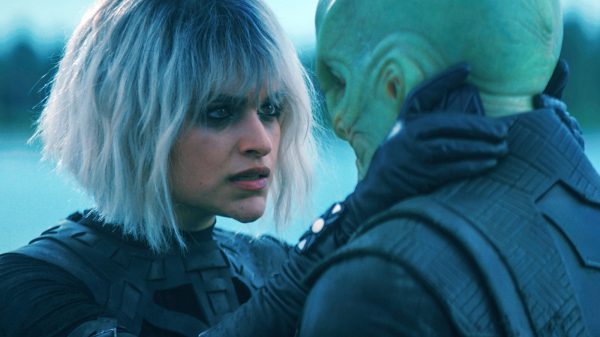
New photos from Star Trek: Discovery Season 5 Episode 4 “Face the Strange”
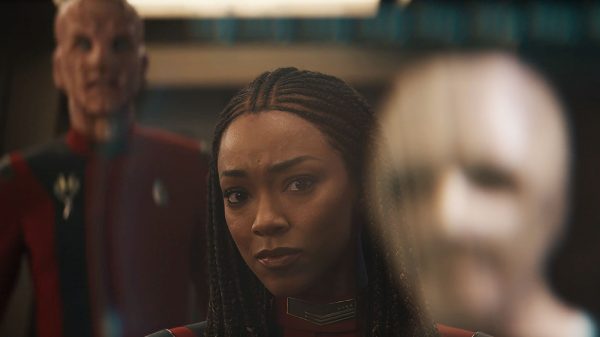
Star Trek: Discovery “Under the Twin Moons” Review: Clues among the moons
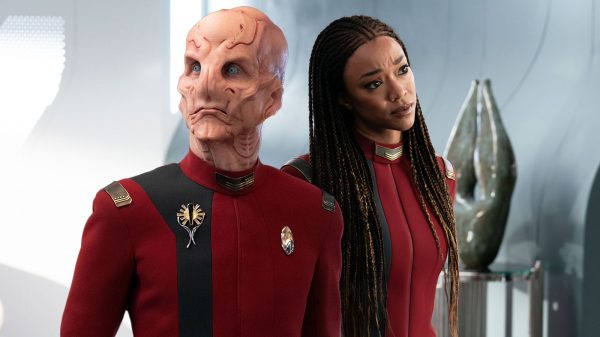
New photos from the first two episodes of Star Trek: Discovery season 5
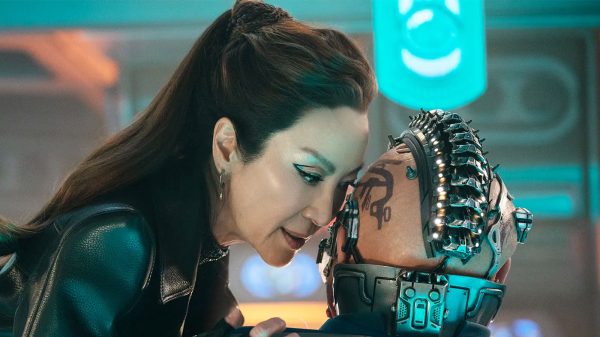
First Photo from Star Trek: Section 31 revealed, legacy character confirmed
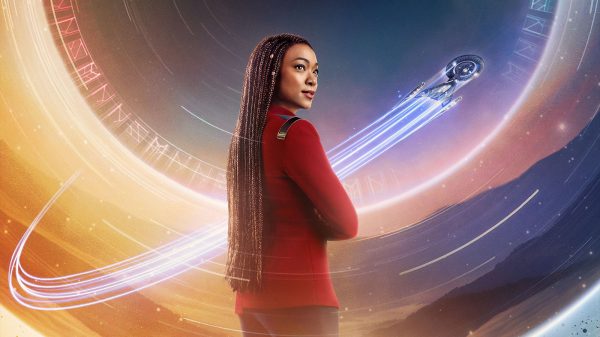
New Star Trek: Discovery posters revealed ahead of final season premiere
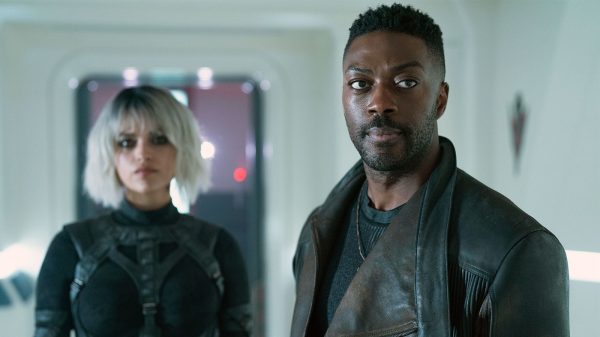
Star Trek: Discovery “Mirrors” Review: Navigating Reflections
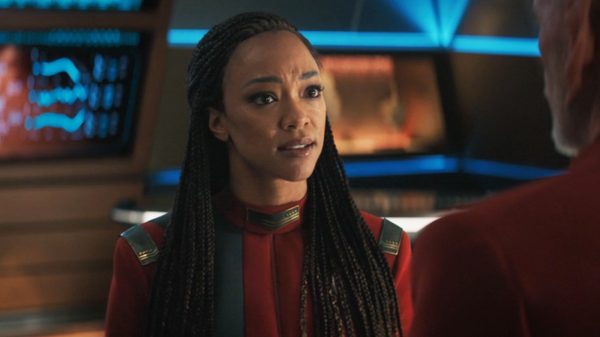
Star Trek: Discovery “Face the Strange” Review: Embarking on a Temporal Odyssey
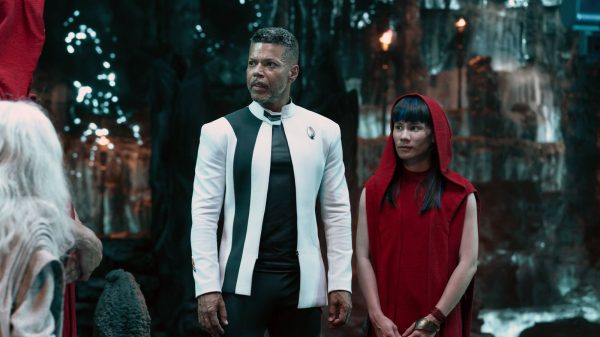
Star Trek: Discovery “Jinaal” Review: One step forward, two steps back
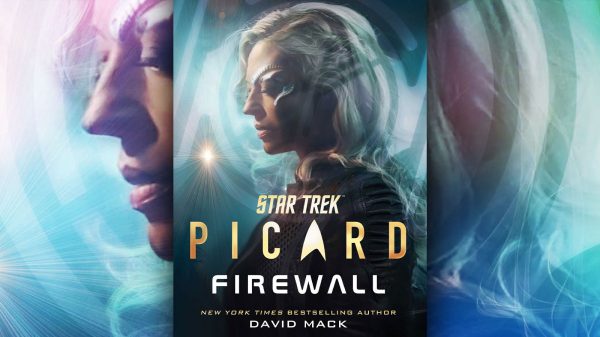
Star Trek: Picard — Firewall Review: The Renaissance of Seven of Nine
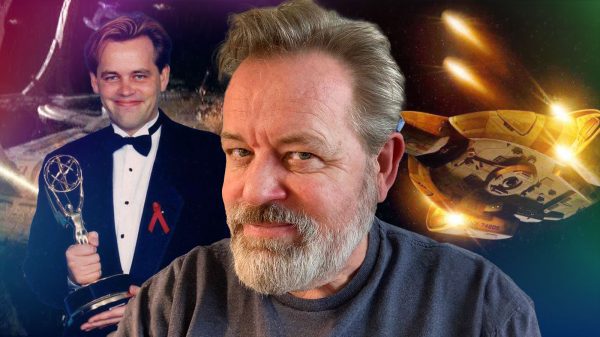
From TNG to Enterprise, Star Trek VFX Maestro, Adam Howard, shares stories from his career
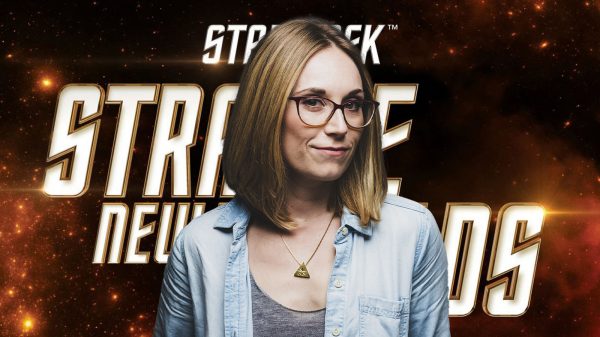
Strange New Worlds director Jordan Canning talks “Charades,” the versatility of the series & Star Trek fandom
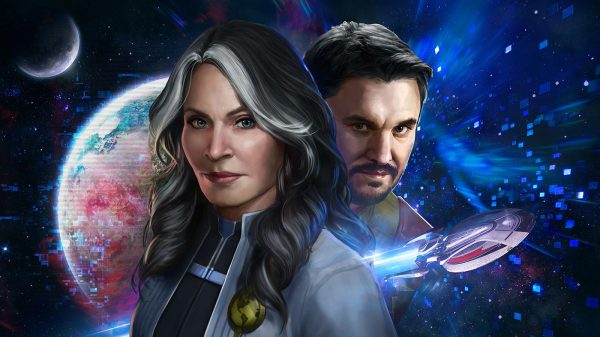
‘Star Trek Online’ lead designer talks the game’s longevity, honoring the franchise, and seeing his work come to life in ‘Picard’

Gates McFadden talks Star Trek: Picard, reuniting with her TNG castmates, InvestiGates, and the Human Condition

Connor Trinneer and Dominic Keating talk ‘Enterprise’, their relationship with Star Trek in 2023 and their first live ‘Shuttlepod Show’
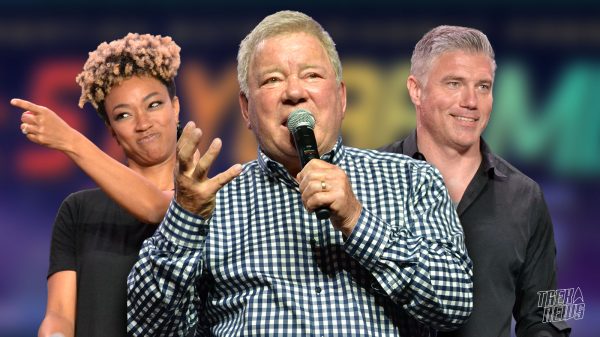
57-Year Mission set to beam 160+ Star Trek guests down to Las Vegas
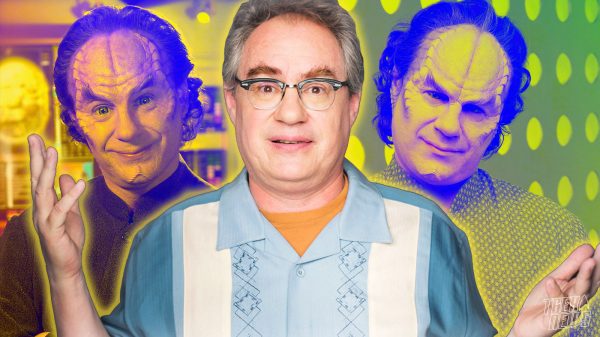
John Billingsley discusses what he’d want in a fifth season of Enterprise, playing Phlox and this weekend’s Trek Talks 2 event
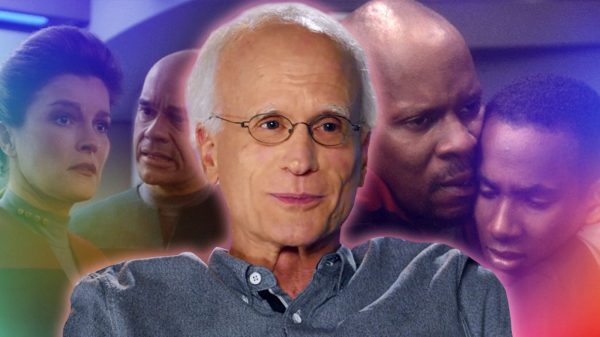
Veteran Star Trek director David Livingston looks back on his legendary career ahead of Trek Talks 2 event
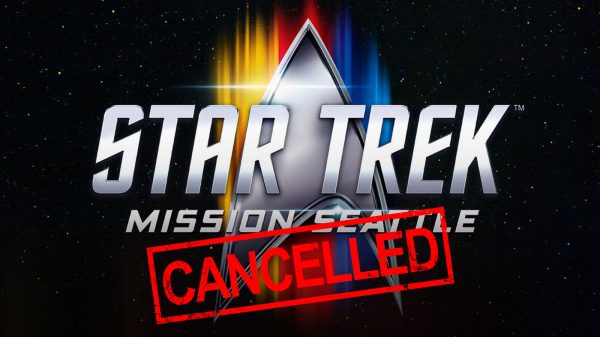
ReedPop’s Star Trek: Mission Seattle convention has been cancelled

56-Year Mission Preview: More than 130 Star Trek guests set to beam down to Las Vegas convention
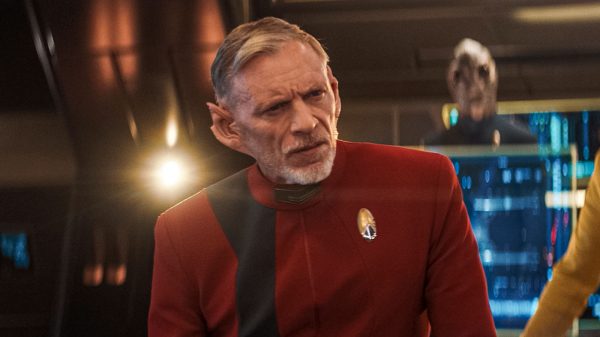
New photos + video preview from Star Trek: Discovery Season 5 Episode 5 “Mirrors”
![star trek space the last frontier 2023: A banner year for Star Trek — here’s why [Op-Ed]](https://treknews.net/wp-content/uploads/2024/01/star-trek-2023-year-in-review-600x337.jpg)
2023: A banner year for Star Trek — here’s why [Op-Ed]
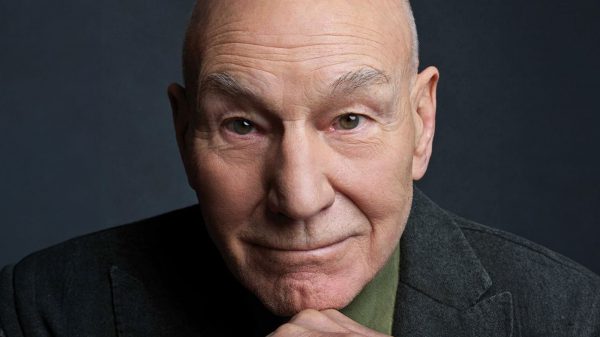
‘Making It So’ Review: Patrick Stewart’s journey from stage to starship
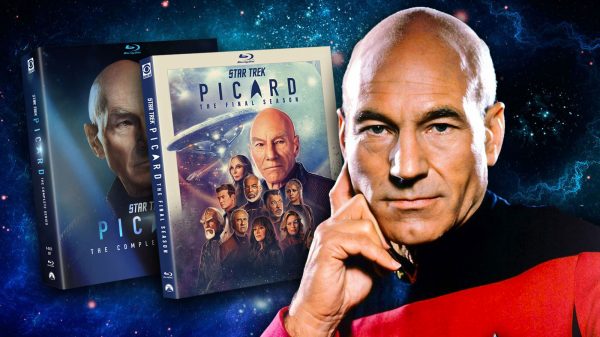
54-Disc Picard Legacy Collection, Star Trek: Picard Season 3, Complete Series Blu-ray box sets announced
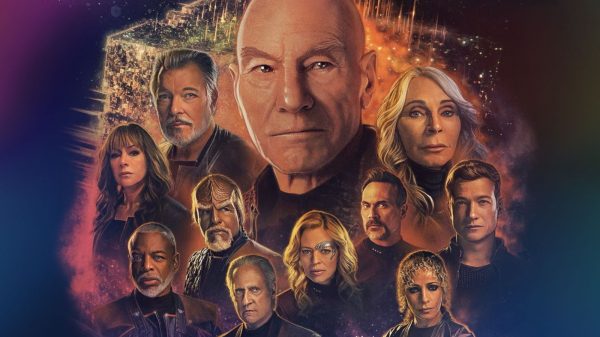
Star Trek: Picard series finale “The Last Generation” Review: A perfect sendoff to an unforgettable crew
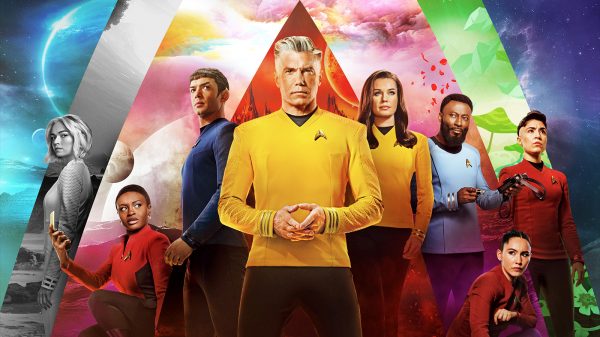
Star Trek: Strange New Worlds arrives on Blu-ray, 4K UHD and DVD this December
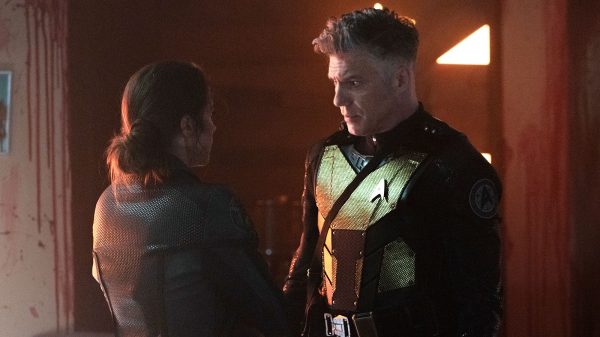
Star Trek: Strange New Worlds “Hegemony” Review: An underwhelming end to the series’ sophomore season
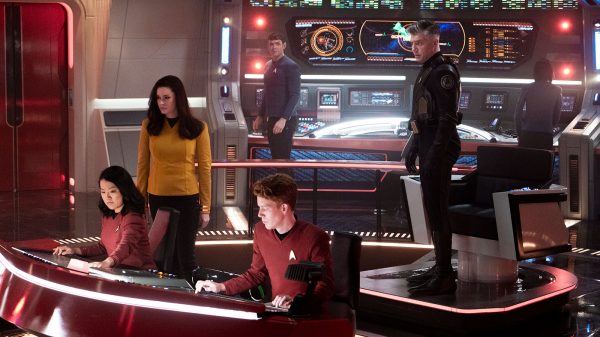
Star Trek: Strange New Worlds season 2 finale “Hegemony” preview + new photos
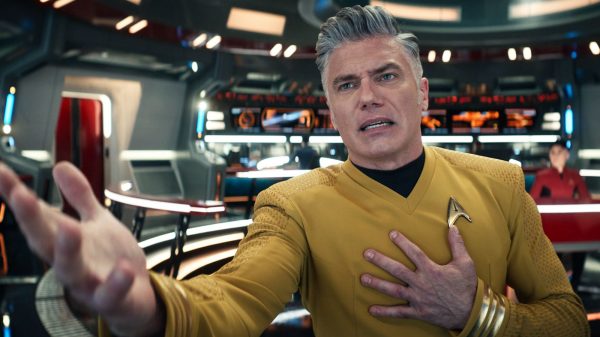
Star Trek: Strange New Worlds 209 “Subspace Rhapsody” Review: All systems stable… but why are we singing?
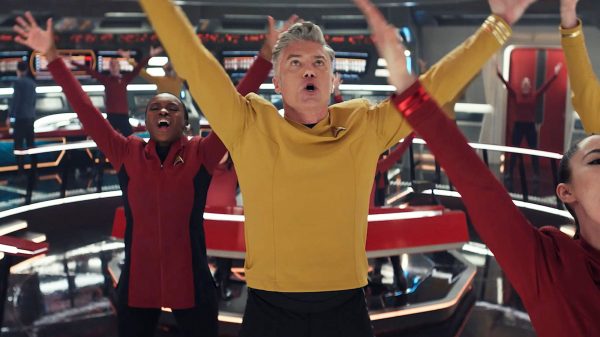
Star Trek: Strange New Worlds “Subspace Rhapsody” preview + new photos
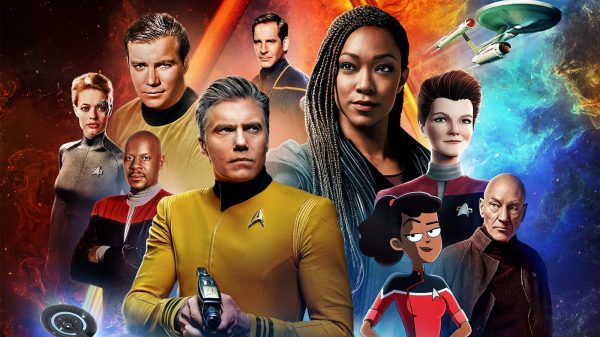
Star Trek Day 2021 to Celebrate 55th Anniversary of the Franchise on September 8 with Live Panels and Reveals

Paramount+ Launches with 1-Month Free Trial, Streaming Every Star Trek Episode
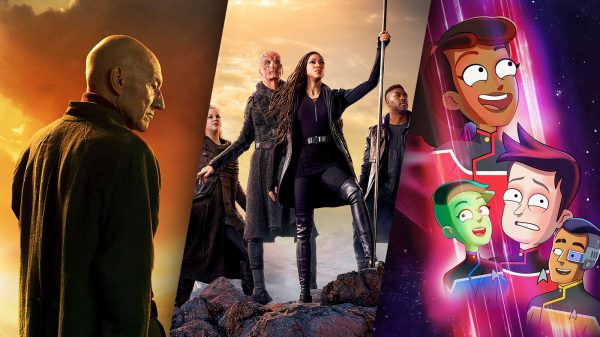
Paramount+ to Officially Launch March 4, Taking Place of CBS All Access
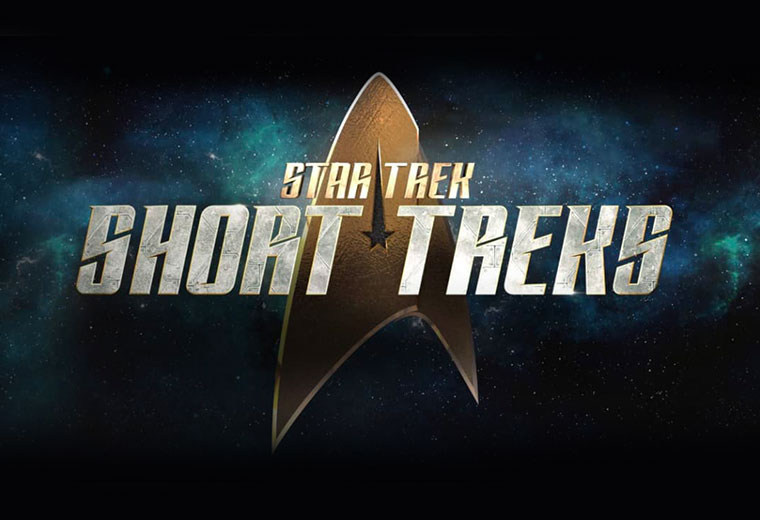
STAR TREK: SHORT TREKS Season 2 Now Streaming For Free (in the U.S.)
![star trek space the last frontier [REVIEW] STAR TREK: SHORT TREKS "Children of Mars": All Hands... Battlestations](https://treknews.net/wp-content/uploads/2020/01/review-star-trek-short-treks-children-of-mars.jpg)
[REVIEW] STAR TREK: SHORT TREKS “Children of Mars”: All Hands… Battle Stations
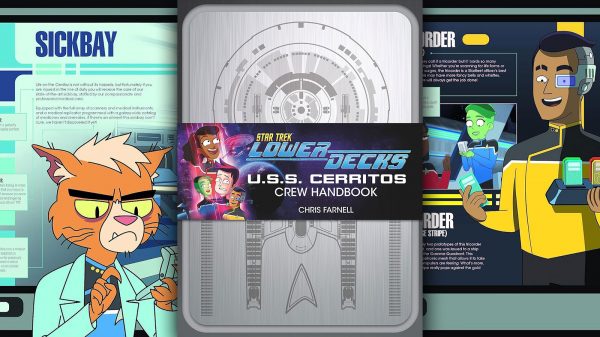
‘U.S.S. Cerritos Crew Handbook’ Review: A must-read Star Trek: Lower Decks fans
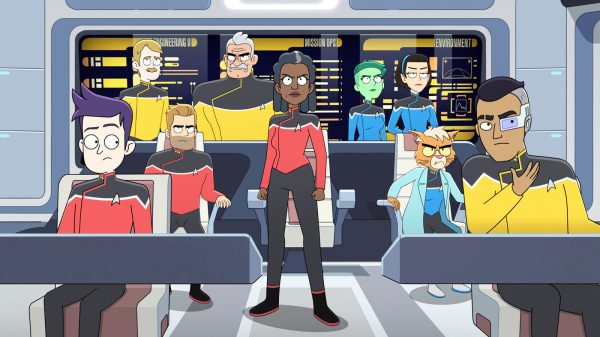
New photos from this week’s Star Trek: Lower Decks season 4 finale
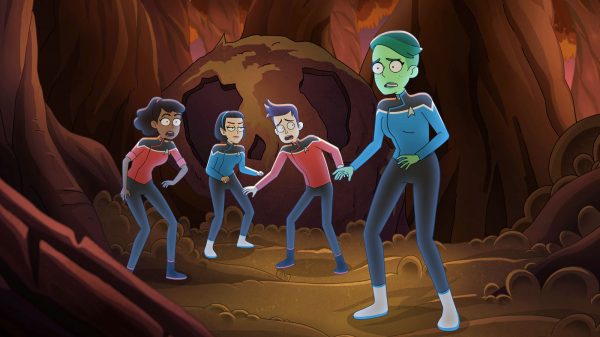
Star Trek: Lower Decks “The Inner Fight” Review: Lost stars and hidden battles
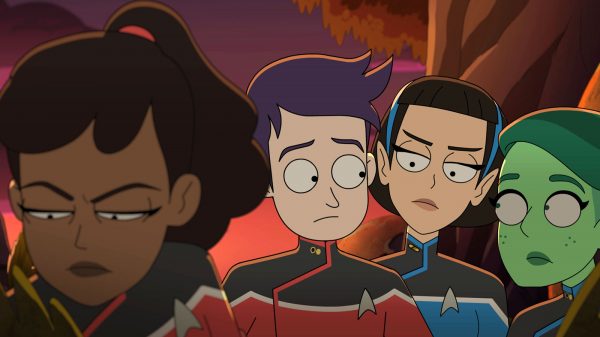
New photos from this week’s episode of Star Trek: Lower Decks
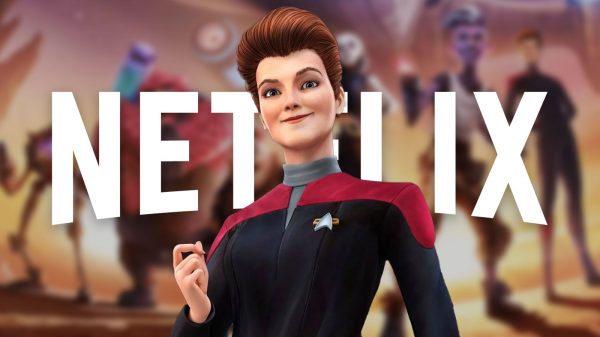
Star Trek: Prodigy begins streaming December 25th on Netflix
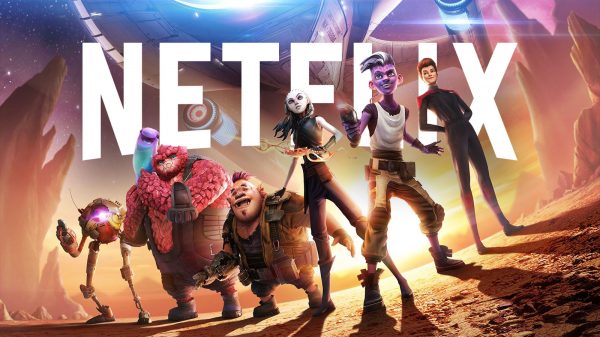
Star Trek: Prodigy lands at Netflix, season 2 coming in 2024
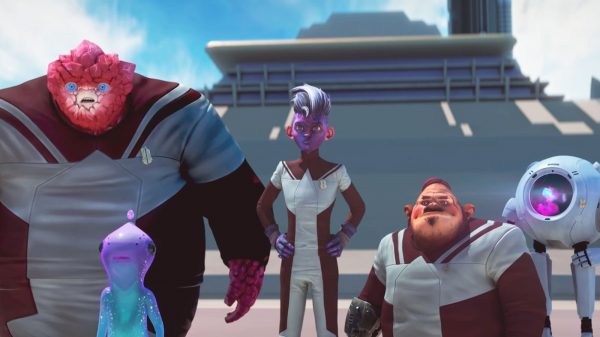
Star Trek: Prodigy Season 2 sneak peek reveals the surprise return of a Voyager castmember
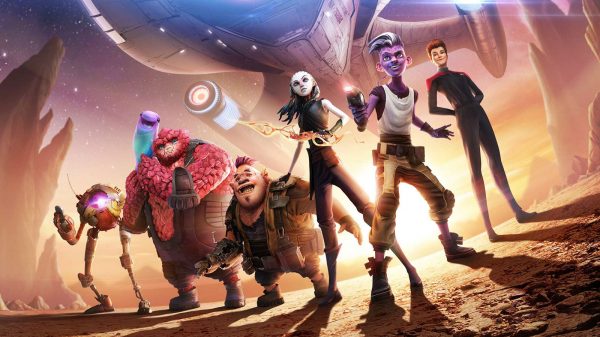
Star Trek: Prodigy canceled, first season to be removed from Paramount+
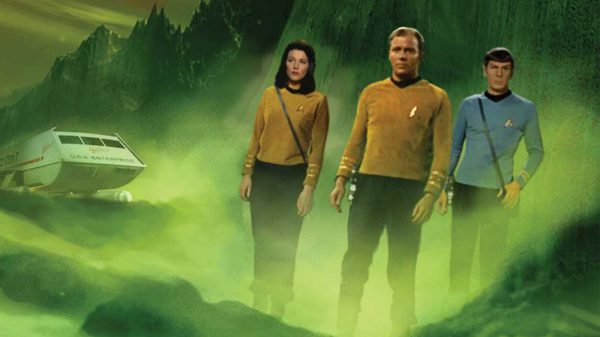
Revisiting “Star Trek: Legacies – Captain to Captain” Retro Review
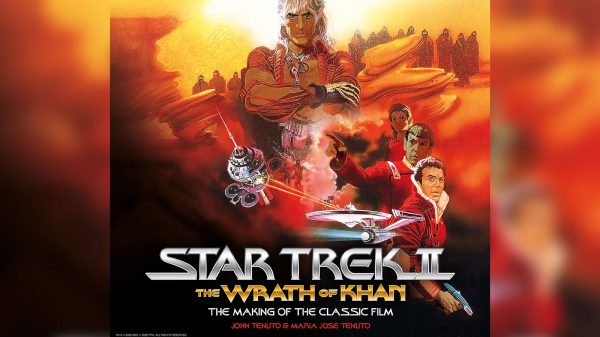
The Wrath of Khan – The Making of the Classic Film Review: A gem for your Star Trek reference collection
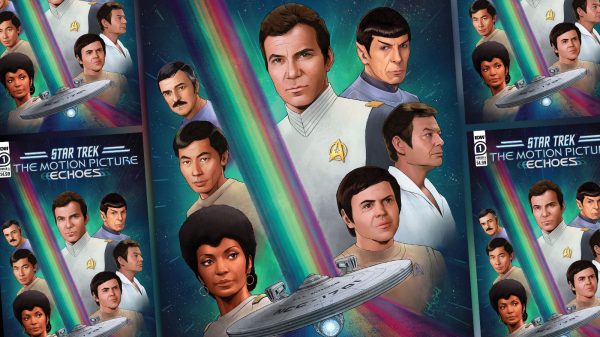
The events of Star Trek: The Motion Picture to continue in new IDW miniseries “Echoes”
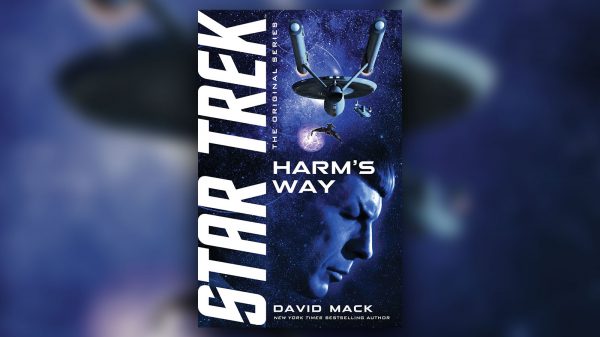
Star Trek: The Original Series “Harm’s Way” Book Review
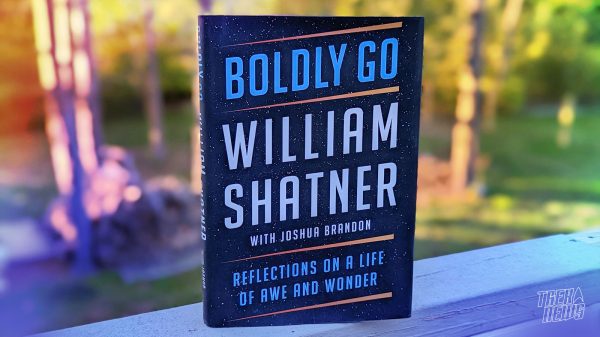
William Shatner’s New Book ‘Boldly Go: Reflections on a Life of Awe and Wonder’ Review: More of a good thing
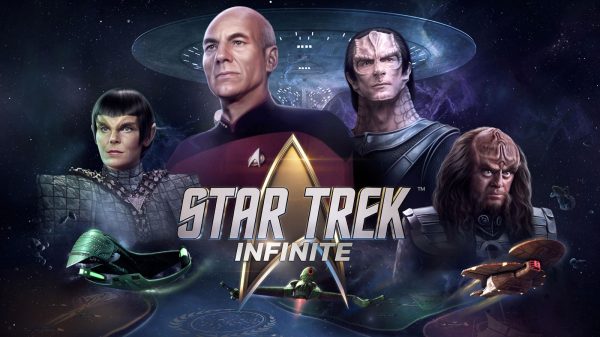
Star Trek: Infinite release date + details on Lower Decks-themed pre-order bonuses
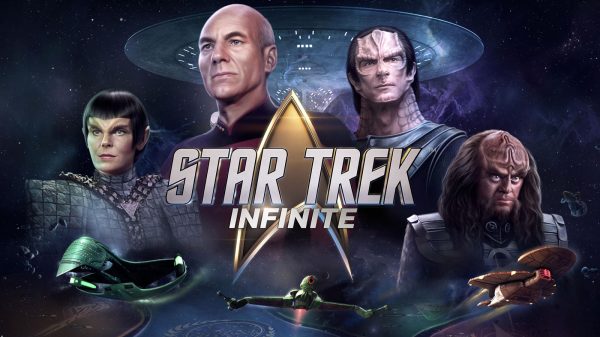
‘Star Trek: Infinite’ strategy game revealed, set to be released this fall
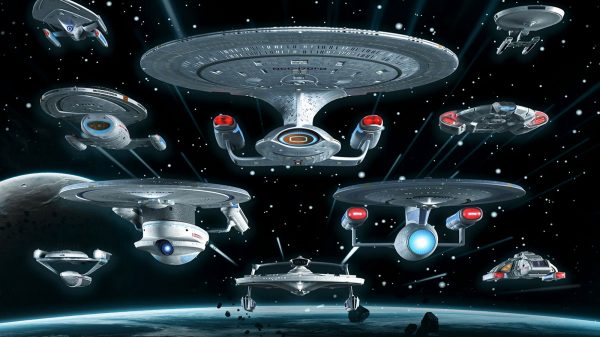
Hero Collector Revisits The Classics in New Starfleet Starships Essentials Collection
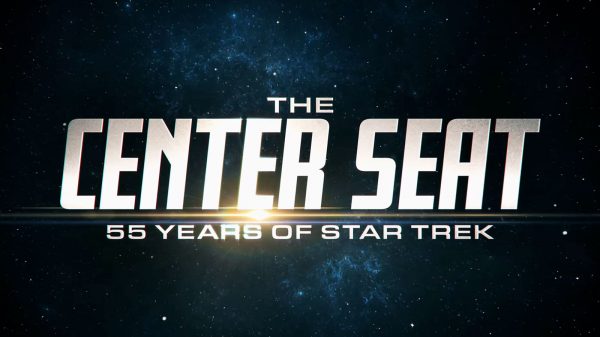
New Star Trek Docuseries ‘The Center Seat’ Announced, Coming This Fall
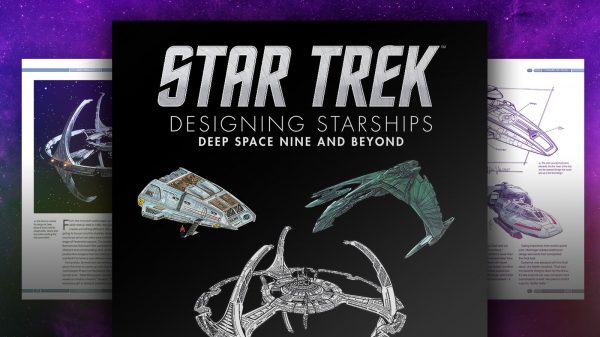
Star Trek Designing Starships: Deep Space Nine & Beyond Review: a Deep Dive Into Shuttlecraft of the Gamma Quadrant
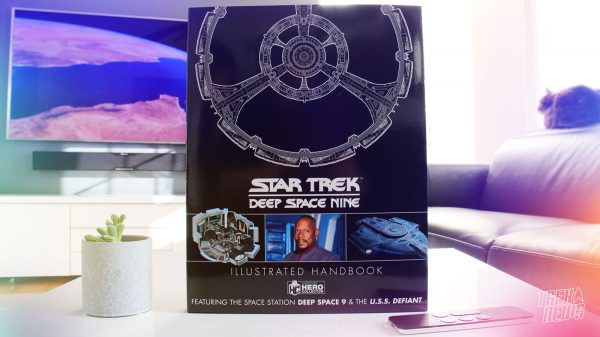
Star Trek: Deep Space Nine Illustrated Handbook Review: Terok Nor Deconstructed in Amazing Detail
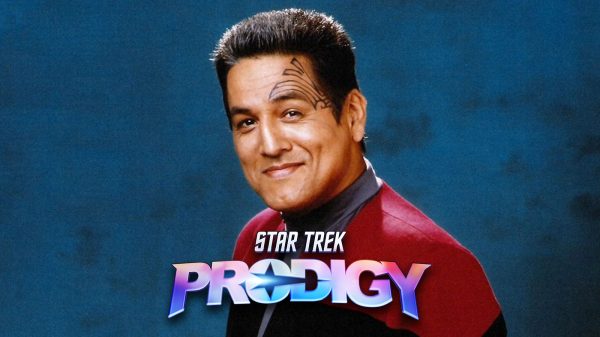
Robert Beltran Is Officially Returning to Star Trek as Chakotay on ‘Prodigy’ + More Casting News
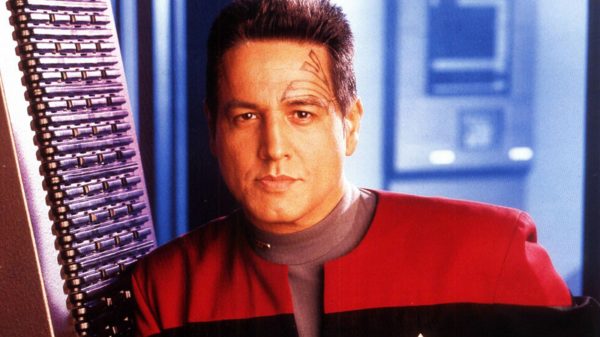
Robert Beltran Says He’s Returning to Star Trek in ‘Prodigy’

John Billingsley Talks Life Since Star Trek: Enterprise, Going to Space and Turning Down Lunch with Shatner and Nimoy
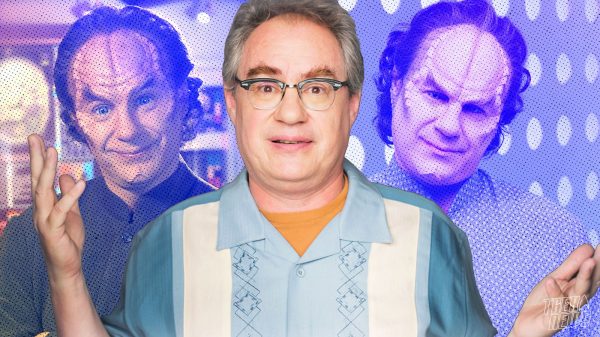
Star Trek: Enterprise Star John Billingsley Talks Charity Work, Upcoming TREK*Talks Event
Review: Star Trek: Discovery Season 5 Episode 5 “Mirrors”
Star Trek: Discovery picks up immediately where “ Face the Strange ” left off, as our protagonists track their quarry’s ship to a hidden, interdimensional pocket of space that holds a few surprises for them and the audience.
Thanks to some sciencing from Paul Stamets ( Anthony Rapp ) and Sylvia Tilly ( Mary Wiseman ), Captain Michael Burnham ( Sonequa Martin-Green ) has a way to find where Moll ( Eve Harlow ) and L’ak ( Elias Toufexis ) are. Apparently, there’s a wormhole hiding in plain sight near where Discovery lost track of the criminals’ warp signature.
This wormhole is too small for a Crossfield- class ship to fit through, so Burnham and Cleveland Booker ( David Ajala ) – the latter of whom is on a mission to rehabilitate Moll, if possible – take a shuttle and see what’s on the other side of the wormhole’s aperture. Find a surprise, they do indeed, as the I.S.S. Enterprise , the evil version of the heroic Starfleet ship, is nestled in the wormhole – albeit without its crew, which apparently evacuated the vessel at some point. It’s beaten to hell and serves as a refuge for Moll and L’ak, whose own ship was destroyed by the interdimensional pocket of space’s destructive environment.

Discovery writers sure can be sneaky! They’ve been foreshadowing the appearance of a Constitution -class for the last two episodes; remember when Gen Rhys ( Patrick Kwok-Choon ) and Commander Rayner ( Callum Keith Rennie ) both remarked the Connie was their favorite ship? As we’ll see, this isn’t the last bit of foreshadowing that comes true in this episode.
“How did it end up in interdimensional space?” “I don’t know. Must be one hell of a story.” – Book and Burnham upon seeing the I.S.S. Enterprise
Astute viewers will recognize an often-used cost-saving measure in the annals of Star Trek history: the reuse of sets from another concurrent show. (Seriously, rewatch TNG , DS9 , and Voyager and you’ll be surprised how often props and sets are reused between those shows.) As Burnham and Book explore various halls and rooms, including the bridge and sickbay, the familiar surroundings seen in Strange New Worlds are subtly transformed by Mirror Universe iconography. While nods to the iconic starship Enterprise are always appreciated, our initial reaction to this surprise location—admittedly tinged with pessimism—is that it’s of course it’s the Enterprise . A practical move, perhaps, to keep expenses in check. By Grabthar’s hammer… what a savings.
Finding the ship deserted sure is strange, and Burnham and Book ascertain Moll and L’ak are in sickbay, presumably with the next clue in the Progenitor puzzle. But first, the pair check out the transporter room, which holds some strange items, such as blankets, children’s toys, and a locket that holds a picture of two people, which Burnham inexplicably decides to take with her. Moreover, the dedication plaque of the I.S.S Enterprise tells the story of the ship and its crew: the Terran Universe emperor seemingly tried to make changes to the way things were done in that evil universe, and the Enterprise escaped and picked up refugees who were trying to flee the Terran Universe and enter the Prime Universe.
One of the leaders among those on the Enterprise was a Kelpien, who Burnham deduces must have been the Mirror Universe version of Saru, and that the crew must have fled the Enterprise once it got stuck in the interdimensional pocket of space. Is it just us, or does this sound like a potential episode of Strange New Worlds ?
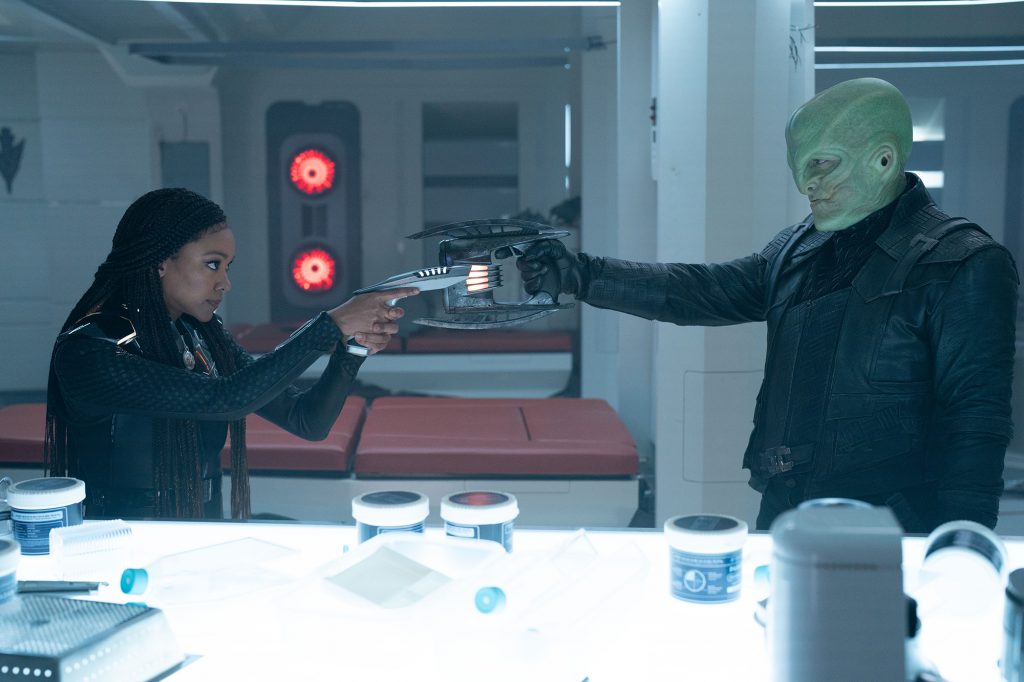
Burnham, Book, Moll, and L’ak face off in sickbay, where Burnham makes a startling connection between L’ak and a particular dilemma he is facing. The criminal pair hope to use the Progenitor treasure to clear L’ak’s Breen blood bounty. Yes, L’ak is Breen, that enigmatic and masked species from Deep Space Nine . Neato!
The rest of the episode bounces between what’s happening on the Enterprise , and flashing back to how Moll and L’ak first met and became romantically involved. Moll, the courier, would do business on the Breen space station on which L’ak, a member of a royal Breen family, was posted. The two connected over L’ak’s recent demotion and efforts to fight the embarrassment that came with it.
Over some time, the two became nearly inseparable, and L’ak even took the bold step with Moll by showing her his face – a big deal in Breen culture, as keeping their masks on allows them to retain their true, semi-transparent form, and not the solidified appearance we’ve seen on L’ak. Their relationship is tested when L’ak’s superior (and uncle), Primarch Ruhn ( Tony Nappo ) decides to interrupt their courtship. L’ak doesn’t take kindly to being asked to kill Moll, so the Breen turns on his own people, earns a Breen blood bounty, and flees with Moll. The pair now share a goal: earn enough latinum to retire on an (unnamed) fabled planet somewhere in the Gamma Quadrant, free from the trials and hardships of the courier life.
Suffice it to say, “Mirrors” is most memorable because it casts a welcome light on the shadowed backstory of this season’s main villains. Moll and L’ak are now a relatable pair, star-crossed lovers who are hell-bent on earning themselves a happy ending. As much as we don’t want to see the Progenitors’ tech get into the wrong hands, who now doesn’t want to see everything work out for Moll and L’ak?
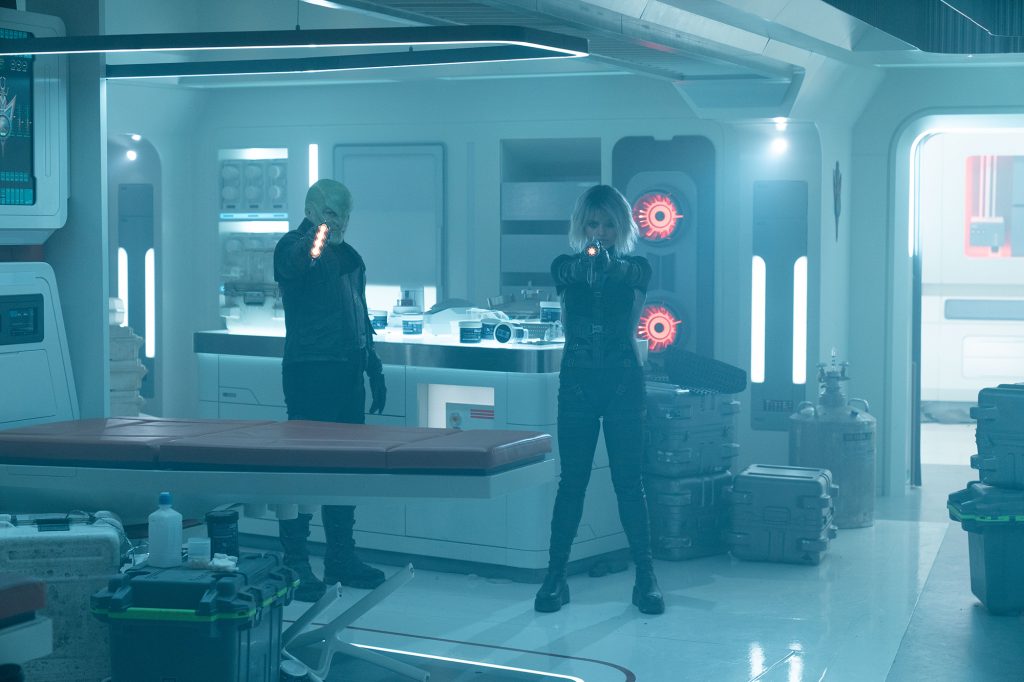
Anyway, the quartet still need to get off the Enterprise , but the shuttle on which Burnham and Book arrived is destroyed by the turbulent pocket of space. With mere minutes to spare before the Enterprise is destroyed by the wormhole’s tiny aperture, Book and Moll share some last-minute words about their shared relationship with the late Cleveland Booker, and how Book hopes Moll makes the right choices regarding her quest for the Progenitor tech. Burnham, meanwhile, engages in a melee with L’ak, and the Breen ends up injured and inadvertently relinquishes control to Burnham of the next map piece in the Progenitor puzzle. The courier and disgraced Breen end up escaping the ship in a convenient Terran warp pod, leaving the chase between our heroes and enemies for another day.
“If we hit it precisely with a sequential hexagonal pattern, it should stay open for approximately sixty seconds. But once it collapses, it’s gone for good.” “Why hexagonal?” “Doesn’t matter… it’ll work.” – Adira ( Blu del Barrio ), Rayner, and Stamets as the crew finds a way to get the wormhole aperture bigger. We think this line from Stamets is reflective of the evolving working relationship between the results-orientated Rayner and the crew, and how this relationship is getting better the longer Rayner is first officer.
Burnham devises a novel way to signal her first officer for help in getting the Enterprise through the aperture: a pulsing tractor beam emitting from the Enterprise , shot through the wormhole’s opening, in a numerical sequence featured in a famous play from Kellerun culture. Rayner is then able to lead his crew to devise a way to pull the Enterprise into normal space.
The sequence where Rayner is faced with command of a ship tasked with the near-impossible rescue of his captain is the best of the episode. It’s no secret Rayner was knocked down a few pegs after his demotion and reassignment to Discovery , but that lack of confidence and inner angst is demolished thanks to Rayner listening and working with his bridge crew to save the Enterprise . Plenty of lesser-known bridge officers get a say in how Discovery could help the Mirror ship, and lightning-fast decision-making shows Rayner back on his game.
The last element to note about this episode is some emotional trouble Doctor Hugh Culber ( Wilson Cruz ) is having. Tilly provides an outlet for this angst. Culber explains the experiences he’s had in the last few years – namely dying, coming back to life, and being a Trill host – really put into perspective the intellectual journey he is on in the face of the Progenitor’s quest. Tilly helps him realize he isn’t only experiencing an intellectual quest, but a spiritual one. This conversation is just another instance of Discovery setting up some wild expectations for what the crew might ultimately discover at the end of the season – something beyond the bounds of science, perhaps?
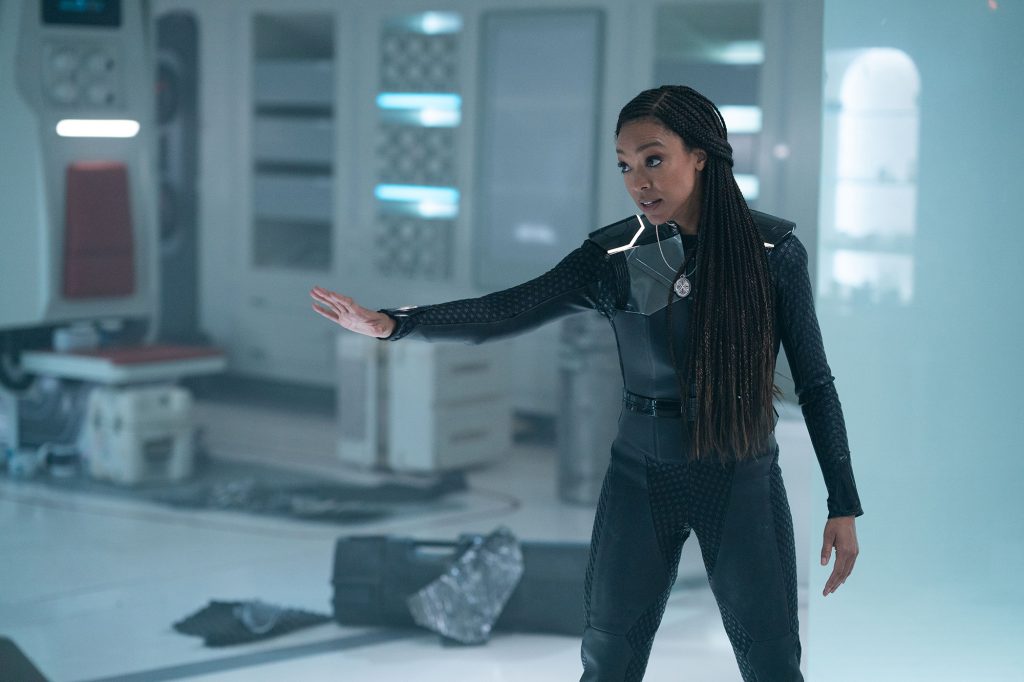
Even though their prey gets away again, Burnham and her crew have the next clue in the Progenitor puzzle, and it is hiding in the I.S.S. Enterprise ’s sickbay. Hidden in the map piece Burnham grabbed from L’ak is a vial, which Stamets will analyze soon. Burnham learns the crew who escaped from the I.S.S. Enterprise ended up in the Prime Universe and were able to start new lives. A Terran scientist aboard the Enterprise , Dr. Cho, ended up being a branch admiral, and we’re meant to assume she was one of the scientists on Dr. Vellek’s team hundreds of years ago as they studied the Progenitor tech. Dr. Cho then hid her piece of the Progenitor puzzle aboard her old ship as a symbolic gesture of her ability to find freedom in a new universe.
Discovery continues its final season with another thumbs-up episode that serves an important lore-building role in the franchise. Seeing the Breen again is a joy, especially since we were staring at one the whole time and never knew it. And how striking was that Breen space station where L’ak was based? Another important note for Star Trek historians is that now the Mirror Universe Enterprise is in the 32 nd century, and stationed near Earth thanks to Joann Owosekun and Keyla Detmer piloting the ship back to Federation space. Will we see that ship again this season?
As the Progenitor puzzle deepens, so do the emotional stakes for our crew, exemplified by Culber’s introspective journey, the subtle reignition of Book and Burnham’s relationship, and Rayner’s triumphant return to leadership. We’re now at the halfway point in this season, so there’s still plenty of time for surprises, emotional consequences, and expectation-setting for this eagerly awaited treasure.
Stray Thoughts:
- Hopefully, you’re watching this episode with subtitles on, because goodness is it hard to hear what masked Breen says.
- The Mirror Universe version of the U.S.S. Enterprise was last seen in the Original Series episode “Mirror, Mirror,” albeit this wasn’t the Strange New Worlds version of the ship. Likewise, the Terran version of Spock, whom Booker asks if Burnham ever met, was in that same episode.
- How did Adira conclude they were the one who brought the time bug aboard Discovery ?
- Why didn’t Burnham and Book try talking down Moll and L’ak before diving into the room with the holo-projected doubles?
New episodes of Star Trek: Discovery stream Thursdays on Paramount+ , this season stars Sonequa Martin-Green (Captain Michael Burnham), Doug Jones (Saru), Anthony Rapp (Paul Stamets), Mary Wiseman (Sylvia Tilly), Wilson Cruz (Dr. Hugh Culber), David Ajala (Cleveland “Book” Booker), Blu del Barrio (Adira) and Callum Keith Rennie (Rayner). Season five also features recurring guest stars Elias Toufexis (L’ak) and Eve Harlow (Moll).
Stay tuned to TrekNews.net for all the latest news on Star Trek: Discovery , Star Trek: Prodigy , Star Trek: Strange New Worlds , Star Trek: Lower Decks , and more.
You can follow us on X , Facebook , and Instagram .

Kyle Hadyniak has been a lifelong Star Trek fan, and isn't ashamed to admit that Star Trek V: The Final Frontier and Star Trek: Nemesis are his favorite Star Trek movies. You can follow Kyle on Twitter @khady93 .

Your email address will not be published. Required fields are marked *
Trending Articles
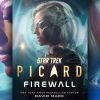
Review: Star Trek: Picard – Firewall Seven of Nine, a heroine who has resurged in popularity thanks to Jeri Ryan’s return to the franchise...

An article celebrating the longevity of the Star Trek franchise has given us our first look at Michelle Yeoh’s upcoming Star Trek: Section 31...
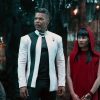
Star Trek: Discovery Season 5 stumbles with “Jinaal” Discovery’s voyage to the ultimate treasure brings Captain Michael Burnham and her crew to Trill, where...
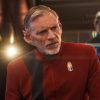
Preview: Star Trek: Discovery 505 “Mirrors” The fifth episode of Star Trek: Discovery’s fifth and final season “Mirrors” premieres this Thursday, April 25. The...
- Download Game
- Military Program
- Events Calendar
- Refer a Friend
- Newcomer's Guide
- General Guide
- Game Economics
- Account Security
- Achievements
- Fair Play Policy
- Wargaming.net Game Center
- Twitch Drops Guide
- Clan Portal
- Clan Ratings
- Tournaments
- Search Players
- Community Contributors
- Failed to log in. Log in or create account
- My Profile Log out
Call to the Final Frontier
Recruit iconic characters, ride your rover into the mission area, get rewarded by starfleet.

Get More Orion Lockboxes
Meet new armored vehicles, scan the "emissary" 3d style, get even more unique star trek -themed customization items.
- Player Support
- Report Content/Request Data
- Privacy Policy
- Europe (English)
North and South America:


IMAGES
VIDEO
COMMENTS
The phrase was originally said by Captain James T. Kirk (William Shatner) in the original Star Trek series. "Where no man has gone before" is a phrase made popular through its use in the title sequence of the original 1966-1969 Star Trek science fiction television series, describing the mission of the starship Enterprise.The complete introductory speech, spoken by William Shatner as Captain ...
"Space, the final frontier": Star Trek and the national space rhetoric of Eisenhower, Kennedy, and NASA by Glen E. Swanson Monday, April 20, 2020 ... A little more than six weeks after the last episode of Star Trek aired, Kennedy's goal of landing a man on the Moon before the end of the decade became a reality when the crew of Apollo 11 ...
From Star Trek TOS: Space: the final frontier. These are the voyages of the starship Enterprise. Its five-year mission: to explore strange new worlds, to seek out new life and new civilizations, to boldly go where no man has gone before. and from Star Trek TNG: Space: the final frontier. These are the voyages of the starship Enterprise.
Star Trek #19 is written by Jackson Lanzing and Collin Kelly and drawn by Megan Levens. T'Lir, the enigmatic Vulcan, has been revealed to be the last of the Organians and has charged Sisko and ...
Star Trek V: The Final Frontier: Directed by William Shatner. With William Shatner, Leonard Nimoy, DeForest Kelley, James Doohan. Captain Kirk and his crew must deal with Mr. Spock's long-lost half-brother who hijacks the Enterprise for an obsessive search for God at the center of the galaxy.
This introductory text was spoken at the beginning of many Star Trek television episodes and films: Space: The final frontier. These are the voyages of the Starship, Enterprise. Its 5 year mission. To explore strange new worlds. To seek out new life and new civilizations. To boldly go where no man has gone before.
"The greatest enterprise of all is adventure." When a renegade Vulcan captures the Federation, Klingon, and Romulan ambassadors on Nimbus III, the so-called "planet of galactic peace," it can only mean one thing: the vacation is over. Captain James T. Kirk and the crew of the new Starship Enterprise-A are pressed back into service to come to the rescue. But, when the Vulcan has a prior ...
By Thomas Bacon. Published Dec 13, 2022. Star Trek has always seen space as the final frontier, but this no longer seems to be the case - with the multiverse becoming more important instead. The multiverse has replaced space as Star Trek 's final frontier. Star Trek 's opening monologue is undoubtedly one of the most famous in history.
A release shared by AP News announced that William Shatner, who played Captain Kirk, will boldly go into space. And, a day delayed, on October 13, the actor who made the starship captain famous ...
Here it is, on a scale of 1-10. There's something inherently pretentious about space travel, and calling it "the final frontier" makes it kind of even more pretentious. We all know what happened to American Indians when settlers started exploring that frontier. Martians, beware. Space, the final frontier. Get all the details, meaning, context ...
Star Trek V: The Final Frontier is a 1989 American science fiction film directed by William Shatner and based on the television series Star Trek created by Gene Roddenberry.It is the fifth installment in the Star Trek film series, and takes place shortly after the events of Star Trek IV: The Voyage Home (1986). Its plot follows the crew of the USS Enterprise-A as they confront renegade Vulcan ...
21 July 2016. Fifty years ago Captain Kirk and the crew of the starship Enterprise began their journey into space — the final frontier. Now, as the newest Star Trek film hits cinemas, the NASA/ESA Hubble Space Telescope is also exploring new frontiers, observing distant galaxies in the galaxy cluster Abell S1063 as part of the Frontier Fields ...
Summary: Fifty years ago Captain Kirk and the crew of the starship Enterprise began their journey into space -- the final frontier. Now, as the newest Star Trek film hits cinemas, the NASA/ESA ...
Star Trek Opening Lyrics: Space, the final frontier / These are the voyages of the Starship Enterprise / Its five year mission / To explore strange new worlds / To seek out new life / And new ...
The film really falls down with its special effects. Simply put, they're dreadful. There's no other word for them. Robbed of ILM's assistance, (they were busy working on an Indy movie and ...
Thank you so much for inspiring so many, Leonard Nimoy. May you rest in peace. Sound clip taken from the Star Trek II: The Wrath of Khan soundtrack, "Epilo...
The result was SPACE The New Frontier, a heavily illustrated 50-page publication that proved so popular when it first appeared in 1962 that NASA published it multiple times over the next four years. ... Prior to the airing of the last Star Trek episode on June 3, the series had been sold into syndication to Kaiser Broadcasting, which owned a ...
Star Trek V: The Final Frontier opened on June 9, 1989 -- or 25 years ago today. The film, directed by William Shatner, remains as polarizing as ever all these years later. In it, Sybok, an emotional Vulcan, and his followers take hostages on Nimbus III, the so-called Planet of Galactic Peace. Sybok intends to locate God, and his plan is simple ...
With Star Trek's 55th anniversary coming up, I had the idea to create a montage of sorts of the classic opening monologue. Unfortunately, my limited editing ...
Aug 21, 2018. This film is the fifth film of the franchise and addresses, in the worst way, a spiritual theme: the search for God. The whole script is based on an unsuccessful space travel in search of the creator of all things. When a script starts from a bad idea it is lost, and this case proves this theory.
Here's why Picard is making time more important in Star Trek. Star Trek: Picard season 2 will focus on time travel because, as Jean-Puc Picard (Patrick Stewart) himself declared, time is Star Trek 's true final frontier. Picard and his motley crew, including Seven of Nine (Jeri Ryan), Soji (Isa Briones), and Raffi Musiker (Michelle Hurd ...
21 July 2016. Fifty years ago Captain Kirk and the crew of the starship Enterprise began their journey into space - the final frontier. Now, as the newest Star Trek film hits cinemas, the NASA/ESA Hubble space telescope is also exploring new frontiers, observing distant galaxies in the galaxy cluster Abell S1063 as part of the Frontier Fields ...
Final frontier: 'Star Trek: Nemesis' marked the end of an era 20 years ago today. Overshadowed by competition and often unloved by fans, "Star Trek: Nemesis" celebrates its 20th birthday today as ...
(The species has appeared in Star Trek: Lower Decks three times.) The 32nd century Breen wear updated encounter suits clearly based on the designs introduced in Deep Space Nine; their digital speech is extremely faithful to the incomprehensible noises Breen soldiers have spoken in past appearances.
Star Trek Suite 2: https://www.youtube.com/watch?v=G5ZT1daKZSoThis is an extended update to the original Mega Suite 1, found here: https://www.youtube.com/wa...
Review: Star Trek: Discovery Season 5 Episode 5 "Mirrors" Star Trek: Discovery picks up immediately where "Face the Strange" left off, as our protagonists track their quarry's ship to a ...
World of Tanks